new posts in all blogs
Viewing: Blog Posts Tagged with: Tips, Most Recent at Top [Help]
Results 26 - 50 of 379
How to use this Page
You are viewing the most recent posts tagged with the words: Tips in the JacketFlap blog reader. What is a tag? Think of a tag as a keyword or category label. Tags can both help you find posts on JacketFlap.com as well as provide an easy way for you to "remember" and classify posts for later recall. Try adding a tag yourself by clicking "Add a tag" below a post's header. Scroll down through the list of Recent Posts in the left column and click on a post title that sounds interesting. You can view all posts from a specific blog by clicking the Blog name in the right column, or you can click a 'More Posts from this Blog' link in any individual post.
One of the problems with regular blogging is that you sometimes feel like every single post should be breathtaking, new, insightful, and most of all exciting. But, truly, none of us has anything new or exciting to say. Maybe different ways to say the same thing. Or new-to-us insights into the same old material. Disclaimer: this is one of those mundane posts that may not have anything new to say, but perhaps it at least offers a new twist on the same old stuff.
Random Thought #1: Strategies for first draft writing come in all different sizes. Some like outlines, some prefer complete plot diagrams, some are pantsers (writing by the seat of your pants). I'm usually a pantser. I frequently know where I'm starting and where I'd like to end up, and maybe a few scenes in the middle, but beyond that, my first drafts are where I discover how I'm going to get from start to finish. I have a lot of fun with rough drafts, even though it's agonizing to create something out of nothing. Here's one thing I've discovered that helps me keep the momentum going--I stop writing before the scene or chapter is over. I send the character into the midst of the problem of the moment, build the tension, and then leave the character there while I go make dinner or whatever. A lot of my writing takes place in the synapses of my brain while I'm doing other stuff, so I let the character be in trouble for a day or two or three and when I come back to the writing, often the character has figured out a great maneuver or solution. I can write that scene, which moves me into the next one, and then I leave the character hanging off the edge of the cliff for a while again.
Random Thought #2: Things not to say to writers. Most of you reading this are writers, so if you'd like to cut and paste this section into an email to all your family and friends, you have my blessing.
- "That's cute." No, cute isn't what I was going for. I don't do cute. So "cute" to me just means you're not getting what I'm writing. Or else you're illiterate and have no idea what you read. Or maybe you didn't really read it at all. Typically for me, the people who describe what I've written as cute are, in this order: 1) my mother, and 2) any of my mother's friends. So I don't show them my writing anymore. It is now my policy that anyone who calls my writing "cute" will never again have the privilege of reading it.
- "How's your great American novel coming?" I hate this for several reasons. First, it implies that I am ignorant of the publishing industry and I think my novel is the ONE and ONLY important piece of literature of my age. Second, it assumes that I have only one novel in me, ignoring the many others I have already written. Also, it suggests that I'm never really going to finish this thing (despite the fact that I have already completed others), because I'm not really working at it, nor do I really have any serious intent of writing professionally.
- "I like it." Okay, I know, we all like to hear this--once the thing is published and public. But until then, if I'm sharing my writing with you, it's because I want your feedback, your critique. When you have nothing useful to say, I know you aren't a helpful critiquer, which means, again, that I probably won't be sharing with you anymore. I need critique, by golly, not admiration. I'll call you when the book is for sale, since I know you'll "like it."
Random Thought #3: Why do others want characters to act consistently? People aren't consistent, are we? Nobody I know is consistent. Sure, someone might highly value honesty, say, but they sometimes fudge the truth or tell a "white lie," rationalizing it by saying it spares the feelings of others. I know some people who are definitely one persona when out in public and quite another when they're at home. I think the secret of writing characters who aren't consistent is to make sure the inconsistency doesn't appear just at the moment of highest tension or just jump up when it suits the situation. You have to build the character's inconsistency into the persona and voice of that character from the beginning of the book, so that when the moment comes for that inconsistency to rear its ugly head, it is not a surprise to the reader. Plus, most of us here are children's writers, and kids are constantly changing--sometimes for the better, but not always. So the characters in kid lit should be, I think, inconsistent too. It's a way for them to learn about themselves, see ways that the characters grow, and contemplate their own path.
There you have it--all the wisdom floating around in my brain today. Well, I do have lots of other wisdom about all kinds of other things, but I don't think you want to here that right now.
by Neysa CM Jensen
up in Boise, Idaho
.jpeg?picon=3498)
By: Cait,
on 12/4/2014
Blog:
Cait's Write...
(
Login to Add to MyJacketFlap)
JacketFlap tags:
off season training,
tips,
running,
motivation,
art,
goals,
training,
track,
races,
Add a tag
When you close your eyes, may you dream of lanes, miles, and splits.
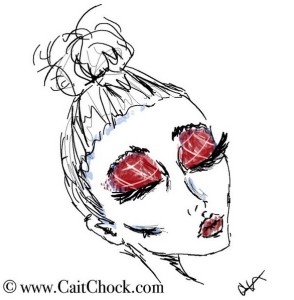
It’s never too early to dream of track, or any running goals for that matter. But at a time in the season where your next race may night be quite close enough to ‘taste’…the motivation to brave the elements (Hello, Winter, I was over you last month.) can wane for some runners.
I often take the snarky, or sarcastic, side to life, even when it comes to a ‘kind’ kick in the right direction. Here are some ways I suggest keeping yourself consistent until it IS close enough to ‘taste’ your next race.
1) That Runner Guilt Factor: I’ll be totally honest, this is usually my BEST way to combat a motivation lull. I remind myself that skipping a run usually is not worth feeling that ‘runner guilt’ later. No joke, you know it’s not fun going to bed tossing and turning because you caved to an instance of laziness.
2) The Endorphin Factor: Close to the above, I also remind myself that even if I feel tired/sluggish and the last thing I want to do is run…that usually changes after the first 5 minutes or mile. Once you get into the run those endorphins kick in, and I’ve never finished and thought, “Wow, I really wish I woulda just kicked it on the couch.”
3) Play Antagonizer: Mental dialogue, “C’mon, don’t be a weenie. Suck it the heck up, lace it up.”
4) The Buddy System: When in doubt, call a friend, arrange a run, join a group, social media that you ARE going for a run. That way if you back out, you’ve got to deal with the ‘Tweet of shame’ later. Good peer pressure and all that jazz.
5) Training Program: If you’re training to PR, I have to say I honestly recommend you have a coach, or are knowledgeable enough yourself to coach yourself. But self coaching is HARD…and it’s a lot easier to not have to ‘think’ about your training. That way, you have someone to tell you what to do, BAM, your job is just to run. Trust me, running is hard business, taking some things off your plate is nice. Plus, if your coach gives you the workout, no arguments, lace it up, Buddy!
6) Dream of Goals: Even if race day IS far away, write it down and know your goals. Like the picture above, if you VISUALIZE what you want and put it OUT THERE, it makes things feel more ‘real’ and you know what you’re working towards. It’s harder to blow off a written goal, one you dream about, right? Methinks yes.
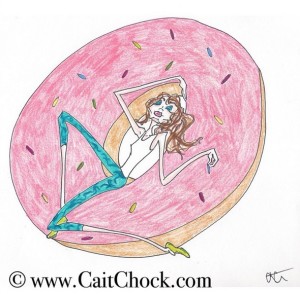
7) Bribery: It’ll get you everywhere. Bribe yourself with new running gear, think about dessert, splurge on some cool new shoes, dream of pancakes on your run, create a cool playlist…whatever. When it doubt, donut it out…you just have to run first. 
8) Identity: Okay, some people may be all judgmental and say you shouldn’t DEFINE yourself as a runner…but I’ll be honest, a big part of who I am (or at least the parts I tend to like the most! haha) is that I’m a runner. It’s not just a passion of mine, but it’s a way I connect with people, my friends, and a mentality. I know if I’ve run for the day I feel better and am a happier individual. So race or no race, get my miles on.
9) Money in the Bank: Think of all these miles and workouts as money in the bank. The stronger you are going into the ‘meat’ of the season the better you’ll race. Doesn’t that sound logical? Picture your competitors, who do you think will do better come race day, the ones gettin’ ‘er did, or the sofa’ing ‘er did? The uglier the day/workout, the more excited you should be when you tackle it…it’s making you that much tougher.
10) Superiority: Remember that runners are just better. So go run, don’t you want to be part of the cool kids? 
Snark, goals, tough love to yourself…whatever it takes. Dream of miles, and remember you HAVE the support of the entire (awesome) runner community to give you a motivation boost when you need it.


By: Kathy Temean,
on 12/1/2014
Blog:
Writing and Illustrating
(
Login to Add to MyJacketFlap)
JacketFlap tags:
Tips,
Writing Tips,
Advice,
video,
Process,
How to,
demystify,
Dan Wells,
Free Writing Videos,
Seven Step Story Structure,
Add a tag
Seven Point System
To build a story you must have a story in mind. Plot – characters – conflict. Before you start to layout your plan for that book Dan Wells tells us, don’t start at the beginning, but start at the end. This is not the last chapter. It is the climax. Figure out the external conflict and internal conflict.
Once that is done then go to the other end, the beginning and start. Normally a good book will take a weak or flawed character on a journey that ends with them growing in some way. By the end, they are a better or stronger person because of their journey. I’ve heard Richard Peck tell writer that he always rewrites the first chapter after he is finished the first draft. He says you can’t know where to start until you figure out how the story ends. He is doing the same things as what Dan is suggesting, except Dan is trying to save you from having to rewrite the first chapter.
This system can be applied to almost any writing, including short stories and novellas.
Here are the notes I wrote while watching the videos below:
The Seven Points:
Hook – Starting state loser – weak – flawed.
Plot Turn 1: Introduces conflict. Just as the midpoint moves you from the beginning to end, Plot Turn 1 moves you from the beginning to midpoint. Call to adventure. Introduces the conflict. The character’s world changes: Meets new people – discovers new secrets – follows the White Rabbit.
Pinch 1: Applies pressure – something goes wrong – bad guys attack and the MC is forced to go forward – often used to introduce the villain.
Midpoint: Learns the truth. This is wear the MC changes from reaction to action.
Pinch 2: Applies more pressure until the situation seems hopeless. A plan fails – a mentor dies, leaves the hero alone – the bad guys seem to win. These are the jaws of defeat from which your hero will be snatching victory. Make sure the teeth are sharp.
Plot Turn 2: Moves the story from the midpoint to the end. At the midpoint your MC is determined to do something, and finds the resolution you do it, so Plot Turn 2 is where the MC obtains the final thing they need to make it happen. “The power is in you!” Grasping victory from the jaws of defeat. MC has the piece they need even if they don’t realize it. The piece that gives the character something they decide to do in the climax.
Resolution – What is the climax? MC succeeds, and is now a changed person.
The story is not complete. It is just a skeleton, and needs flesh to fill it out: Rounded characters – Rich environments – Prologue? – Try/Fail cycles – Subplots.
If you haven’t watched Dan Wells videos, you might want to take a few minutes to do so. At least bookmark this page, so when you have a half hour you can watch without wasting time to find it.
First Video
Second Video
Third Video
Forth video
Fifth video
Talk tomorrow,
Kathy
Filed under:
Advice,
demystify,
How to,
Process,
Tips,
video,
Writing Tips Tagged:
Dan Wells,
Free Writing Videos,
Seven Step Story Structure 


It’s easy to presume that your doodles, illustrations, paintings and creative thoughts should make their way straight to paper or canvas although just for a minute why not think outside the box. Break the rules and do something creatively different that sets your doodles apart , not to abandon your sketchbook for to long but challenge yourself to something different. To help get you started heres just a few creative ways you can do that and truly think outside the box to show others just how creative you can be.
- Remember that rather dull phone or tablet case you bought thats lacking a certain creative omph, well grab yourself some paint or a paint based marker and create your own custom case design. Add your own style and choose your own theme to make a stylish creative case you’d want to show off and not hide.
- Mugs are great because they often get filled with heart warming teas or beverages although a plain little old mug is some what sad and gloomy. However with some ceramic paint or markers you could give it an unique handdrawn design of its own that is sure to make your tea breaks even better.
- For fellow lovers of fabric the dream is no doubt to create your own and you can even without a huge fabric printer. With some acrylic paints and fabric medium you can paint your own designs onto calico, making reams of your own one of a kind design to embellish any type of project from home furnishings to wallart and more.
- That little pair of converse you happen to have sitting in the hallway could use a splash of ink wouldn’t you say? Grab yourself some pens and markers ( ones that work well on canvas fabric and will not run) and create yourself a fashion piece that will set you apart from everyone else.
Image by artist Jaco Haasbroek you can find out more about their work here.

By: Kathy Temean,
on 11/18/2014
Blog:
Writing and Illustrating
(
Login to Add to MyJacketFlap)
JacketFlap tags:
Tips,
writing,
inspiration,
Advice,
Manuscripts,
article,
Freelance writing,
Erika Wassall,
Keeping the Flame Alive,
Add a tag
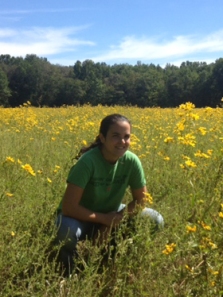 Erika Wassall, the Jersey Farm Scribe here on….
Erika Wassall, the Jersey Farm Scribe here on….
Keeping the Flame Alive
The farther I dive into the world of writing, the busier I become. I have done small amounts of freelance writing for years, but about a year ago, in hopes of gaining experience and honing my craft, I dove deeper into the world of freelance. I wrote for a few online magazines like Honesty For Breakfast (aimed at girls in their 20s), I did some ghost web-copy writing for travel websites and a flower shop, am working on a project with RawSpiceBar.com , and do regular posts for Family Focus Blog with farm fresh recipes and family-friendly projects.
I learned a lot about my writing too. I learned that my instinctively conversational style makes me a natural fit for certain things and not others. I’ve found great success with product description writing and online course curriculum development, because I get to play with different styles of description and ways of engaging an audience. But grant or technical writing for things like computer software manuals… not for me.
So what’s my point? Well, between freelance writing and working on my manuscripts, I am doing hours of writing every single day. And while this has been great in many ways, forcing me to flex my writing and creativity muscles, working with deadlines and not being able to stop because I’m just not “feeling it”, it can also become cumbersome.
Bottom line: Writing is very hard work.
I needed a way to regularly stoke the fire, the furious passion that I’ve always had for the written word. A way to remind myself that writing is fun!
Once a week, I schedule two entire hours, where I sit down and write without a goal, and away from the computer. No deadlines, no projects, no one to tell me what’s wrong with it, just writing. It can be free association writing, prose, anything I want. I can use characters from my manuscripts, but I don’t allow myself to work on actual scenes. I write silly rhymes that follow absolutely no patterns, write sentences with horrible grammar, and break as many rules as I can in 120 minutes.
Sometimes I spend the whole two hours writing what turns into a sort of journal entry, and I am reminded of why I fell in love with writing in the first place… the hidden truths it has always seemed to bring forward.
Basically, I indulge myself.
For me, being away from the computer is an important aspect. I do my work from my computer as a writer and a business owner, so just sitting in the chair has innate associations with obligation. This is playtime not work time.
Curling up with a notebook, a pen and absolutely nothing but chaos to guide me connects with the teenager in me who found refuge in writing as words she was constantly scribbling in the margins seemed to bring her closer to understanding herself and the world around her.
Do I always look forward to it? Nope. Not at all. I’d say a solid 40-50 percent of the time, I’m going into this thinking, ech… this is dumb. I don’t have the time to waste just doing nothing.
But (so far at least!) I have managed to convince myself to do it anyway.
The outcome?
Even when I didn’t FEEL like doing it, when the hours are up, I find myself unbelievably refreshed, both on a personal level, and as a writer. In fact, the times when I’ve wanted to do it the least have frequently been the times it’s had the most effect.
More often than not, I’ve sparked some new ideas for ways to handle scenes I was stuck on, or projects I wasn’t sure of. This means that these two hours actually end up SAVING me time, as I’m able to be more fluid in my work moving on.
And every single time, I renew that secret smile on my face that tells the story of how writing is a profoundly integral part of who I am.
So… do I think this strategy will work for everyone?
Well… sort of. (not exactly a deep meaningful answer there, I know. But bear with me!)
I think finding a way to reconnect with the raw passion of your writing is essential for all of us. Will a two-hour scribble in a notebook once a week do that for you?
It just might. As writers, I’ve found that many of us have similar stories of falling in love with the written word. So I would highly suggest giving it a try. But if after a few times, you find yourself drawn to something else, don’t fight it. Let the wistful, playful side of you run this show, and you may be pleasantly surprised at the outcome.
My two-hour decadent dive into the frivolous side of writing has become a stimulating catalyst for not only my writing but my own spirit and the spirit of my characters. And while I know it’s never always easy to find two hours of your time to put aside, I strongly believe that…
… you, and your manuscripts are worth it.
Erika Wassall is a writer, a farmer and a liver of life. She is a member of SCBWI and a proud Mad Scientist, bringing science experiments right into children’s classrooms, and hearts. She has a small farm in New Jersey with sheep, chickens, pigs and vegetables. Check out her new website at www.TheJerseyFarmScribe.com where as a first generation farmer, she often takes the long way, learning the tricks of the trade on The Farm. On her website is also The Shop page with tips and a free Q/A from her husband’s mechanic shop, and The Writer page where she shares stories, experiences and characters from the heart. Follow her on Twitter at @NJFarmScribe. She’d love to hear from you!
Thank you Erika for another great post. I think everyone looks forward to your posts.
Talk tomorrow,
Kathy
Filed under:
Advice,
article,
inspiration,
Tips,
writing Tagged:
Erika Wassall,
Freelance writing,
Keeping the Flame Alive,
Manuscripts 

This weekend they will be running the NCAA Cross Country Championships. The pinnacle of excitement for college cross country, I’ve done a few pieces highlighting a few of the front runners vying for the individual title: Shelby Houlihan, Crystal Nelson, and Patrick Tiernan.
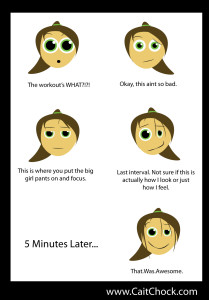
Whether you ran cross country in college, or even went to college, or not I urge you to read them because among all of there runs a similar theme: cross country is unique because it blends the individual component of running with the team aspect. As every runner knows, ultimately, a race is against beating yourself, and while track does have a team scoring element, it is in no way like cross country’s.
Here, there is a team of seven, five runners score but don’t think the sixth and seventh man (or runner woman) don’t count. You need all seven because:
1) You never know: We’ve all had days where the gun goes off and it’s clearly not your day. If you’ve got one of your ‘usual’ top five runners amidst a horrible race, you better hope you can rely on your sixth or seventh to step up.
2) The tie: There are classic stories where it comes down to a tie breaker and a win was decided on the number sixth runner…you can bet that runner who proved a win for their team was celebrated that night!
Most importantly, while running is a test against yourself, there is an incredible bond that is formed between training partners. We’ll call is a bond build on suffering, and when you ‘click’ with certain training partners or groups that’s where the magic happens.
A partner, or team, can pull you to YOUR best.
Through the training season, time miles, the work you put in, if alongside a person/team, therein breeds a remarkable enthusiasm. The success of one is a success of the whole, and in the middle of the pain of race day you can dig a little deeper knowing that you’re racing for yourself but also for your team, your friends, the ones who are pushing through their own pain for you too.

Runners graduate, move on, change teams, but the component of having a training partner there to push you remains the same. Out in the ‘real world’ runners have many options in terms of running: solo, with a friend, with a group, finding a team, etc. Each runner decides where running fits into their life and also what ‘kind’ of running they’re doing.
Some crave the solace of a run with no one but themselves, their thoughts, and the pounding of their feet. Ample time for thinking.
Sometimes it is important to be able to grind out a tough workout by yourself because there is an important part of mental training that must occur.
But…I will say if you want to stretch yourself I urge you to try meeting with at least another person for some of those hard workouts. Ideally, a person a tad faster than yourself.
You see, running is ultimately a test against yourself…BUT, it’s because your MIND is (most often) your greatest obstacle. Having another running there ahead of you, giving you chase, is usually just enough to trick your mind into shutting up and letting your BODY prove you are capable of more.
——-
Lots of other new articles on my WRITING PAGE
I don’t update my blog daily but do on my INSTAGRAM and TWITTER FEEDS
To purchase prints of my artwork head to my ART tab! Thank you for respecting the amount of time and creative work that goes into my drawings and not using them without permissions. 
——
1) Did you run for a team ever, be it in high school, college, or beyond?
2) How often do you run by yourself? With anyone else? With a team?
3) Will you make a goal of meeting someone for a hard workout in the not-so-distant future?


Do you make enough time to draw? Some of us doodle at any opportunity we get. Yet there are also times when we get so swept up in daily doings that we don’t quite draw as much as we’d like to for fun and enjoyment. Taking more time to doodle will not only keep your creative idea’s flowing , fill your sketchbooks with beautiful things but also make drawing fun feeling less like work. So here are afew places you can sketch with ease, seize the opportunity pick up that pencil and draw!
Places you can draw:
- On the bus
- On the train
- In the car
- On a rainy day
- On the phone
- In bed
- At the park
- In the garden
- On your lunch break
Remeber, you should draw because the more you do draw the more those amazing ideas in your creative mind will meet the page for all to see.
Image by Illustrator Chuck Groenink you can find out more about his work here .

By: Kathy Temean,
on 11/7/2014
Blog:
Writing and Illustrating
(
Login to Add to MyJacketFlap)
JacketFlap tags:
inspiration,
Advice,
Process,
England,
illustrating,
authors and illustrators,
Illustrator's Saturday,
Cheltenham College of Art in Cheltenham,
Ilustrationweb.com,
Sholta Walker,
Interview,
Tips,
picture books,
Add a tag
 Sholta Walker was trained and graduated as a painter in 1988 and since 1995 he has worked professionally as a full-time artist and illustrator.
Sholta Walker was trained and graduated as a painter in 1988 and since 1995 he has worked professionally as a full-time artist and illustrator.
The great majority of his work has been for children, with clients across the World, including Harper Collins, Random House, Egmont, Annick Press, The BBC, Macmillan and Oxford University Press.
Most of the illustrations you see here combine digital techniques with more traditional skills and media. He uses vigourous ink line work, which is usually digitally coloured and enhanced. This has given him an opportunity to produce illustrations for my clients which give great scope for expressing ideas.
Some of the work shown here is also available as limited edition
prints.
His published books include Long Grey Norris, King Arthur, Bug Wars and The Beastly Beast.., a compendium of short stories by author Garth Nix. I have recently completed work for a book by Michal Kozlowski called Louis, the Tiger Who Came From the Sea.
Here is Sholta discussing his process:
Creating ‘Bug!’ and Brer Fox
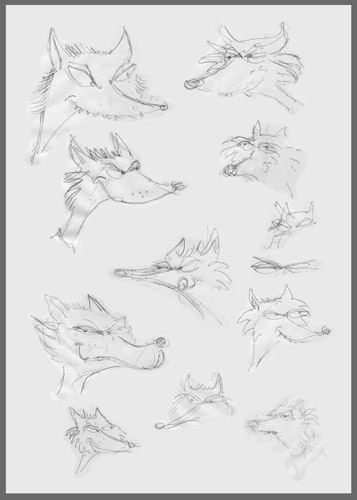
I made these drawings a few years ago. Both at the time were fairly experimental, but borrowed heavily from methods I was already regularly using. Brer Fox was a character I was asked to develop along with his nemesis Brer Rabbit, for a UK publisher. Bug! I made when I worked briefly with an animator-friend while he was working on his Masters Degree in animation.
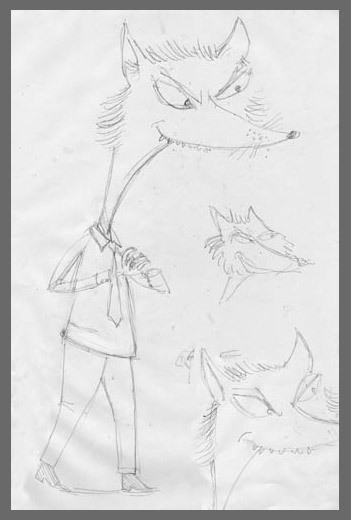
The picture always begins with a drawing on paper. If I’m working on a character I always rough him or her out in pencil. It usually takes several attempts to create the character I’m after. It’s important to get this stage right. Any decisions made now will set the tone for the whole image and are likely to remain with you to the end of the project. The drawing process helps inform the image you have in your head, which then feeds back to your drawing. At its best this busy two-way street of drawing and imagining is a marvelously efficient creative process.

When I have the character I want, I either trace it through a lightbox or work directly over the top in Indian ink with a dip-pen. The type of commission will dictate how free and expressive I am with the pen. In the case of Brer Fox particularly, I was trying to work very freely. One way I do this is to create all the initial pencil sketches as quickly as I can. When I find the drawing I like I then reproduce it by drawing over the top with my pen at a similar speed. This gives the drawing energy and enables me to exploit the naturally temperamental nature of a traditional drawing nib when it’s loaded with ink.
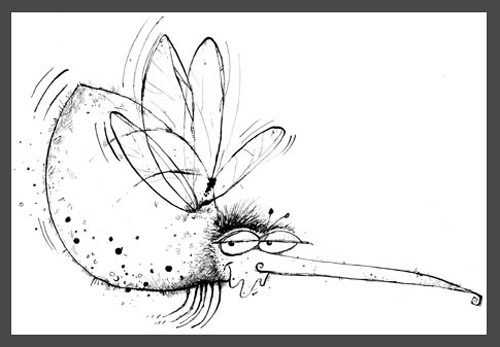
While still fairly loose, Bug! was a little more considered. Also, I created the bug character and his background as two separate drawings and combined them in Photoshop later.
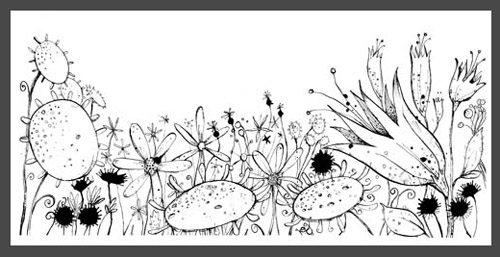
Once the ink is completely dry, any pencil marks are erased and the drawing is scanned and opened in Photoshop. The ink line now has to be separated from the the paper surface. To help improve definition I usually increase the contrast before selecting out the black lines in one piece. The drawing part of the scan is then pasted into a new document, creating a new layer over a white background layer. The original scan is now discarded. At this stage I take the opportunity to have a good look at the image and to erase any dust specks and unwanted ink spots that were picked up in the selection. I may also make any adjustments or small additions to the drawing using Photoshop’s pencil and brush tools. Finally I ‘multiply’ the layer to prevent any whitening of the pixels in the final artwork. Because I like the honesty of a hand made ink drawing I make no further digital enhancements to it.


In the case of Bug!, the character’s colour was created in Illustrator. I imported the line drawing (without the garden) into Illustrator, then, on a new layer, between the white background and the drawing layer, I put in the colour in a series of simple, fairly roughly drawn shapes. In more complex images I may create the colours on several layers, but on a simple image like this, one colour layer is sufficient. Brer Fox was slightly different. He stayed in Photoshop because in this case I didn’t want the flatter look that Illustrator tends to give my drawings. The layering technique however is identical, with the basic under-painting on the figure created using the lasso tool to make a shape into which I drop the colour. Further painting, shading and colour were then added with various brush tools. A basic background layer is also quickly rendered at this stage.
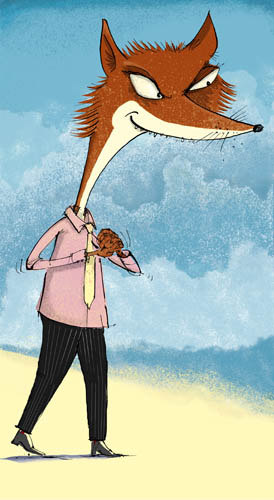

To create the textures in Brer Fox I went back to paper and ink. All the effects in this image are made using either ink applied through a mouth diffuser, (a simple breath-powered spraying device) or from an old toothbrush. The results are then scanned and separated out as in the original drawings. They are then collaged into the artwork, each on a separate layer. For Brer Fox I also experimented with some scans of torn paper. With Bug!, only the garden received this treatment. Once colouring of the insect character was complete in Illustrator, I returned him to Photoshop and combined him with the garden scene that I had drawn and coloured separately in Photoshop using the textures I made in a similar way to those previously described.

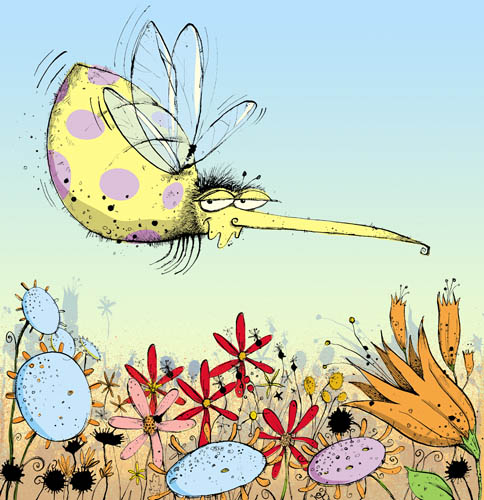
Finally, I added any extra bits and spent some time continuing to tweak the drawing. Some layers are switched off or discarded and occasionally some basic effects are added as in Brer Fox’s drop shadow. I’ll often go back at this stage and draw some new elements (extra flowers maybe) that I think might further improve the image. These will then be scanned and added to the drawing, colouring them up as necessary. A key feature of much of my work is that the process remains very fluid right up to its completion.
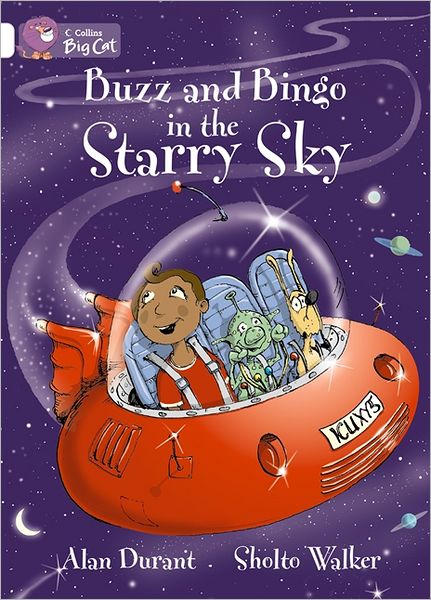
How long have you been illustrating?
Full-time, around twenty years. I spent a few years before that working part time on occasional commissions that came my way.

What made you choose to you study art at Cheltenham College of Art in London?
That’s Cheltenham College of Art in Cheltenham, England. Cheltenham is a large town about one hundred miles West of London. I had a bit of a shaky start in fact. In England, most visual arts degrees begin with a year-long Foundation Course, which most students are expected to complete, usually at a different college, before beginning their three-year degree proper. My foundation year was very enjoyable and successful, but I left still unsure in which direction I was going to take my art. Eventually I chose Fine Art with a painting specialism, but I think my lack of certainty was picked up during the several interviews I attended at various art colleges and found to the surprise of most people that knew me that I wasn’t offered a place at any of them on the first round. So I got a job and tried again a few months later. I was finally accepted at Cheltenham. I’d like to say this was the college I had my sights on all along; that I had studied the work of the tutors and lecturers there; that I was drawn to the verdant Cotswold Hills that rise majestically above the town, but none of that would be true. Nope. It turned out they were the only college that would have me.
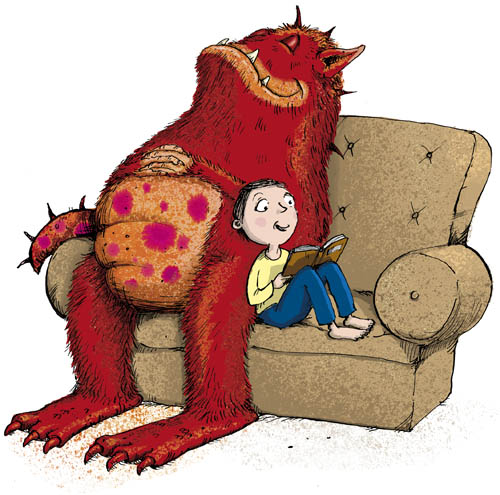
What was the first painting or illustration that you did where someone paid you for your artwork?
I’m not too sure, but I think it was probably a tiny drawing for one of those classified small ads you see in the back of newspapers. It was around 1986.
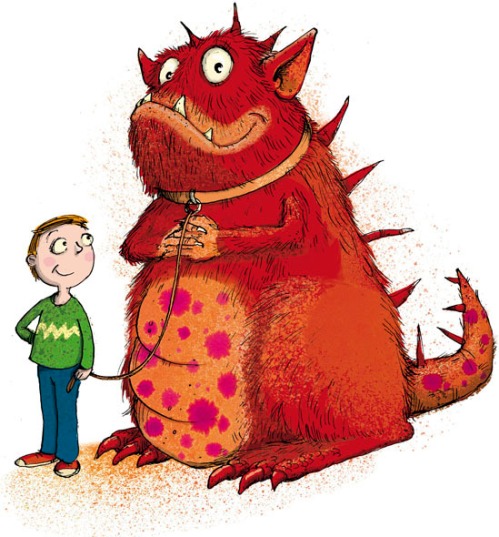
What type of job did you do right after you graduated?
When I graduated I had no idea what to do. Looking back I think plenty of ex-students, particularly with art degrees find themselves in a similar situation. I’m not sure how it is now, but there was absolutely zero consideration given by the colleges as to what their students would do when they left. I don’t think this is necessarily a bad thing because fine art courses should not be job-training courses. So when I left I discovered two things pretty quickly: first, I needed to earn some money and second, degrees in Painting do not make you very employable. I was no longer comfortable at home, so I moved to London where most British students seem to pitch up after graduating. I worked briefly at the famous Cornelissen and Son art shop near the British Museum. The shop’s been trading since 1855 and has and still does supply materials to some of the greatest names in British Art. Then I bought a bike and spent a year as a bicycle courier, risking life and limb on the London streets.
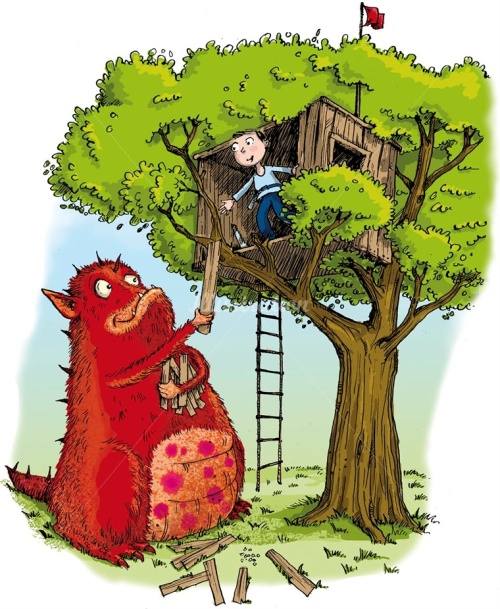
How did you decide you wanted to go into the freelance art business?
After a year or two of struggling to pay my way in London, I thought I needed to make a decision. As a child, making pictures was always something I enjoyed doing and was good at. My degree had pointed me towards traditional oil painting but at that time I could see no way that I was going to be making oil paintings for a living. It was a very slow start. My dad was publishing a music magazine at the time and he managed to convince the editor (thanks Paul!) to ask me to try illustrating a few things. The jobs were very occasional and fairly straightforward, but it was these simple commissions that really got the ball rolling for me. I continued working in various low-paid jobs, but it was those occasional illustration commissions that gave me a sense of purpose. Doing something I enjoyed while being paid to do it. I decided fairly quickly that this was what I needed to pursue.
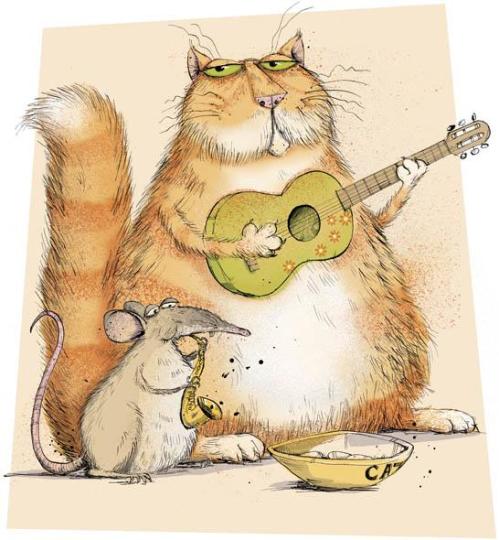
When did you decide you wanted to illustrate for children?
I never decided, my work seems to lend itself to that. When I began as an illustrator I just drew stuff. I had no idea what the illustration business was like and never gave a thought to the idea that illustration could be classified into ‘types’. After my degree, my first portfolio consisted mainly of miniature versions of what I had been producing at art college. Many were very dark and introspective, typical art student stuff really. The colours were full of dark reds and blues. Lots of angst. I was still somewhere between a painter and an illustrator. All my techniques were from three years’ training as a painter working in oils on canvas, so as an illustrator I really had to start from scratch. That meant finding new materials and methods that suited my approach and were practical. As my work developed, much of it became brighter and I found I could express and develop in my work a kind of knowing humour and a sense of the absurd that I have always enjoyed and has always been a part of my character I think. Adults seem to like this at least as much as their children and it appears in most of my best work. I think that this has always been there in my work even during my student days, but as I’ve evolved as a working illustrator I’ve learned to refine it and make it more accessible.
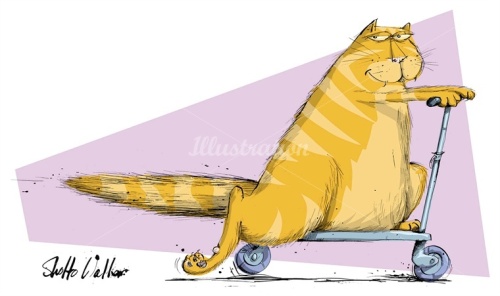
How did you get the job to illustrate Buzz and Bingo in the Starry Sky with HarperCollins?
Wow, that one was quite a while ago. It came through my agent. In fact, now I think of it, it was probably the first full book commission I had with Harper Collins. I think it was also the first book I illustrated digitally. It was actually part of a series for young readers and as far as I’m aware has been very popular in British schools. I have met several parents over the years that know me by name and then realize their son and daughter is learning to read with one of my books. It’s always nice when that happens. My sister lives in Spain and she called me one day to say that her daughter was reading a book I had illustrated as part of her reading program. That was perfect because I had included a dedication to her and her brothers on the title page. I think my sister cried.

Have you done any other books with HarperCollins?
Yes several. At least four or five.
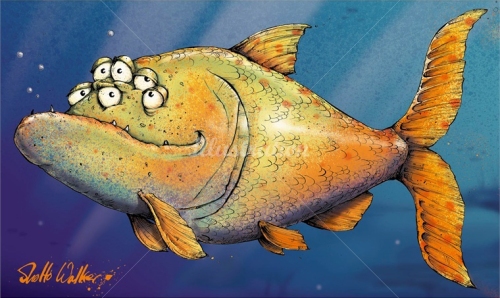
What was the first picture book that you illustrated? And how did that contract come your way?
My first picture book was probably one of the Buzz and Bingo series. I had illustrated a few books before that, but they were more for slightly older readers, so they weren’t strictly speaking ‘picture books’. I had worked on other commissions for Harper Collins prior to Buzz and Bingo so I had built up a bit of a track record. I often think that is, at least in part, how it works. Once a client is happy you can make a deadline, you are professional and reliable and assuming they like what you do of course, you are likely to be asked to take on bigger projects.
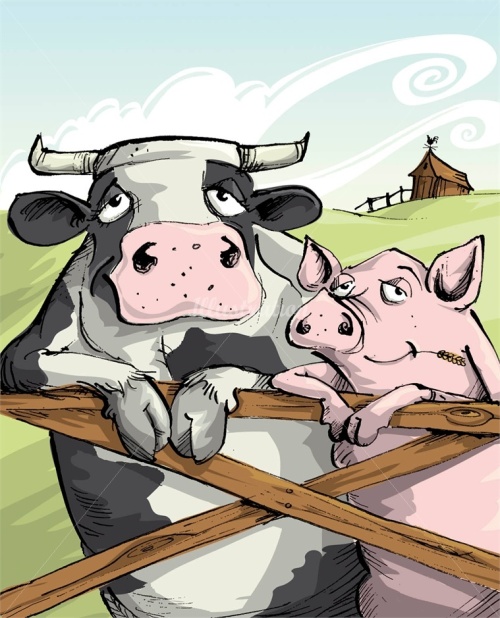
How many books have you illustrated?
Well, if you mean both part books and as full cover-to-cover commissions, then the answer’s probably hundreds. If you mean whole books, then probably around thirty.
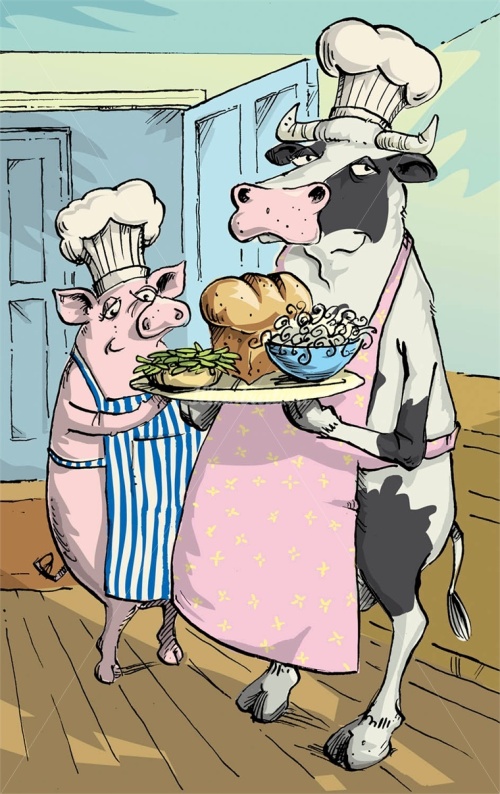
Before you had an Art Rep., what did you do to help connect with art directors and editors and find illustration work?
It was a long and painful process. Once I had set my mind to being a professional illustrator I knew I needed to start building a portfolio to show round. I put together about fifteen drawings that included several of the commissions I had been picking up as well as some of my own work. One idea I had was to buy a few magazines and find articles in them that I felt I could illustrate. If they were successful I would then include them in the portfolio. The next step was to travel to London from Bath where I was by then living and show my work around. In those days, before the internet and online portfolios, this was the only way to do it. I must have spent a fortune on fares, not to mention postage for all the mail shots I made. I picked up very little direct work from all this effort and expense, but I don’t regret it at all because I really got to see what it was I needed to do while showing me what the publishing, design and advertising world outside my studio really looked like. I also still remember to this day some of the dozens of busy art directors and designers I saw who, almost to a person, patiently leafed through my portfolio and usually sent me away with some valuable words of advice. Anyway, I did that for a year or so until I decided it was time to reassess the situation. It was then I turned my mind to getting an agent. I thought if I found the right one, they would do all that work for me.

How did you connect to your artist agency, Illustrationsweb.com? How long have they been representing you?
Yet another trip to London in around 1995 with a list of illustrator’s agents in my pocket finally brought me together with Illustration, which is Illustration USA Inc’s parent company. At that time they lurked up a flight of stairs in a dusty old office in the heart of Soho, West London. They were called Garden Studio then and had been since 1929 when they were first established. It was there I met the excellent Harry Lyon-Smith who took my portfolio away and told me to come back after lunch. When I returned he offered to represent me and that was that.
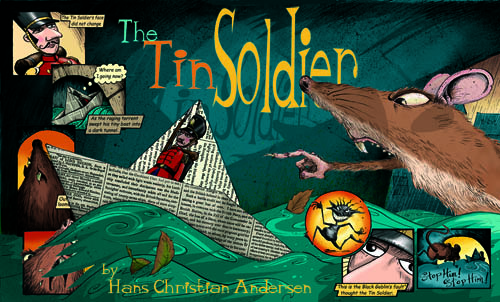
Tell us a little bit about the 200-year-old building in your backyard and the studio you have in there.
I think it was once just a simple stone outbuilding. It was converted to something reasonably habitable about twenty-five years ago and given an electricity and water supply. I’m in Somerset, England, so everything older than about a century is built from stone. The walls are two feet thick, which is normal in old buildings here, but it makes mobile (cell)-phone use next to impossible. If anyone needs to call me at work it’s landline only I’m afraid. Oh, and the roof leaks a bit. I sit beside a window that looks out onto our garden and an apple tree that produces a rare local apple called Ashmead’s Kernal. If you can ignore their gnarled and crusty appearance and take a bite you’ll find they’re incredibly juicy and sweet.
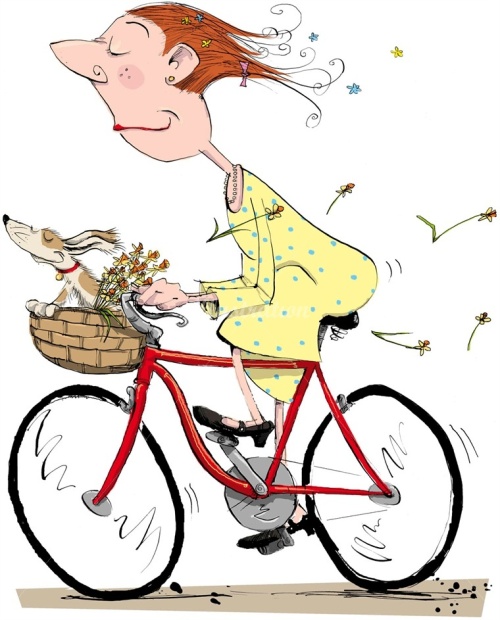
Have you done any illustrating for children’s magazines?
No, not so far.
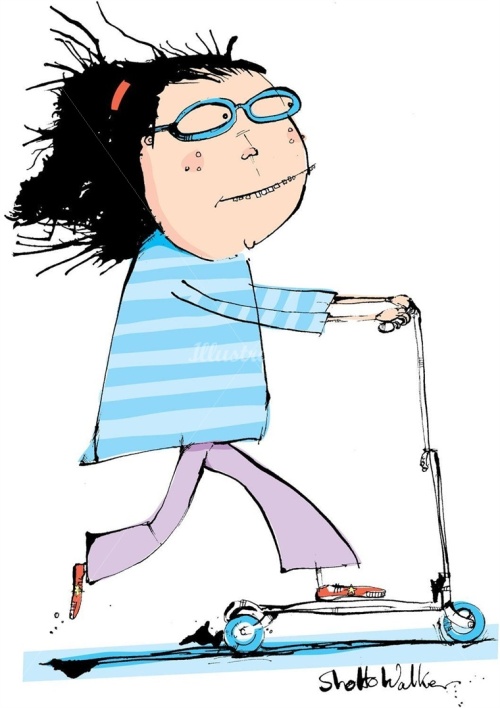
What is your favorite medium to use to do your illustrations?
Dip pen and Indian ink. Then Photoshop and Illustrator.
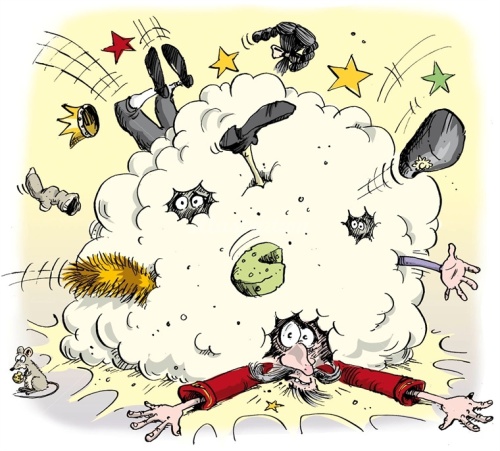
Has that changed over time?
Yes. When I began as an illustrator I developed a way of working that had its beginnings in my pre-art college mid-teens. I would create a pencil drawing that I would render in water-colour and gouache. I would then work over the whole thing in coloured pencil, before putting an ink line drawing on top. This made for beautifully vibrant illustrations, but was hugely labour-intensive. It meant I would often be up all night for even the simplest commissions. I realized this wasn’t sustainable, so in around 2000 I bit the bullet and bought an Apple Mac. Over the next year I figured out a way of working that still retained plenty of me, but was just far more efficient.
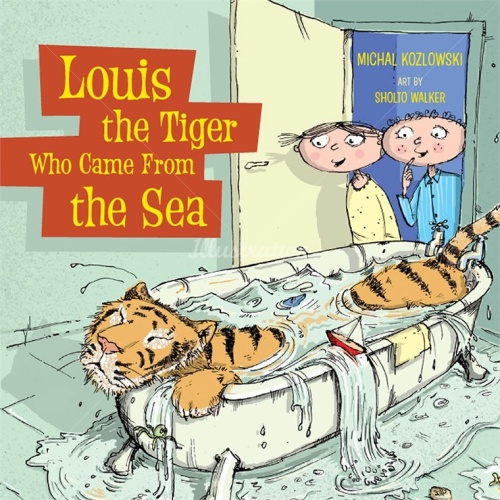
What do you consider is your first big success?
Probably Louis, the Tiger Who Came From the Sea. It’s a difficult question really because I’m very self-critical and I’m usually reluctant to pore over past work too long. I’m always thinking about the next opportunity to get it ‘right.’

How did that come about?
Apparently out of the blue. It’s how all the best work comes. You’re sitting around one day trying to remember how you ended up doing what you do when the ‘phone rings. Or the email arrives, as it usually is these days. In the case of Louis the Tiger, Colleen Macmillan at Annick Press contacted Stacey at my agent’s New York office and offered me the commission. They had seen my portfolio and decided I was the one they wanted to illustrate Michal Kozlowski’s wonderful story. It’s great when that happens.
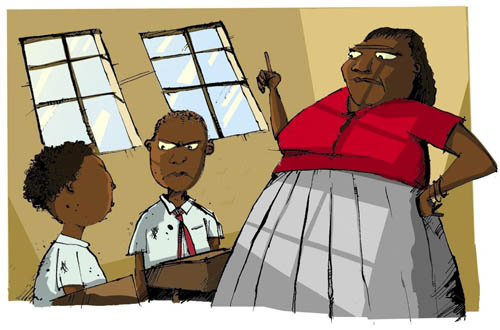
Do you ever want to write and illustrate a picture book?
Yes
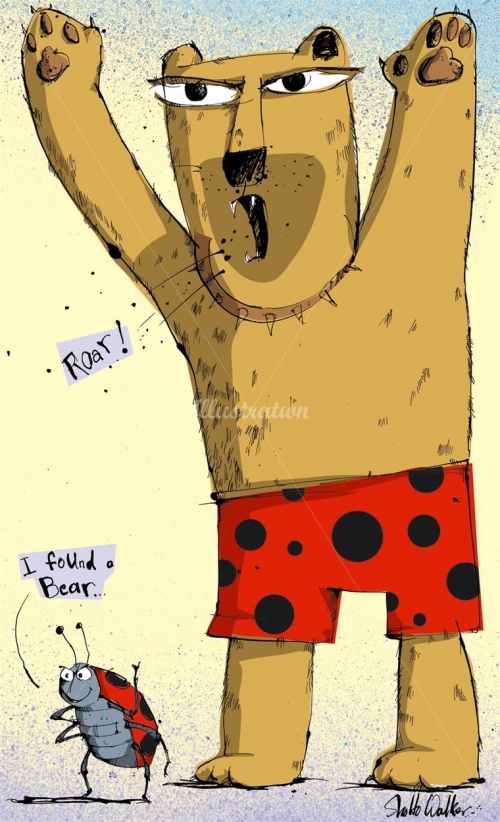
Would you be open to working with an author who wants to self-publish a picture book?
Absolutely. In fact I’ve illustrated a few of these already. Initially I was quite wary of working with self-publishing projects because commissions like these can lack structure and any real management process. I worried the job could really get out of hand. Before you commit I think it’s important to read the manuscript (don’t forget they’ve usually not been through any kind of editorial process) and also try to get a clear idea of what the client (author) is expecting from you and what if any experience they have of producing a book. The great thing about self-publishing commissions is they often give you great creative freedom because there are no sales departments controlling the process as so often happens with established publishers.
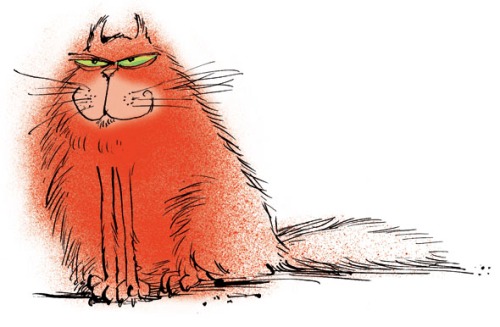
Do you take pictures or do any types of research before you start a project?
Very rarely. If an illustration requires a certain animal for example I usually reach for one of several natural history or wildlife reference books I keep. I recently completed ‘How to Slay a Werewolf’, a new book for Conran Octopus here in the UK. The story’s set in early Twentieth Century England so I had to get the clothes more or less accurate and then there was the werewolf of course, which required a fair bit of preliminary work. The internet has changed everything. In the past research usually meant repeated trips to the local library and bookshops and owning shelves groaning with reference material. Now most research is a mouse click away.
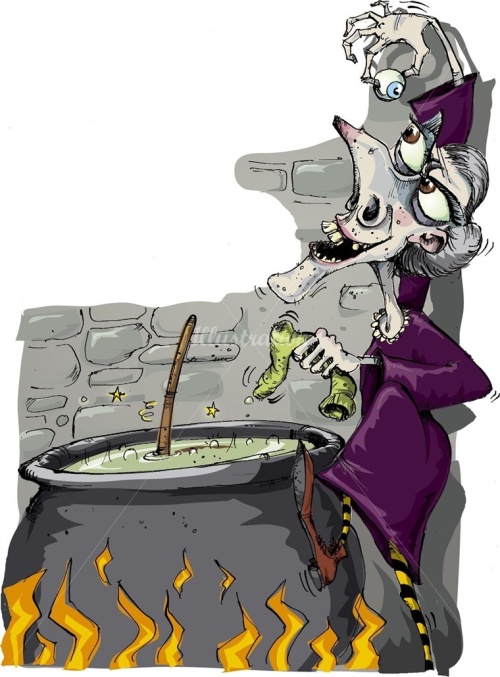
Have you done any work for educational publishers?
Yes, lots.
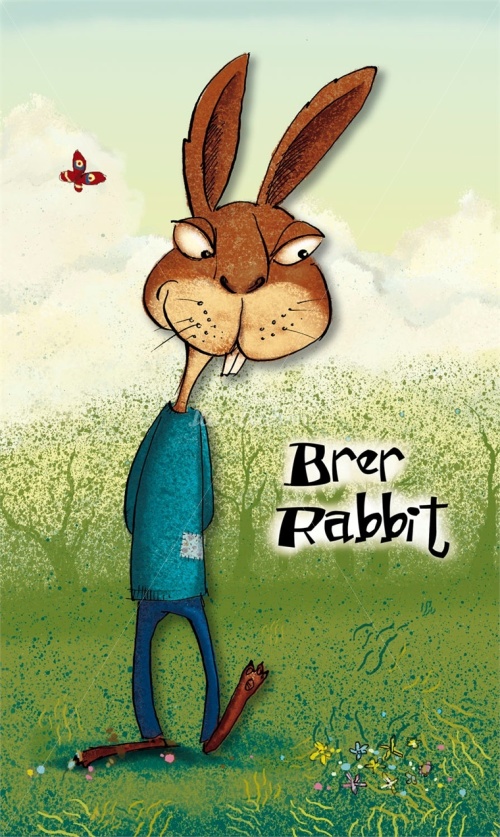
Has all your work come from European publishers?
No. I have worked on projects from around the world. My agent has seen to that. As well as most of Europe, I’ve worked for clients in the USA, Australia, Canada, South Korea and South America.
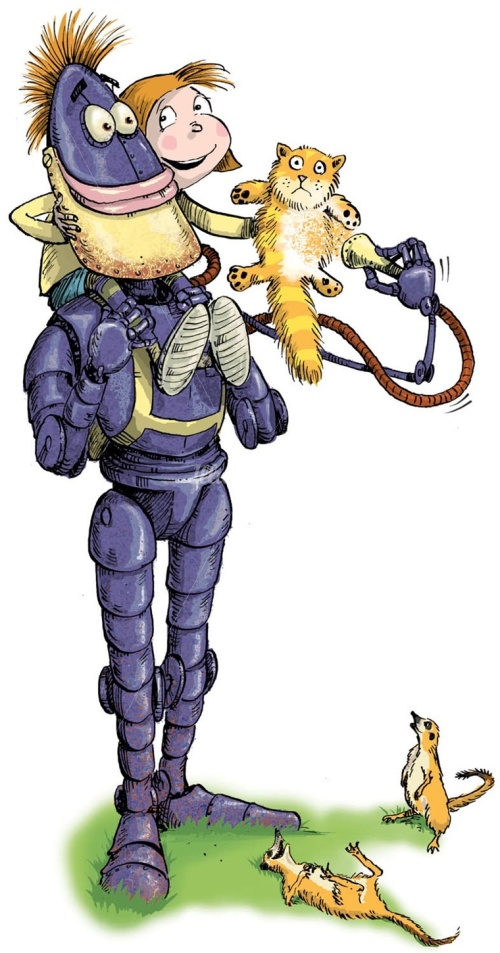
What is the one thing in your studio that you could not live without?
My bicycle, hanging on the wall.
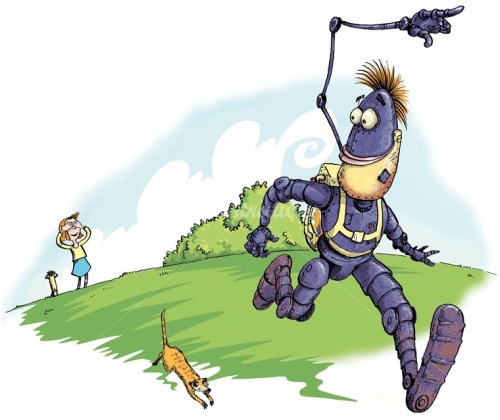
Do you try to spend a specific amount of time working on your craft?
I don’t usually need to make a conscious effort to because I’m usually busy. This was one of the reasons I was drawn to illustration in the first place. I knew if I was a working illustrator and I was getting regular work, the commissions would keep me busy – I wouldn’t have to risk being stricken too often with that dreaded lack of motivation so many artists can suffer from.
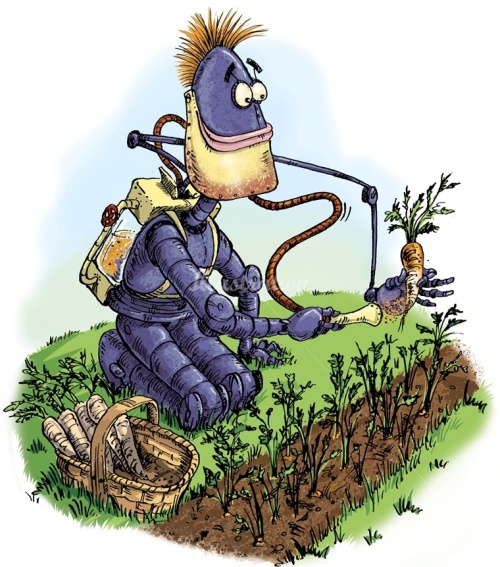
Do you think the Internet has opened doors for you?
Absolutely! Having my work on the web is like having a private art gallery in every home and office on the planet that has access to the internet.
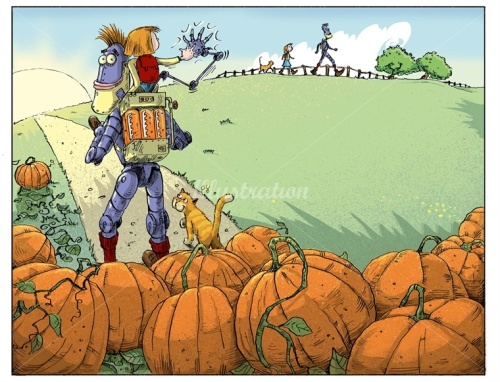
Do you use Photoshop or Corel Painter with your illustrations?
Photoshop.
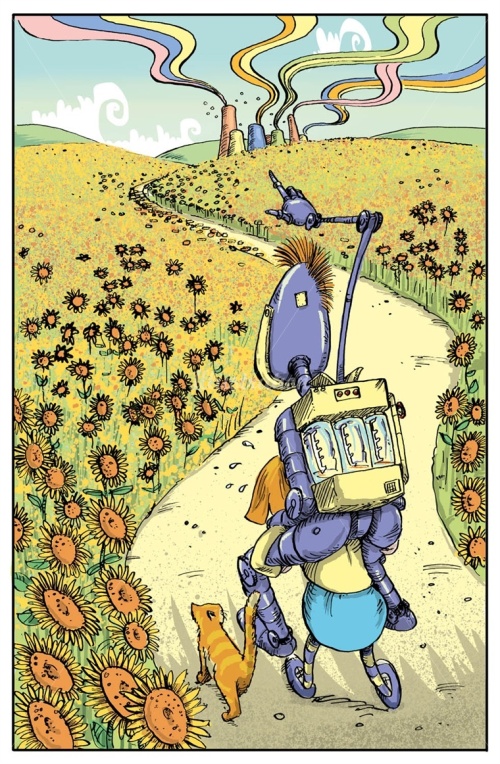 Do you own or have you used a Graphic Drawing Tablet in your illustrating?
Do you own or have you used a Graphic Drawing Tablet in your illustrating?
I couldn’t work without one. Working with a mouse is about the same as drawing with a bar of soap.
 Do you have any career dreams that you want to fulfill?
Do you have any career dreams that you want to fulfill?
One or two. I really need to write and illustrate a book.
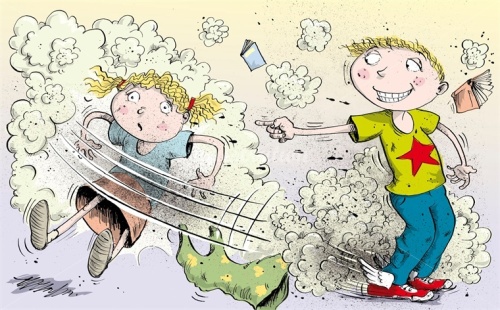
What are you working on now?
I’ve just completed the front and back cover art for a self-publishing project actually. Very imaginative. Very weird…
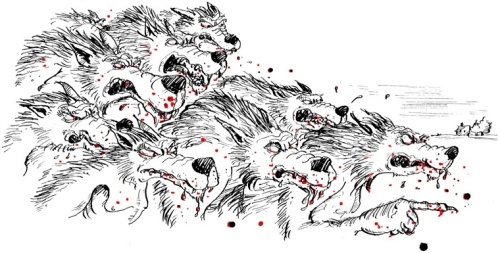 Do you have any material type tips you can share with us? Example: Paint or paper that you love – the best place to buy – a new product that you’ve tried – A how to tip, etc.
Do you have any material type tips you can share with us? Example: Paint or paper that you love – the best place to buy – a new product that you’ve tried – A how to tip, etc.
Yes: If you work digitally invest in the best and biggest display you can find. Preferably two. Don’t forget it’s your canvas. If you make your pictures on paper, remember, if you want your work to outlast you, use the best paper and media you can find.
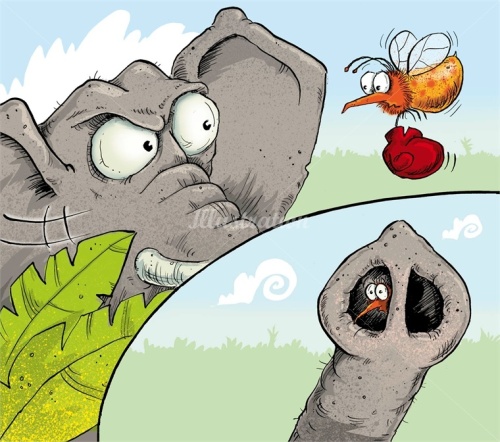
Any words of wisdom on how to become a successful writer or illustrator?
Whatever you do don’t follow fashions. Be you and keep being you.
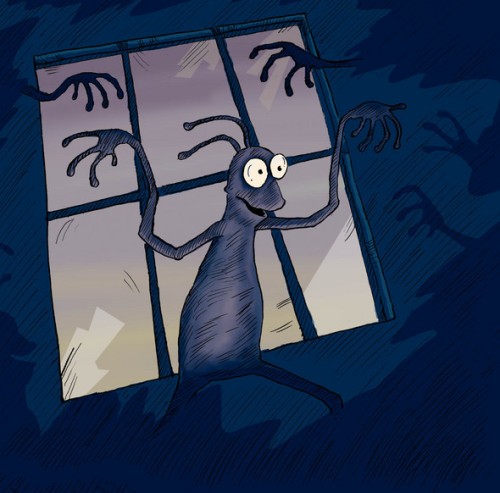
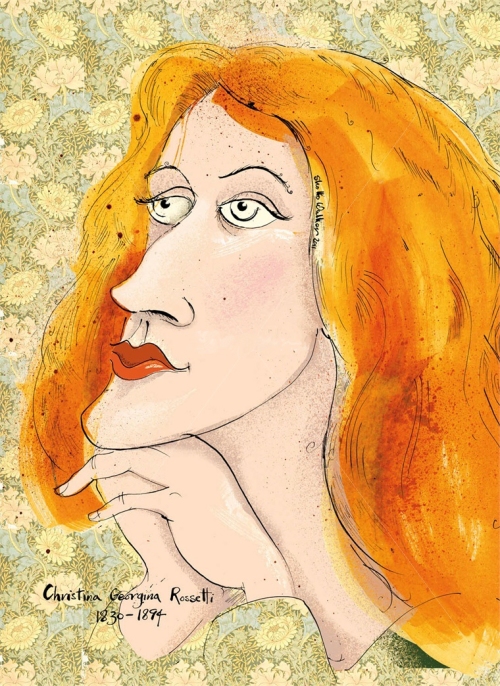
Thank you Sholta for sharing your journey and process with us. Please let us know all your future successes. We’d love to hear about them and cheer you on. You follow Sholta on Twitter @Sholtawalker
or visit his agency at: http://www.illustrationweb.us/artists/SholtoWalker/view
If you have a moment I am sure Sholta would like to read your comments. I enjoy reading them, too, even if I don’t always have time to reply. Thanks!
Talk tomorrow,
Kathy
Filed under:
Advice,
authors and illustrators,
illustrating,
Illustrator's Saturday,
inspiration,
Interview,
picture books,
Process,
Tips Tagged:
Cheltenham College of Art in Cheltenham,
England,
Ilustrationweb.com,
Sholta Walker 

 It’s November, and that means many writers are well into their (first? second? 12th?) NaNoWriMo experience. But for many other writers, crafting a 50,000-word novel in 30 days is daunting, and they’d rather write a book over a span of a few months (or years), rather than just one.
It’s November, and that means many writers are well into their (first? second? 12th?) NaNoWriMo experience. But for many other writers, crafting a 50,000-word novel in 30 days is daunting, and they’d rather write a book over a span of a few months (or years), rather than just one.
If you fall in the latter, you can still use the month of November to your advantage. Here are five ways to modify your NaNoWriMo experience:
1. Write short stories. I began writing a novel during NaNoWriMo three years ago and made it to Day 14 before giving up (because I may or may not have almost passed out—and I may or may not be joking about that). I managed to craft a 23,000-word story. While the story makes absolutely no sense (seriously, it’s basically just words strewn together in somewhat coherent sentences), at least I wrote something. This year, I’m using that incident as motivation to write short stories instead of a novel during NaNoWriMo. (So far, I’ve written one story, and I’ve started on a second one. Go me.) This is a good way for writers to craft fiction stories without the pressure of writing a complete first draft of a novel. Maybe instead of a 50,000 manuscript, how about two 25,000-word stories, three 1,600-word stories, or a 30,000-word novella?
2. Write journal/diary/blog entries. Ever wanted to start a blog, or even get back in the habit of journaling? NaNoWriMo is a great time to do so if you aren’t ready to pen a full-length book (whether fiction or nonfiction). There are plenty of free blogging sites such as WordPress.com and Blogger.com to get you started. Or, you can go old school and simply use pen and paper. Whatever you choose, use this time to do some personal writing.
3. Write a query to a magazine. Queries are important to landing magazine assignments, so use NaNoWriMo to craft the perfect one. You can also use this time to write a complete article if you have an idea, available resources, and have done your research on said article idea.
4. Outline. If you’re a stickler for using an outline to help you pen a novel, use NaNoWriMo to write one. Then, use another month (say, January or February, after the holidays) to write a first draft with the notes/outline you created in November.
5. Rewrite and revise. Ugh. I don’t know too many writers who don’t dread this stage in the writing process, but it’s a necessary evil. If you have a completed draft and don’t want to use NaNoWriMo to write another one, use this time to revise the one you’ve already written. Keep in mind, though, that after you’ve rewritten and revised your manuscript, it’s a good idea to have someone else (another writer, or, better yet, a professional editor) critique the newest version of your draft.
Whether you plan to write a full novel, or do one of the above modifications, use NaNoWriMo to simply do what you love to do best: write.
___________________________________________________________________
 Tiffany Luckey is the associate editor of Writer’s Digest. She also writes about TV and pop culture at AnotherTVBlog.com. Follow Tiffany on Twitter @TiffanyElle.
Tiffany Luckey is the associate editor of Writer’s Digest. She also writes about TV and pop culture at AnotherTVBlog.com. Follow Tiffany on Twitter @TiffanyElle.
 Author of twenty-nine books, Margo Sorenson was born in Washington, DC, and spent the first seven years of her life in Spain and Italy, living where there were few children her age, so books became her friends. She finished her school years in California, graduating from the University of California at Los Angeles. After teaching high school and middle school and raising a family of two daughters, Margo is now a full-time writer, writing primarily for young people of all ages, toddlers through high schoolers. Margo enjoys writing for young readers since she believes they are ready for new ideas and experiences, and they really enjoy “living” the lives of the characters in books.
Author of twenty-nine books, Margo Sorenson was born in Washington, DC, and spent the first seven years of her life in Spain and Italy, living where there were few children her age, so books became her friends. She finished her school years in California, graduating from the University of California at Los Angeles. After teaching high school and middle school and raising a family of two daughters, Margo is now a full-time writer, writing primarily for young people of all ages, toddlers through high schoolers. Margo enjoys writing for young readers since she believes they are ready for new ideas and experiences, and they really enjoy “living” the lives of the characters in books.
Besides winning recognition and awards for her books from various groups, including the American Library Association, Margo was invited to donate and archive her working papers with the internationally-known children’s literature collection, the Kerlan Collection, at the University of Minnesota.
A couple of weeks ago I featured illustrator David Harrington. One of this new books was Spaghetti Smiles written by Margo. I thought it might be fun to hear about her journey as a writers, so I interviewed Margo and below are the answers to the questions I asked:
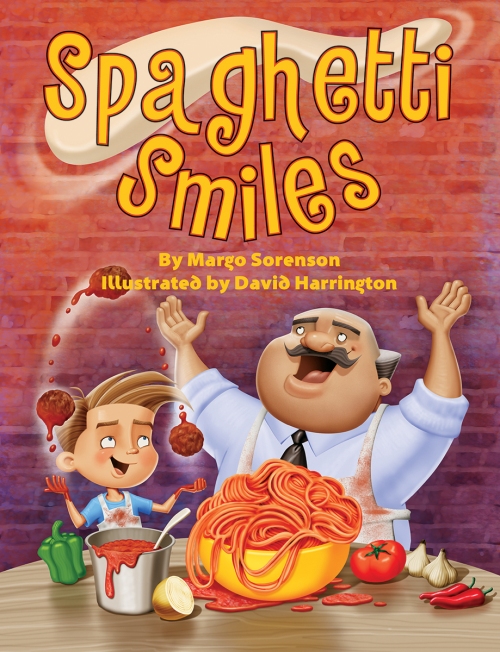
What was the inspiration behind writing Spaghetti Smiles?
The primary inspiration for this book was the question I always tell students during school visits: “What if?” Watching and listening to people in many different places can serve as the impetus for a wacky and crazy idea, if you ask yourself, “What if?” about what you see and hear. For example, for SPAGHETTI SMILES, one of my ideas was generated by the fact that our daughters used to have sleepover birthday parties in elementary school, and what they loved to do was to have “make-your-own-pizza” parties. The girls would line up in front of all the ingredients and create their own pizzas, some making faces and some making designs. I always wondered, “What if?” the pizzas could rearrange their own faces? The other “What if?” question popped into my head when our favorite Italian restaurant lost its neighbor, a toy store. The store remained vacant for some time, and I wondered, “What if?” a bank moved in next door? Or a post office? Or a gas station? What if things got mixed up between the restaurant and its new neighbor? What would be some of the wacky things that might happen? Because I love cooking Italian food and Italy (and lived there as a little girl) and reading, everything fell into place.
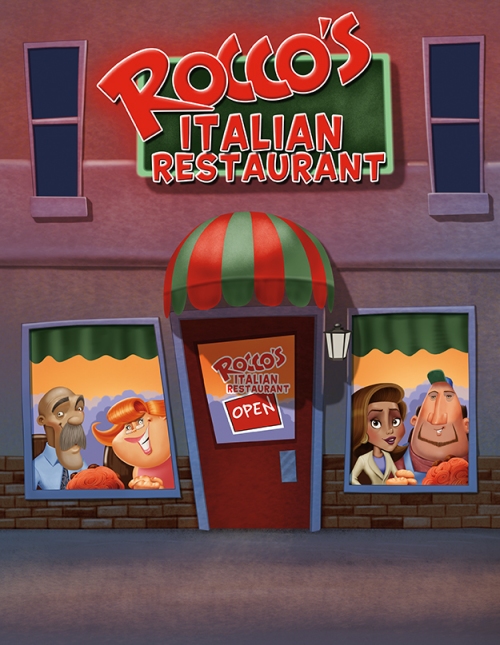
Back Cover of SPAGHETTI SMILES
How long did it take you to write your new book?
I wrote the first draft in 1992! Yep, that’s 22 years! There was a lot of revising and there were many, many rejections of various versions, but, I really wanted young readers to find out about Jake and Uncle Rocco and let their imaginations loose, so I kept going.

Title Page
How long did it take you to find a home with Pelican Publishing?
I queried them in 2010, received an invitation to send the manuscript in 2011, and received the offer in 2012. It took two years to get it published, which is fairly typical for a picture book. As you well know, publishing does move slowly, but, the book was worth the wait, because I am so happy with everything that Pelican has done for the book, including signing up awesome illustrator David Harrington, whose whimsical illustrations really bring the story to life!
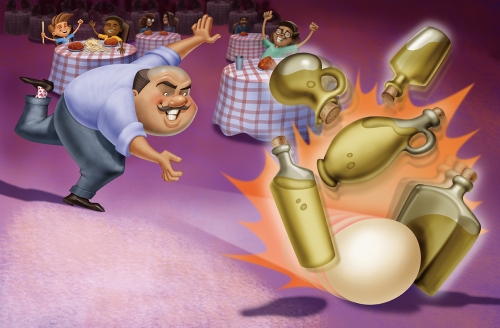
What did you major in at the University of California in Los Angeles?
I majored in medieval history – yes, I was a geek, and you could say I still am!
It sounds like you lived in lot of places around the world. Is there a story behind that?
My father was in the US Diplomatic Service when I was young, so I was partly raised in Spain and Italy, before I returned to live in the US for the first time – what a shock! J After I grew up and married, my husband’s job took us lots of places, which is why we lived in California, Hawaii, and Minnesota. Different locations are great for writers, because absorbing the new atmosphere and all the sensory details can combine to make writing richer and more varied.

What inspired you to start writing children’s books?
Some of the parents of my students encouraged me to write, after I had taught their kids to write for national contests, such as the Scholastic writing contest.
What was the title of your first published book?
My first published book was HOW TO SNEAK UP ON A GOOD BOOK, a reading record book that I co-authored with my school’s terrific librarian, Anne Polkingharn. It is now out of print, since people realized they could Xerox many of the pages (gasp!) and thus stopped buying it! It was fun devising creative projects that kids could use to report on books they read, and it is the only one of my 29 books that is out of print.
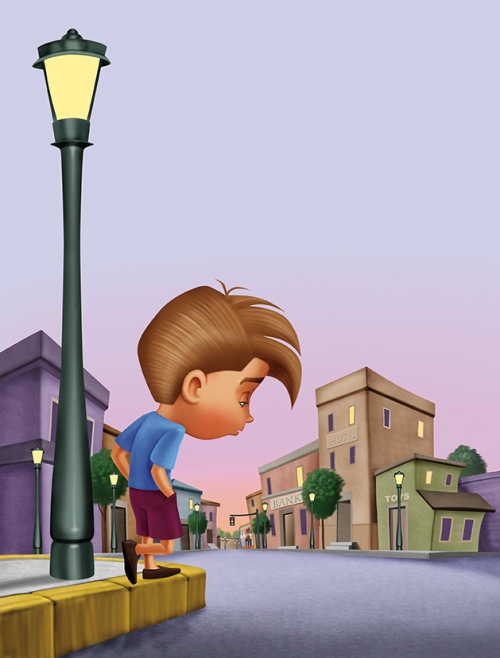
When did that come out and how did you get the contract for that book?
That was published in 1994, and I researched educational publishers, happily finding Perfection Learning Corp. J Then, they offered me contracts to write a total of 21 more books for them for their enrichment and supplemental literature reading program, many of which are for reluctant readers.
Do you have an agent? If so, who?
I do not have an agent, nor have I ever had one. I wouldn’t mind an agent, but, open communication would be key. Being in the loop and knowing what is going on are very important to me. I’ve been very, very fortunate to have wonderful editors and publishers, so an agent hasn’t been necessary. For example, North Dakota State University Press/North Dakota Institute of Regional Studies just re-released my middle grade historical fiction TORI AND THE SLEIGH OF MIDNIGHT BLUE as an ebook, simply because they believe in the story, which means a great deal to me.

It looks like you have written books from young children to young adult, plus fiction and non-fiction. Do you gravitate to one more than another?
That’s a hard question –except for the non-fiction! Although I loved learning about new ideas and had fun writing the books, I am pretty much done with non-fiction, simply because some of it felt like homework! I wrote TSUNAMI and HURRICANE before the internet was as ubiquitous as it was today, and I trudged through the snow (yes, really!) to the Edina (MN) City Library to do my research. Making sure facts were correct and making sure they were explained in a way that makes sense to young readers were a challenge – and I ended up using about forty bibliographic sources for each one. Whew! What was fun was making some lasting friends writing TSUNAMI when I interviewed the two geophysicists who ran the Pacific Tsunami Warning Center and the International Tsunami Warning Center, and we are still in contact to this day. When my family goes to Hawaii, we try to stop by the PTWC in Ewa Beach, Oahu, and say hello! I enjoy writing picture books and I enjoy writing young adult, but, because of the current young ages of my grandchildren (the Adorables) I gravitate more to writing for younger readers right now. But, as a writer yourself, you know that is liable to change anytime!
At this stage in your career, do you still find you need to revise when writing a new book?
Whoa! Are you kidding? J I’ll put manuscripts away for a while and then take a look at them much later and wonder, ‘What was I thinking???’! It’s all about revision, all the time!
Do you still receive rejection letters?
Absolutely! When I do author visits, I always ask the kids to guess how many pounds of rejection letters I’ve received (that’s just the letters, not the manuscripts!) – I’m up to over 35 pounds!
Do you feel your writing style has changed over the years?
My writing style has definitely changed – thanks to editors and my critique partner, children’s author Bonnie Graves ( THE BEST, WORST DAY, MYSTERY OF THE TOOTH GREMLIN, etc.). Her voice rings in my ears: “Spare! Spare!” I hope I use words more economically these days – and I definitely use fewer (if any!) adverbs. Some of my earlier books like DANGER CANYON (still my best seller!) use more adverbs than I’m comfortable with using these days, but that doesn’t seem to keep young readers from reading them!

Are you someone who follows a daily routine with your writing?
I don’t follow a daily routine, unless I am working on a manuscript. Then, I start early in the morning, (with plenty of coffee!), and write like crazy. If I’m not working on a manuscript, I’ll try to daydream “what ifs” in odd moments, and write those ideas down to work on later.
Do you ever do any research when you write a fictional picture book?
I definitely do research when I write fictional picture books. We writers owe it to our young readers that the backstory is accurate, even though a lot of it might not even appear in the story. When I was writing Ambrose the Medieval Mouse stories (AMBROSE AND THE PRINCESS, AMBROSE AND THE CATHEDRAL DREAM) for Liturgical Press, I even sent the manuscripts to my former medieval history professor, the late Dr. Bryce Lyon, professor emeritus, Brown University, for vetting, making sure all the details were accurate. He was delighted to be of use and was a big help. As one example of many, my manuscript read, “Peasants and farmers crowded into the cathedral,” and he wrote me that “peasants *were* farmers,” so I deleted “farmers.” He was tickled that I dedicated both books to him as well as to my dear, supportive family.

How do you market yourself to secure school visits?
My author website has a whole section on my author visits, and I try to make sure that my name is found on various websites that list authors who do school visits. I also do twenty-minute complimentary Skype visits, and there are some websites that list those, as well, including that of my virtual author friend Kate Messner. Sometimes, I’ve even gotten a school visit through Twitter, such as this past September, when my friend and School Library Journal Librarian of the Year Michelle Colte (Hale Kula, Schofield Barracks, Wahiawa, HI) suggested through a Tweet to another librarian, Debbie Vandersande of Kahala Elementary, that she contact me for a visit – and it happened!
What is your greatest success story?
My greatest success story is when I hear from young readers that something I wrote spoke to them in some way – that they connected with the characters and the story. That’s really the reason I think that any of us authors write; when I was growing up, reading broadened my horizons and let me live lives I never thought I would, and I hope I can do the same for young readers.
What are you working on now?
I’m working on a YA novel set in Italy, which is under submission, and a number of picture books, including UPSIDE-DOWN PUPPY and NO NAP, GRANDPA. I love the whimsy of picture books and thinking outside the box, and I love to hear young readers giggle!
Do you have any words of wisdom for writers looking to publish a book?
Yes, though it’s always tricky, since writing is so personal, especially at the very beginning of a writing career. One of my favorite sayings is from Ellen Kozak: “The First Commandment for writers is ‘Thou Shalt Not Fall In Love With Thine Own Words’.” I can’t tell you how many times I’ve done that – it’s embarrassing, actually! Find a good critique partner, take your time, revise, revise, revise, and never give up.
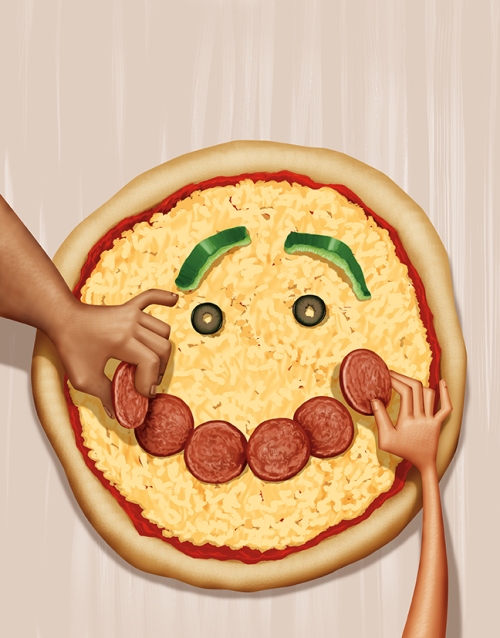
Thank you Margo. I enjoyed reading your answers. Good Luck with the book. Keep in touch. Use http://www.margosorenson.com/ to read more about Margo and her books.
Talk tomorrow,
Kathy
Filed under:
authors and illustrators,
inspiration,
Interview,
picture books,
Process,
Tips Tagged:
Margo Sorenson,
Spaghetti Smiles 

Here’s an excellent question I got from a reader recently. If you’ve got any running related questions for me, feel free to drop me a line: [email protected]
Q: Hi,
I came upon your page regarding running and could not help but be very impressed. I am a 23 year old dental student in my final year and the stress of exams has got my anxiety to higher than average levels. I am writing to you regarding advice and techniques on how to relieve such stress/anxiety through the sport of running. I previously ran 5km a day, however due to recent time constraints I have been unable to match this goal. What would you suggest in terms of distance to ensure I do not spend too much time on recreational running? What intensity do you recommend I perform? And finally what supplementation would you suggest to help me improve and relieve said anxiety.
Regards,
Dr. To Be

A: Hi Dr. To be,
Thank you very much for your kind words and I’m happy to hear you’ve enjoyed my site! I’m doubly excited to hear that you’ve experienced just how much of a rush, escape, and release running can be. So much more to running than just the physical benefits it gives us!
Wow, I’m stressed just thinking about all the school and exams you’ve got going over there, congrats on pursuing your degree and making it to the final stretch! Now on to your questions.
It sounds like you were able to become rather consistent and felt comfortable with the 5k a day, but I understand that your schedule is becoming more busy. I’ll offer some tips on ‘finding’ that extra time but in regards to you wondering what the ‘right’ amount of time spent running is, there is not ‘right’ amount for everyone. Running is great because it’s incredibly individual and that means training and racing is all fit to the person, and it’s a matter of discovering what is right for YOU. For some that could be 70 miles per week, for others it’s 20. Always remember that some running is better than no running, so for your situation I’d suggest making a goal to fit in your 5k at least 4-5 times per week. That’s a good amount to make sure you keep your fitness maintained and offer you those times to get ‘out’ of school/stress/work mode and find your escape.
Some tips I have for finding that time:
1) Run first thing in the morning. Sometimes that means waking up a little earlier but it also ensures that no matter what comes up later in the day you’ve got your run done. Take the time the night before to lay out all of your running clothes and shoes so you can roll out of bed and hit the road!
2) Packed and Alarmed. If you can’t run in the morning take a bag packed with all your running gear with you to school and capitalize on ANY free moment you have between classes or find a break. You can also schedule your run time in your day and view it as any other important meeting, it’s YOU time and important.
3) Night Runner. Some people thrive off of running out the stress of the day and like to run at night. If that’s you, instead of Netflix or TV, get some miles.
4) Multitasking. I know runners who do their studying while running, be it flashcards on a treadmill, listening to recordings of lectors or study notes recorded.
Usually there are free minutes in the day, you just have to look for them. 
I also wanted to let you know that the endorphins released from running actually improve creative thinking and problem-solving. Actually taking a break to run when you’re stuck with a problem or project you can’t solve will help your work. When you come back you’ll be more productive and re-energized. So you shouldn’t feel like your running time is ‘wasted’ time that you ‘should’ have been spent studying.
For workouts, if you’d like to push yourself then start by adding some pick-ups, or fartleks, into two of your weekly runs. Make sure you have at least one easy run between them. For some fun workouts, do 1 mile easy, then alternate running 1 minute harder and 1 minute easy. Come back next time and do 2 minutes hard/easy…the combinations for fartleks are endless. I have more workout suggestions HERE.
Lastly, stress management and anxiety. A really powerful tool is visualization, which I wrote about HERE, and you can apply that tactic to all other areas of life. If you’re stressed about exams, then close your eyes and picture yourself arriving to the test area calm, relaxed, and confident. You ultimately want to get in the habit of being able to put yourself into a relaxed state, with steady breathes, and then when the actual event is happening you’re able to recall that feeling of being calm. It take practice and time, but with practice you’ll become better and better at it…just as with running!
Running offers you a unique mind-space; the chemical release of endorphins plus the feeling of freedom, lays the foundation for a happier, more productive mood overall. You may find that some of your best ideas come on the run, that is the case for me! You may also find that over time, and when you’ve got more time in your schedule, you’d like to push yourself by adding more miles and different workouts. As, I hope the relationship you’ve got with running turns into one that is lifelong.
Thank you for writing and happy studying AND running! 
Cait
——
Ask Me: Solving Calf Injuries
Improve Your Running By Asking Yourself THIS Question


By: Kathy Temean,
on 10/30/2014
Blog:
Writing and Illustrating
(
Login to Add to MyJacketFlap)
JacketFlap tags:
Agent,
Tips,
writing,
inspiration,
Advice,
Process,
revisions,
Free Fall Friday,
Liza Fleissig,
Liza Royce Agency,
First Page Critiques,
Add a tag

This illustration was sent in by Patricia Pinsk. She works primarily with water colour, ink, digital photography, coloured pencil and collage. Patricia holds a Bachelor of Fine Arts degree from Vancouver’s Emily Carr Institute of Art and Design (now called Emily Carr University of Art and Design), as well as a Certificate in New Media from Vancouver Film School. Web: www.patriciapinsk.com/ Facebook: www.facebook.com/patriciapinskillustration?ref=hl Twitter: @patriciapinsk
Here are the first page critiques brought to you this month by Liza Fleissig from the Liza Royce Agency.
The Tattletail’s Claw: A CreatureNet Chronicle by Jody Staton – Middle Grade Novel
“Be Careful What You Wish For”
“. . .and that, Clawdia,” says Hershey’s voice in my head, “is why you must never let two-leggers know what we are.”
I lick a paw, and swipe it across my whiskers. Curled up on his wide brown rump, warmed by his body heat, I’m lulled half to sleep.
Zzzzt! A huge horsefly dive-bombs us. Wide awake now, I swat with a paw, and miss. Hershey flicks his long black tail. Whipping horsehairs send the fly tumbling. It buzzes around his legs, he stomps a hoof. His rump becomes an earthquake. I leap to my feet, teetering because I dare not dig into his hide the few claws I have left. We are next to a water trough, and I jump over it to a split-rail fence.
“Sorry about that,” he says. He ducks his head—in apology, I think. No, he’s just rubbing his head against the edge of the trough, scratching the lump that mars his forehead. Then, stern, like the police horse he used to be, Hershey demands that I repeat what he just told me.
I blink. “About the interstellar ark?”
“Wrong. About how two-leggers wouldn’t understand. How can you teach these stories to other Listeners if you don’t know them well yourself?”
I twitch my question-mark tail. “Why? Yesterday you said how few of us—”
“Lunchtime, Clawdia.” A human voice cuts me off. From the back porch of the Schwartz Veterinary Clinic, across a gravel drive from Hershey’s farm, it’s a young voice. And familiar!
“Dookie! I knew she’d come again this summer.” Forget Hershey’s lectures—my favorite person is here! I leap from the fence, streak across the drive. Dookie jumps from the porch, falls over a small bush, picks herself up, and races toward me. We meet in a mess of legs and arms, fur and tight curls, purrings and kisses.
Here is what Liza had to say:
Staton, The Tattletail’s Claw
The writing itself is nice, with many nice details (like “I lick a paw and swipe it over my whiskers” and “his rump becomes an earthquake”). But my first impression is one of confusion—there are a lot of elements that are unexplained, and it’s rather difficult to paint a picture or figure out what’s going on.
The very first sentence is a difficult and awkward way to begin a story—with dialogue in the midst of being spoken. Perhaps the writer is trying to created intrigue, but younger readers will be confused. For one, we do not yet know they are animals and two, “two-leggers” will be an unfamiliar term.
It takes quite a while to figure out what kind of animals these are, which also causes confusion—you don’t want readers to be wondering about this so much that it detracts from what’s happening in the story.
Other questions: The cat says, “I dare not dig into his hide the few claws I have left”—why is this? Is this a detail we need to know right now, on the first page? Then, the horse says, “How can you teach these stories to other Listeners if you don’t know them well yourself?” First of all, what stories? Secondly, who are the Listeners? Third, why does the cat not seem to care about the stories (and why does the horse)? Again, you want to create intrigue, but you don’t want to leave the reader with so little to work with, and here there are just too many unanswered questions.
If this is a story about talking animals, then it’s a story for young readers. The sentence structure is a bit too complex, and combined with the above questions, I think younger readers are going to feel lost (what is an “interstellar” ark, for example?) We need to have a simpler, cleaner and more appealing introduction to the story. The set-up needs to be such that young readers want to keep on reading. The detail with Dookie is very sweet—perhaps concentrate on this as an introduction—and maybe the fact that these animals can talk is enough of a mystery that the reader will be excited to find out more.
___________________________________________________________
Daddy, What’s a Redneck? by Erika Wassall Picture Book
Little Lainey squatted, tugged on the pant legs sticking out between the two tires and asked, “Daddy, what’s a Redneck?” (illus: Daddy is underneath a vehicle working on it.)
Daddy laughed. He opened his mouth to answer, but stopped short.
“Hand me that yellow screwdriver and I’ll tell you,” he said. “Your great-granddaddy was a Redneck. He worked out in the cotton fields all day, with the sun beating on the back of his NECK.” Daddy slid out from underneath the engine and smiled. “What happens to your nose and shoulders when you’re out in the sun all day?”
Little Lainey’s eyes lit up, “They get all RED!” she cried.
Daddy nodded. “Exactly! Back then, working in the fields meant you couldn’t go to school. Calling someone a Redneck could have been hurtful, meaning they weren’t very smart. People started to think that folks who worked with their hands all day were fools.”
Little Lainey stared at Daddy’s grease covered hands and sternly shook her head. “But Daddy! Your hands can fix everything! They’re the smartest hands I know.”
“Darn right!” said Daddy. “Folks often try to find ways to put others down. That doesn’t make them right. People all across the country are proud to be Rednecks.” (illus: Daddy’s leaning over so we can see his red neck)
“Why?” asked Little Lainey, as she watched the rainbows dance on the top of the oil pan.
Here is what Liza had to say:
Wassall, Daddy, What’s a Redneck?
Opening paragraph is sweet. I just don’t know how much this topic is going to interest readers. Does this make a story? What is the story here? Dad is answering a question, but what is the story? Why does the little girl ask this question in the first place?
My concern is that the title feels like a joke and it’s hard to take the story seriously upon first hearing what the title is. In fact, there may be a lot of people who take offense before they even have a chance to read the story.
Dad’s answers to the little girl’s question are nice, but there’s a lot that feels a bit too adult here and which young readers might have a hard time understanding: “Folks often try to find ways to put others down” etc.
General kid appeal: a little low. It’s hard to imagine a kid wanting to read this based on the first page (and keep going back to it). Feels a bit too earnest and “issue” driven. Combined with the title, I don’t think this would be something an editor would request over other things currently being shopped.
___________________________________________________________
JEREMY’S SLED By Sue Heavenrich – Picture Book
Jeremy pulled his new sled out of the car. He squeaked his boots on the fresh snow. “Sugarhouse Hill, here I come!”
“We still need noisemakers for our New Year’s party,” said Dad. “Stick to the small hill until I get back from the store.”
“Okay,” said Jeremy. He waved to Dad and then plodded up the hard-packed path. But instead of stopping where he should have, his feet took him up, up, up to the top of the highest hill in the whole park.
“Just one run,” Jeremy whispered. He climbed into his sled. It teetered, it tottered, it wibbled and wobbled, then –
WHOOSH! Off he flew down, down, down to the line of straw bales that stopped runaway sleds. Jeremy slipped through a gap…
…. and tangled the leash between a woman and her dog.
“Sorry!” Jeremy yelled as the dog flew into the air and landed in the sled. The sled sped across the slick road, down a slope and onto the pond.
“Sliding through!” Jeremy shouted. The sled knocked a puck into the net and flipped a hockey player into the sled.
“Hang on!” The sled slid through a flock of ducks, hit a bump and flew
through the air…
… scared a squirrel out of a tree, knocked a hat off a snowman,
and barely cleared the back fence of the zoo.
Here is what Liza had to say:
Heavenrich, Jeremy’s Sled
I like the fun of the sled ride gone out of control—readers will think this is super fun and entertaining. The beginning is slow, though. Why do we need the earnest, adult details of dad telling Jeremy that he’s going to the store and stick to the small hill? Why not just have Jeremy at the big hill pondering it “mom and dad always tell me to stick to the small hills, but just once I’d like to try the big one” or something like this.
The wild sled ride itself seems to need to be slowed down a bit, too much happens too quickly. The writer could have a lot of fun here by making each thing that winds up in the sled a more fun acquisition.
The title needs to be more interesting and compelling, something that reflects the fun that both Jeremy and the reader are in for. The language as well, while nice, is not really reflective in rhythm and language of a wild sled ride. Writer should look at some comparable picture books for examples.
___________________________________________________________
Rule Breaker by Angela Larson & Zander Mowat, Middle Grade Novel
Detective Derk’s Spy Manual for the Disgruntled made surveillance sound a lot easier than it was. Knelling on a bent knee, peering around a corner with a mirror, Aaron Adams switched the mirror from one hand to the other. This was just long enough for him to shake out his arm, which had started to go numb. He resumed his position, but his back and knee still ached. For the whole lunch period he’d been looking down the long hall that leads to the school’s cafeteria. He’d been on surveillance since Monday and now that it was Friday, he was losing hope that this would work. An internal debate started to brew in his mind, was it worth skipping lunch again, after the lack of success all week. Then, his target, his jerk older brother Roger Adams, turned the corner.
Roger strolled down the hall in his ‘I’m too important to walk any faster’ mode and pulled what appeared to be a coin from his pocket. Roger never has change, this doesn’t make sense, thought Aaron. Roger walked toward a row of old-fashioned vending machines. These ancient relics had been in the school forever, since a time when their Principle attended here as a kid. They were always full of candy bars, but no one carries change anymore except old people, like Aaron’s rusty teachers.
Aaron’s arm was starting to shake by the time Roger stopped in front of the vending machines. He took slow steady breaths; this was described in Detective Derk’s manual as something you should do if you ever need to steady yourself. He kept the mirror focused on his target.
Roger slid a quarter into a slot, pressed a button and the sound of the candy hitting the tray echoed down the hall. I KNOW he doesn’t carry money.
Aaron leaned so far forward the mirror started to fog from his breath. Before the image…
Here is what Liza had to say:
Larson & Mowat, Rule Breaker
Writing is a bit awkward and clunky—the very first paragraph is actually quite a mouthful to read aloud, and I worry that readers’ introduction to this story will not be as compelling as it needs to be in order to hook readers and get them interesting in reading further. Words like “disgruntled” and “knelling” (is this an error?? didn’t make sense) further confusing the narration.
Kids will find spying fun, but why is one brother spying on another? I think we need a better sense of this. And why is one brother spying on another brother at school (when he can spy on him at home)? In other words, I worry that this may come across as a plot that’s not so exciting (as opposed to having Aaron spy on someone more interesting, like a school enemy, for example).
Words are misspelled throughout (knelling rather than kneeling, Principle rather than Principal) and grammar is shaky. As an agent, this isn’t something I request to see further.
____________________________________________________________
Thank you Liza for sharing your time and expertise with all of us. It is much appreciated.
Hope everyone has a Happy Halloween.
Talk tomorrow,
Kathy
Filed under:
Advice,
Agent,
inspiration,
Process,
revisions,
Tips,
writing Tagged:
First Page Critiques,
Free Fall Friday,
Liza Fleissig,
Liza Royce Agency 


Dear creative overthinker,
I know no doubt there have been times where you were sat at your desk deep in thought or maybe you were previously to reading this. With your pen , paintbrush, camera or graphics tablet in hand your mind begins to fizzle into a whirlwind of creative over thought causing you to over think your entire creative practice. As you do this the creative work that you do that was “fun” to begin with that filled you with inspiration , motivation and enthusiasm begins to feel more like ” hard work” and thus bringing the creativity inside you to a halt. Thoughts such as:
” What if I post my design and no one likes it ?”
” What if I post this set of cards, notebooks and prints and no one buys them?”
“What if I go to that design interview and I get turned down?”
“What if I email this client the price quote for a commission and they think I’m really overpriced?”
In a nut shell thoughts like this cause “you” to stop and your creativity will stop with it, all the “what if’s” in our head’s are sometimes enough to stop us doing what we love to do. So my dear creative over thinker try to stop thinking so much , live in the creative moment, make smart prompt decisions that may scare the pants off you and be brave.
Image by artist Tim Bontan you can find more of his work here .

We’re all guilty at some point of not managing our time as effectively as we could have done. Whether you’re running late for a university submission, deadline for a client is looming or just finding it hard to keep on top of your to do’s maybe creatively managing your time better is something you could improve. Now you don’t need to make major changes to your routine to manage your time better, simply by bringing just some of the tips I have here into your creative day you’ll be surprised just how well you can meet those deadlines on time stress free.
1 . Seperate your tasks into time chunks whether 30-45 minute chunks followed by a break to refresh your mind ready for the next task.
2. Set an alarm to ring when your time is up this will prompt you to move onto the next task and if unfinished come back to your current one later.
3.Use app’s or timers to track how much time you’ve already spent on your project.
4. Pop on a tv series or film is another way of managing your time if you don’t mind abit of background noise, once the show is over you’re prompted to finish what your doing ( just don’t get to distracted watching it if you’re a adventure time fan it might be best to stick to the gardening channel instead).
5. Use a calendar whether paper based or digital to track how much time you have from the start date to finish for your project. This way you can allocate set days and time to progress with your project.
Image by illustrator Kritsten Vasgaard you can find out more about their work here .

By: Kathy Temean,
on 10/17/2014
Blog:
Writing and Illustrating
(
Login to Add to MyJacketFlap)
JacketFlap tags:
Interview,
Tips,
picture books,
inspiration,
Advice,
Process,
authors and illustrators,
demystify,
Illustrator's Saturday,
David Harrington,
Spaghetti Smiles,
Add a tag
 David Harrington’s affinity for art began at an early age, when he enthusiastically drew on floors, walls, furniture, and other inanimate objects. A native of southern California, Harrington pursued a career in illustration by enrolling in the Art Center College of Design in Pasadena, where he earned a BFA with honors. As a student, his favorite classes were figure drawing and painting.
David Harrington’s affinity for art began at an early age, when he enthusiastically drew on floors, walls, furniture, and other inanimate objects. A native of southern California, Harrington pursued a career in illustration by enrolling in the Art Center College of Design in Pasadena, where he earned a BFA with honors. As a student, his favorite classes were figure drawing and painting.
In his professional career, Harrington has illustrated numerous children’s books. He believes that they open a door to a new world, and he admits that he studied books for hours on end as a child. In addition to children’s illustrations, Harrington creates advertising images for toys, games, food packaging, educational materials, medical equipment, and various other products.
Bold lines, sharp contrast, and vibrant colors render Harrington’s images stunning and memorable. He portrays real emotions such as fun and excitement through playful and accentuated cartoon images. The clarity of detail that Harrington gives to the page can bring a child’s imagination to life. He is the recipient of a WWA Spur Awards Storyteller Award for his illustrations in Pecos Bill Invents the Ten-Gallon Hat. David lives with his wife and children in Laguna Hills, California.
Here is David sharing his process:
This illustration is from a book I’m currently working on where some bandits steal all the ice cream in town during the middle of summer!
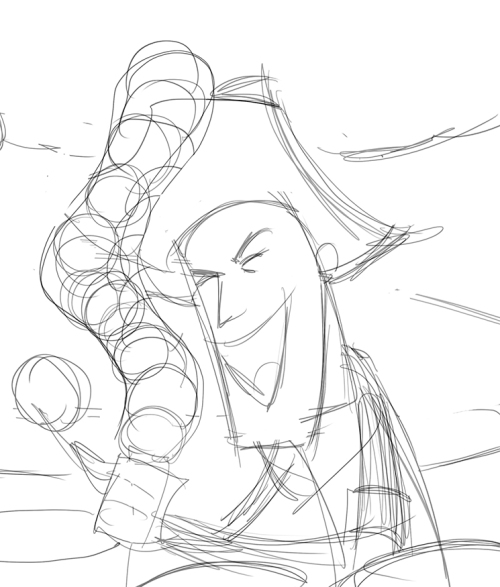
First, very rough, fast sketches trying to capture the energy, mood, emotion etc. Once I have a rough sketch I like then I keep tracing it and making revisions until I get to the final sketch.
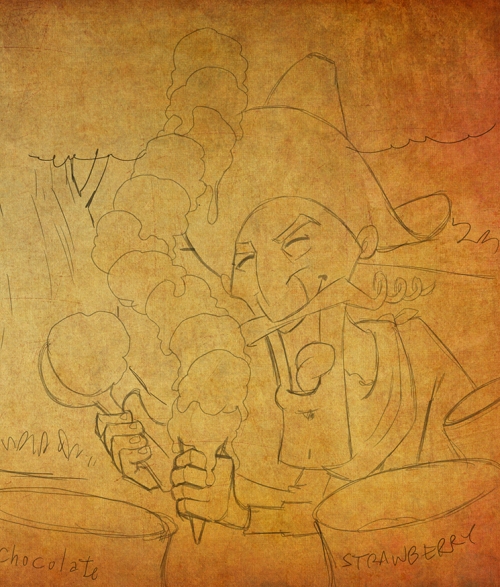
I put the final sketch on a medium value, textured background. I keep it on a separate layer so it can be removed later.
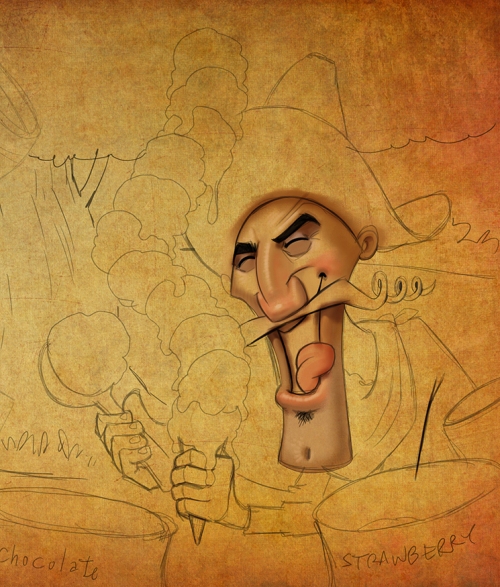
Starting with the face, I put down a thin, base skin tone letting the background texture show through. Then I start building up the dark tones adding just a little red color to the nose and cheeks and a few high lights.
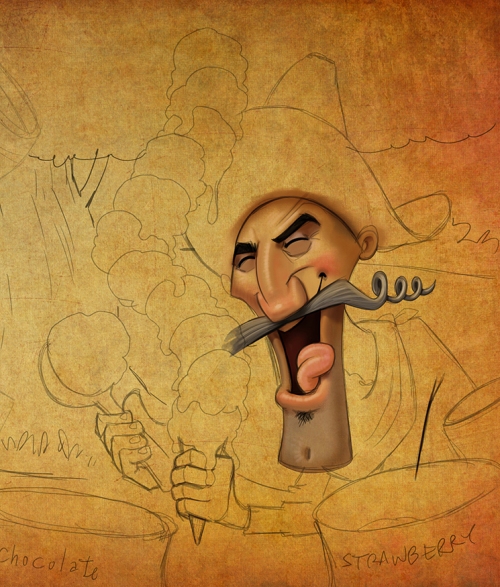
I keep building up the darks and start introducing some blues, purples and greens into the shadows.
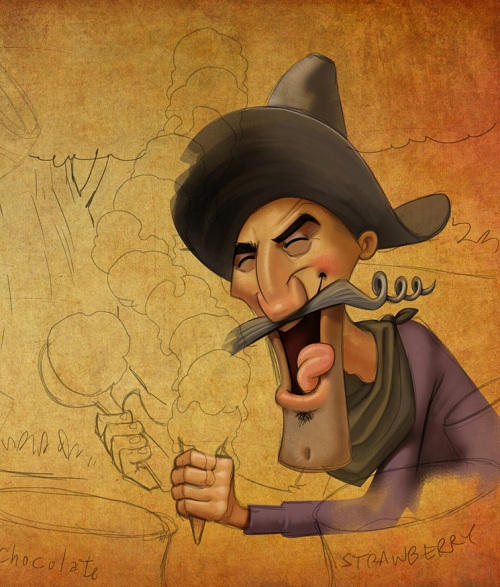
When I have the colors and values of the face where I want them, I’ll start on the rest of the figure working from light to dark.
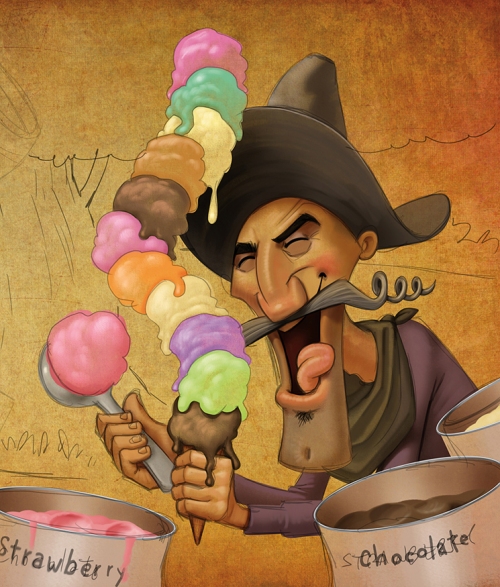
For the ice cream, I put down a medium tone trying to let the background texture show through. I then added a lighter color to one side and hit the other side with a faint shadow.
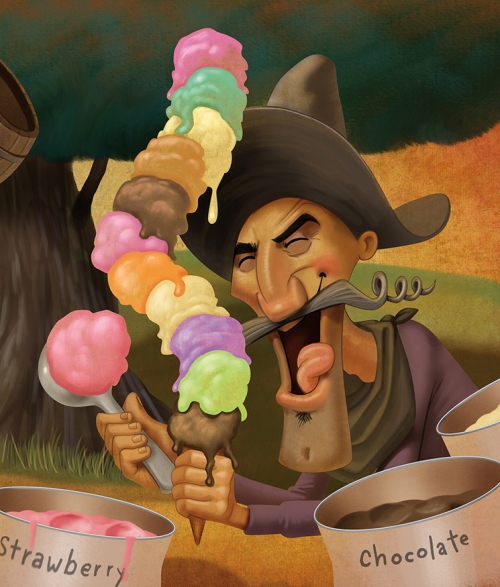
Lastly, I added the background, leaving some of the original texture untouched. I removed the sketch and then I add fine line detail.

Spaghetti Smiles by Margo Sorenson – published by Pelican Publishing Press (September 15, 2014). How many books have you illustrated for Pelican Publishing?
Spaghetti Smiles was just released and that was the fifth book I’ve illustrated for Pelican Publishing and I’m working on another right now.
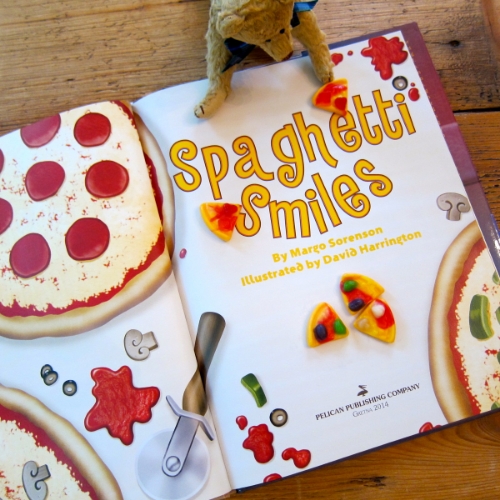
How long have you been illustrating?
I’ve been illustrating professionally for about 25 years.

How did you decide to attended At Center College of Design in Pasadena, CA to study fine art?
During high school I took some Saturday classes at Art Center and fell in love with the school.
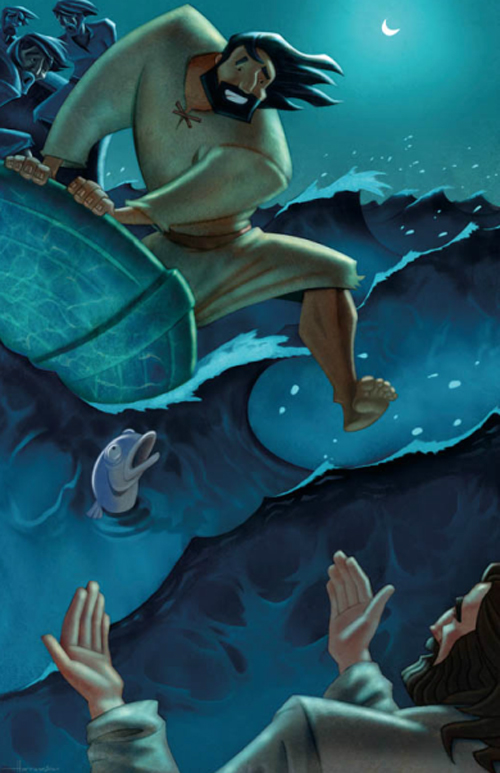
You say in your bio that figure drawing and painting were your favorite classes? Is that still a favorite thing for you to illustrate?
Absolutely, anytime there are figures in an illustration, whether they are stylized or realistic, it’s always fun and they bring life to the piece.
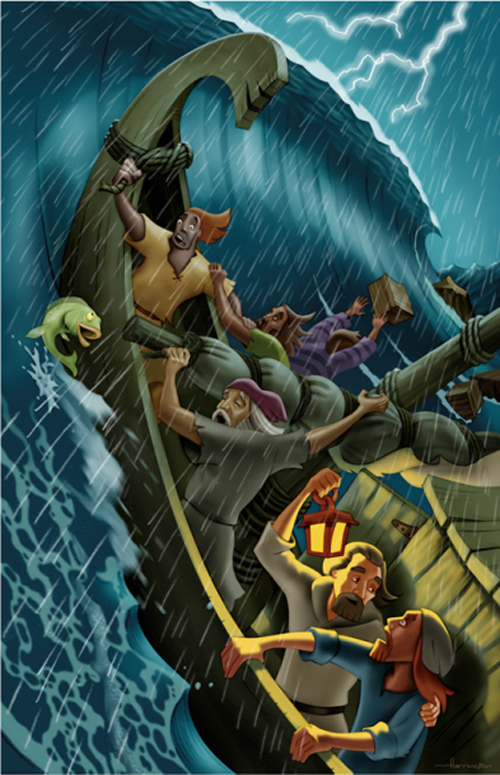
What was the first art related work that you were paid?
I painted store windows at Christmas time when I was a teen.
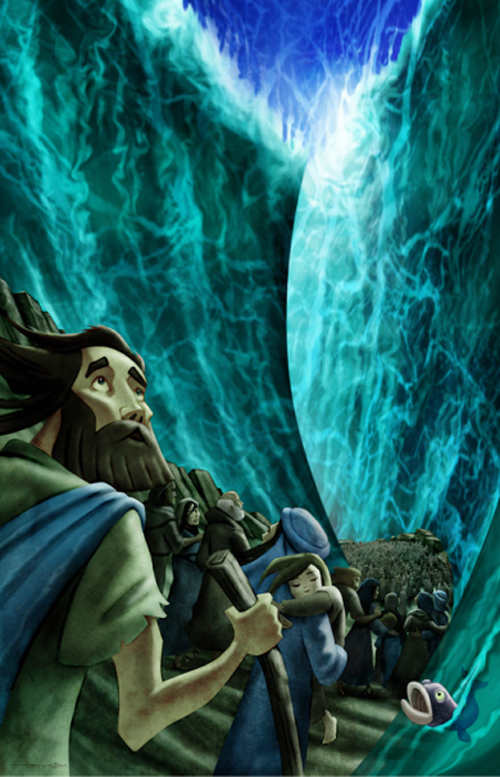
Did the School help you get work?
Yes they did, I got some work doing movie poster concept sketches for Warner Brothers right after graduation.

Do you feel the classes you took in college have influenced you style?
I don’t know, my style has been changing over the years.
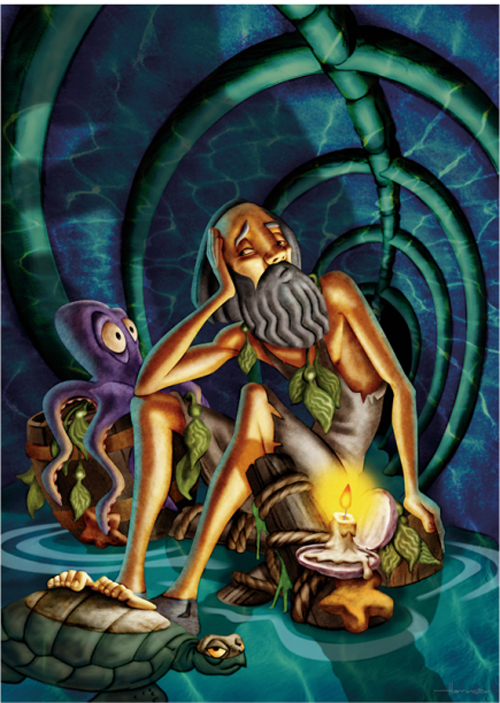
What type of work did you do right after you graduated?
About six months after graduating I took a full time job as an art director/illustrator at a small company doing mostly sports art.
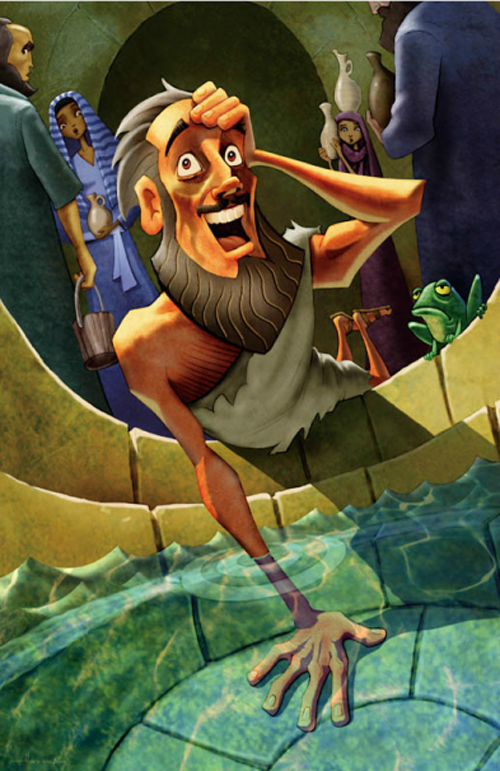
How did you make the decision to jump into freelance work?
I had been trying to make the transition to freelance by working at night but then when I got laid off unexpectedly from my full time job, I decided that -Now is the time.
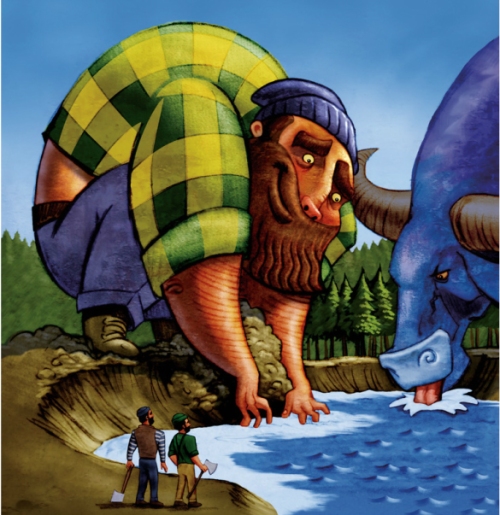
When did you decide you wanted to illustrate for children?
I did a lot of soft drink advertising work for a good client and he asked me if I could illustrate a Children’s book, so I gave it a shot- and loved it!
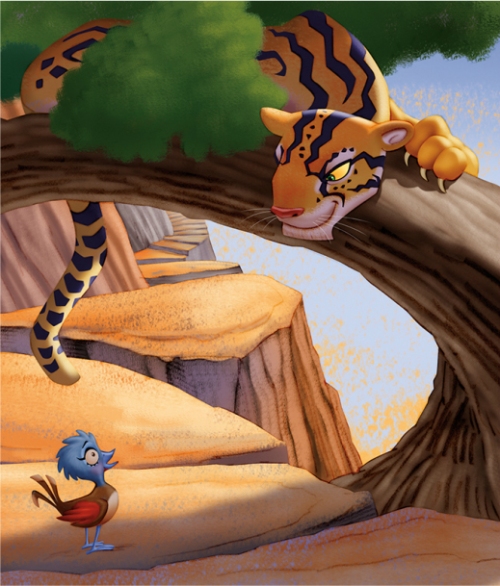
When and what was the first children’s book that you illustrated?
It was called Gabby, about a little girl and a science fair project that went wrong resulting in a giant bubble-gum monster.

Do you consider that book to be your first big success?
No, but it opened my eyes to how much fun Children’s book are to illustrate. I love creating characters.
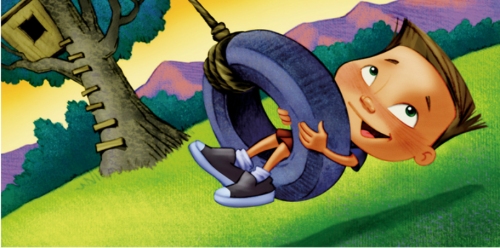
Do you have an agent or artist rep.?
No, I don’t have a representative but am not opposed to one either.
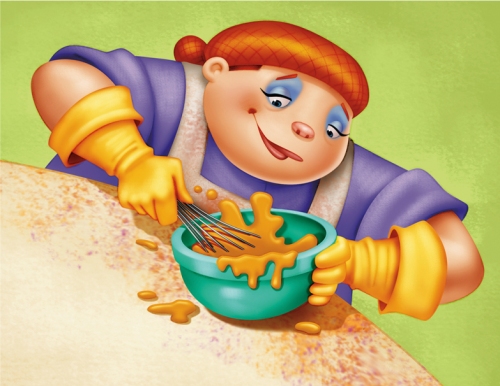
Do you have any desire to write and illustrate your own picture book?
Yes I have written some books and hope to be an Author/illustrator someday.
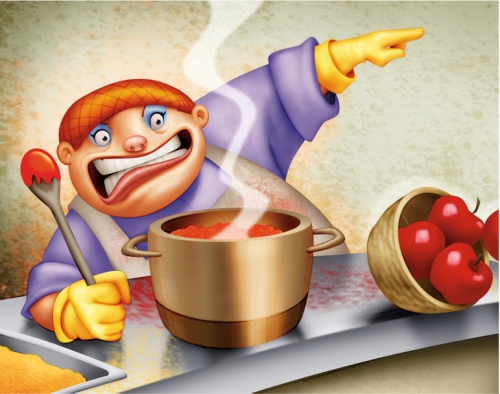
Are you the same David Harrington who does fantasy art?
No that is another David Harrington, although I have done some fantasy art over the years.

How did you get the contract to illustrate, Since We’re Friends: An Autism Picture Book at Sky Pony Press?
I don’t remember how I got that contract, but I remember it was two books.
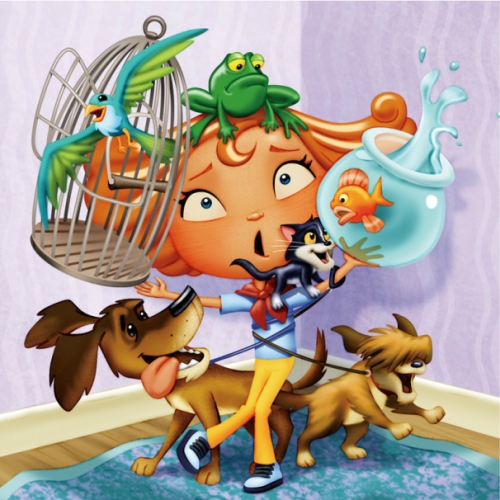
How long did you have to illustrate each one?
The whole process from sketches to final illustration takes about four to five months.
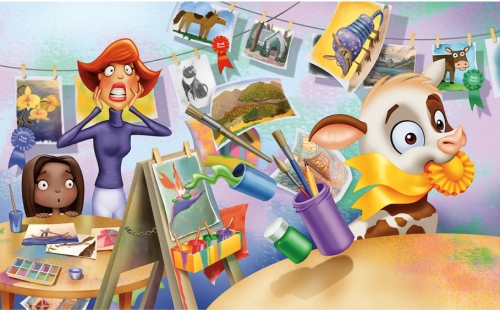
Would you be willing to work with an author who wants to self-publisher their picture book?
Yes I would if I like the story.
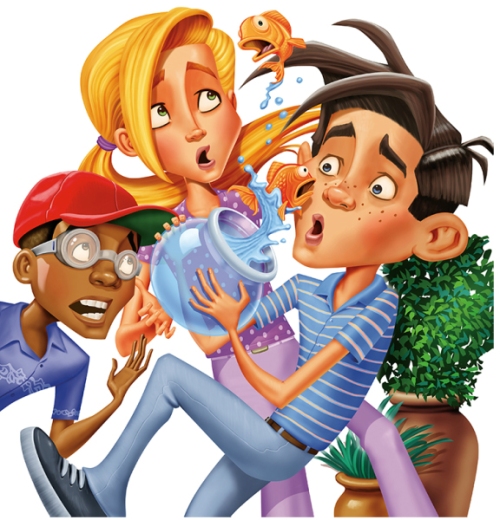
What illustrating contract do feel really pushed you down the road to a successful career?
I did about a dozen Book covers for Pee Wee Scouts from Random House and that led to more work.
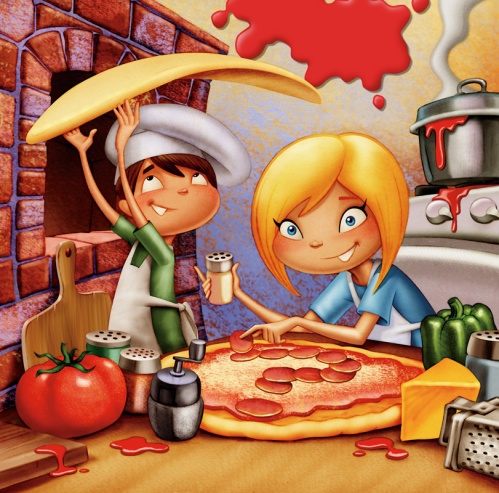
When is the title of the pirate book that you are working on and when is it coming out? Is that your next book that will hit the book shelves?
It’s a cowboy book titled Whistling Willie and should be released in the Spring of 2015.

Have you done illustrations for any children’s magazines?
Yes, mostly Club House magazine.
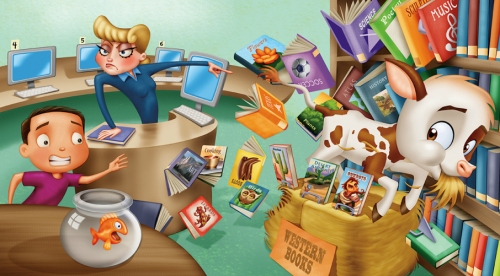
What materials do you use to paint your color illustrations?
Well it started with acrylic paint and pencils and over the years has transitioned to a Mac computer, graphic tablet and Photoshop.
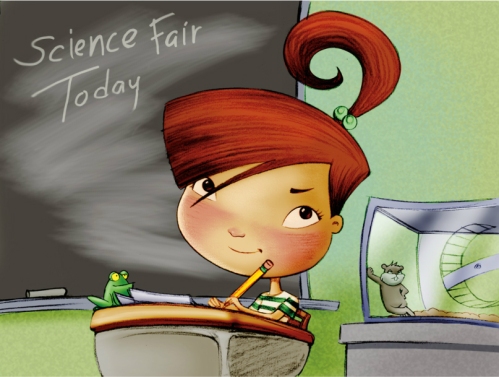
What types of things do you do to find illustration work?
Once or twice a year I send out promotional post cards to publishers. But word of mouth is how I get most of my work.

What is the one thing in your studio that you could not live without?
My Mac!
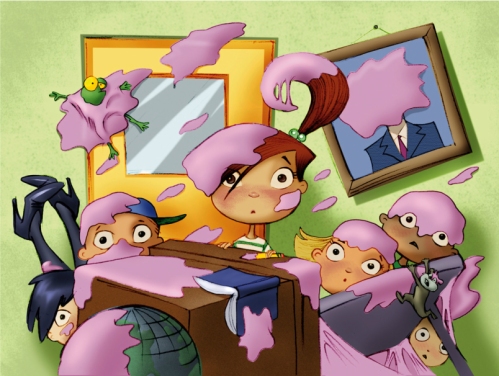
Do you try to spend a specific amount of time working on your craft?
I try to find time to experiment and learn new techniques or try different media. I love oil painting and sculpting!
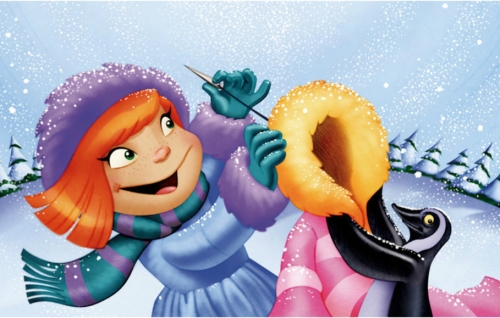
Do you take pictures or do any types of research before you start a project?
Yes I do a lot of on-line research and look for inspiration.
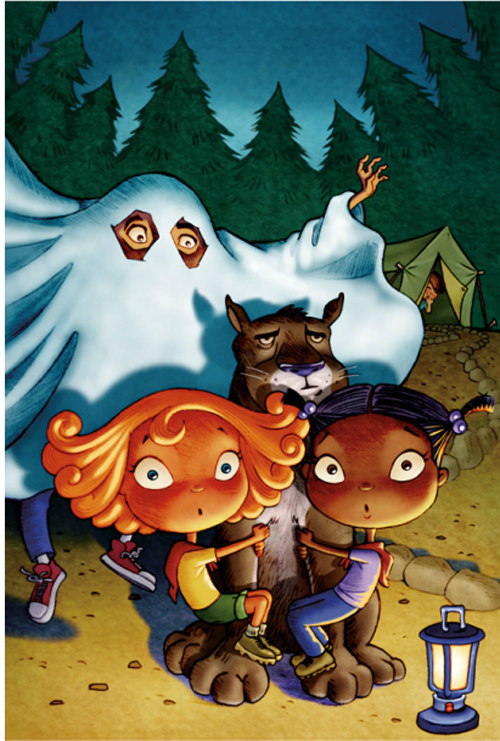
Do you think the Internet has opened doors for you?
Yes, it has changed everything about this business, from research to communication to the way finished projects are delivered.
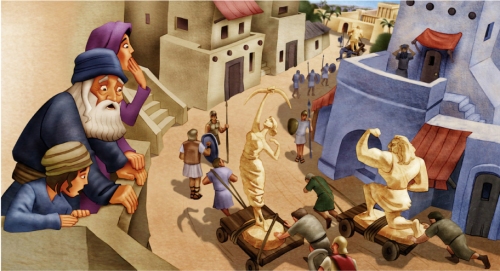
Do you use Photoshop, Illustrator, or Corel Painter with your illustrations?
Yes, Photoshop and sometimes Illustrator. I have tried painter and that’s a good program too.

Do you own or have you used a Graphic Drawing Tablet in your illustrating?
Yes, Wacom Cintiq, it’s amazing!
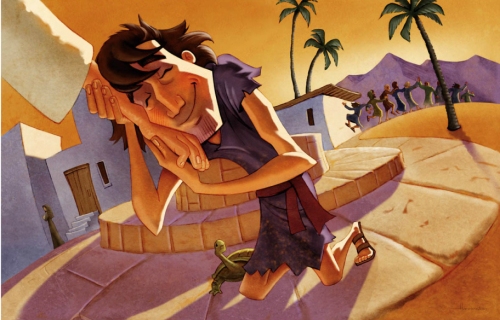
When did you start using the computer to paint your illustrations?
That was a very slow transition, about 15 years ago I would just add the final details to an illustration in Photoshop. Then at some point I would finish a painting half way and then complete it with the computer using a mouse. Now, all or almost all of the art is created using a Graphic Tablet.

What are you working on now?
Right now I’m jugging about 12 different illustration jobs including Whistling Willie from Pelican Publishing.

Do you have any material type tips you can share with us? Example: Paint or paper that you love – the best place to buy – a new product that you’ve tried – A how to tip, etc.
My favorite is Winsor & Newton oils on canvas, from Art Supply Warehouse in Westminster, CA
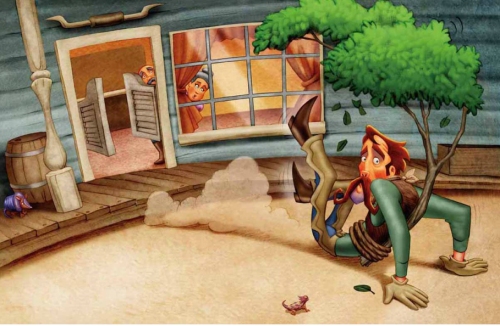
Do you have any career dreams that you want to fulfill?
Yes, I would like to illustrate the stories I’ve written.
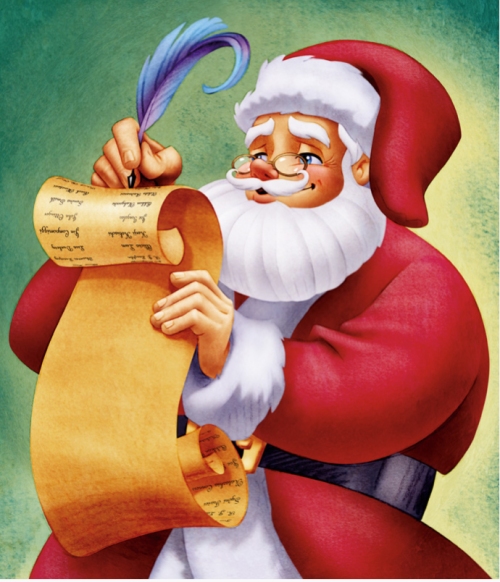
Any words of wisdom on how to become a successful writer or illustrator?
You must be persistent, never give up and always strive to improve.
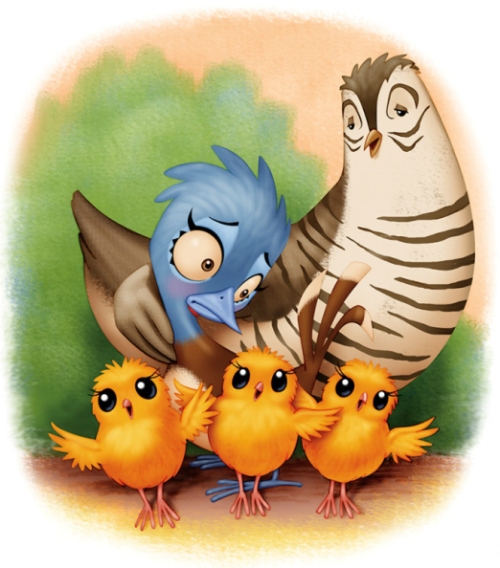
Thank you David for sharing your journey and process with us. Please let us know when your new picture book comes out , in addition to all your future successes. We’d love to see them and hear about them, so we can cheer you on. You can visit Daivd at: http://www.davidharrington.com/
If you have a moment I am sure David would like to read your comments. I enjoy reading them, too, even if I don’t always have time to reply. Thanks!
Talk tomorrow,
Kathy
Filed under:
Advice,
authors and illustrators,
demystify,
Illustrator's Saturday,
inspiration,
Interview,
picture books,
Process,
Tips Tagged:
David Harrington,
Spaghetti Smiles 


For many of us just saying “yes” can be a huge obstacle to overcome. The feeling of nervousness and anxiety can well up in the pit of our stomachs , our hand’s become sweaty and minds begin to race with the thought ” Can I actually do this and should I even do this?” when creative opportunity comes our way. In any shape, size or form I realise now that creative opportunity is something to be grasped, having been quite the shy and anxious inky illustrator for years I often said no to things that could have lead somewhere because I was afraid of whether I was good enough , brave enough and strong enough the list goes on.
Many of you may feel the same at any point during your creative journey whether you’re just starting out, given the opportunity to exhibit at a gallery, pursue a design internship, go to university, take a commission and more. Sometimes its a little daunting to say yes but here’s why seizing creative opportunity no matter how scary is good to :
- You don’t know where it may lead but it could lead to great things
- You don’t know who you might meet but you may meet someone great
- You don’t know how you will grow but you’ll build experience along the way
- You don’t know until you try
Try to think less about why it might not work and more about what you have to gain because this will help put your creative thought in a much more positive mind set to pursue each opportunity 100%. If you’ve been brave enough to seize a creative opportunity how did you deal overcome the fear and just say yes?
Image by artist Sean McCabe you can find more of his work here .

By: Kathy Temean,
on 10/1/2014
Blog:
Writing and Illustrating
(
Login to Add to MyJacketFlap)
JacketFlap tags:
Tips,
reference,
Advice,
Editors,
submissions,
article,
Elizabeth Law,
need to know,
5 Ways to Follow Up With An Editor or Agent,
Add a tag
I receive so many questions about what to do when you do not get a reply to what you submitted. I think we all will be interested in this article written by Elizabeth Law about how to handle the situation.
5 WAYS TO FOLLOW UP WITH AN EDITOR OR AGENT AND WHEN TO DO IT :
Waiting for a reply can seem like watching the tumbleweeds roll…
#1. Maybe an editor said something encouraging to you at a conference, and, as requested, you sent them your manuscript. Since then it has been radio silence. Here’s what you can do. After 10-12 weeks, follow up with an email, reminding him or her, “we met at XXX, you said you’d like to take a look at my story about XXX, and because 10-12 weeks have passed, I wanted to follow up. Here is my manuscript again, thank you very much for your time and consideration.” That’s right, attach the manuscript, don’t have the editor go hunting for your email from 10 weeks ago. This way they can click and start reading. If you haven’t heard back in another month, move on.
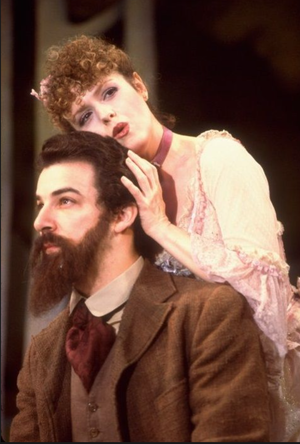
Mandy and Bernadette knew it in Sunday in the Park with George: you’ve got to Move On.
(In this case, move on means submit to the next person on your list, and don’t expect ever to hear back from the original publishing house. You don’t need to officially withdraw the manuscript. If by some miracle the first editor later says he or she is interested in your book, and you haven’t yet sold it, then great. But meanwhile you’ve taken your career into your own hands.)<img Mandy and Bernadette knew it in Sunday in the Park with George: you’ve got to Move On.”
Mandy and Bernadette knew it in Sunday in the Park with George: you’ve got to Move On.
#2. Regrettably, in this era, silence is the new no. Many literary agents have realized they don’t have the time to reply to every query they receive, so they’ve enacted a policy of “if you don’t hear from us in ___ weeks, assume we’ve passed.”
Here’s what to do when you’ve queried and agent and the allotted time to hear back has passed: MOVE ON.
Waiting for just the right literary agent or editor to say yes to you is like being in 7th grade and waiting for just the right boy, the one you know is perfect and you will spend the rest of your life with, to ask you out. You are much, much better off moving on to the guy standing right next to him in the lunch line.
This is also a good rule for a publishing house accepting unsolicited manuscripts, and for editors or publishers who are accepting submissions for a certain period after a conference. If you don’t hear back from them after 12-16 weeks, assume it’s a no and move on.
#3. You have signed with a literary agent, but they aren’t getting back to you. Maybe they don’t return your calls, maybe they don’t answer your emails. Everyone slips up now and again, of course, and that’s not what I’m talking about. Have you left a few messages in a row for your agent, either by email or phone, and not gotten a reply? Has that happened several times? End the relationship. The LAST thing you want is an agent who doesn’t return your calls or emails. The publishing process is frustratingly slow and thorny and fraught with all sorts of issues. Your agent is your champion; he or she goes into battle for you. You do not want to be in that battle not knowing when your weaponry is going to show up. Send an email and say you’re terminating the relationship. Do it now.
(And don’t be scared. Most agents are excellent. But I get asked about this every few months, so I’m including it.)
#4. An editor tells you he is taking your manuscript to an acquisitions meeting, then you don’t hear anything further. Follow up, by phone or email, remembering the rule, “always be polite and to the point.” Say “You said you were bringing my book to the committee, has there been a response?” I know, I know, who wants to send that email and hasten the chance of hearing “I’m afraid the committee passed?” But it’s better to hear “no” and move on. It’s also possible your editor needs to be prodded to get that book onto the meeting agenda. You just don’t know. You need to follow up.
Nota bene: ALWAYS be nice. Never lose your cool and yell at an editor, even by email, even when he deserves it. First, you never know the full story—I got screamed at, really screamed at, once when it was my boss causing the delay, but what could I do but take the heat? And second, venting is what you have friends for. The editor is disorganized, doesn’t value your time, has kept you hanging, repeatedly breaks her word about when she’s going to reply… all true. Still, be professional, courteous, and polite. For one thing, when a writer is nice and understanding, we, the editors, only feel more guilty and determined to treat you well and to finally get you an answer. Secondly, one day you may need that person you just reamed out. He may be sitting in the audience at sales conference, and be able to tell a rep “Oh, I know that author, so talented.” Or you may end up sitting next to that editor on a panel at a conference, who knows? Don’t burn bridges. Act professionally and then go out for drinks with your BFF and get it all off your chest.
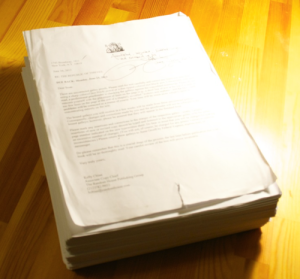 #5:
#5: Perhaps your book is under contract,
but your editor isn’t getting back to you with editorial notes, or with anything else. You want to revise, you have another book you need to work on, and you need to know what’s going on. But although you’ve emailed the editor three times to ask about the book’s schedule, you hear nothing. If you have an agent, easy, just tell the agent and he or she will deal with it. (Unless the agent doesn’t return your calls, in which case, see #2). But if you don’t have an agent, and you aren’t hearing back from your editor? Email their boss. Yup. Email the publisher, remembering to be professional and concise, saying “
I haven’t had an answer to my questions about the book’s schedule and I’m getting worried that my revision might conflict with another project; of course I understand how busy my editor is, but I wonder if you have information for me?” The publisher then forwards it to the editor who deals with it immediately.
Filed under:
Advice,
article,
Editors,
need to know,
reference,
submissions,
Tips Tagged:
5 Ways to Follow Up With An Editor or Agent,
Elizabeth Law 

.jpeg?picon=3498)
By: Cait,
on 9/25/2014
Blog:
Cait's Write...
(
Login to Add to MyJacketFlap)
JacketFlap tags:
tips,
running,
motivation,
art,
goals,
nutrition,
injuries,
training,
cross training,
Add a tag
Within every runner live the Yin Yang twins…the grinder and the ice-cream loving, sloth who lives to watch cartoons. We’ll call the latter the ‘recovery champ’.

While I jest, because it’s not just ice cream they love but pizza, donuts, burritos, french toast [insert runger fantasies here], there is truth to it.
In order to run hard you’ve got to allow your body to recover just as ‘hard.’ It often takes runners awhile to learn this, often the hard way. Typically everyone goes through the stage where they race every run, a run doesn’t count unless you’ve maxed out, right?!  While this usually leads to improvement in the short term, eventually going hard every day will lead down the road of an injured, over-trained, mess.
While this usually leads to improvement in the short term, eventually going hard every day will lead down the road of an injured, over-trained, mess.
Without adequate recovery you’ll be too tired to actually run fast. Easy days are important, as are other ways to speed up your recovery. In order to NAIL the days that count, your hard workouts and races, you’ve got to ensure your muscles are able to rebuild and repair themselves between hard sessions.
So there IS an excuse to laze around in your sweats and hit up a Netflix marathon.  Recovery is more than just an easy day too, for most mortal runners of the world running isn’t your job so lifestyle choices and how you spend the non-running hours of your day will play a big role in your ability to recover.
Recovery is more than just an easy day too, for most mortal runners of the world running isn’t your job so lifestyle choices and how you spend the non-running hours of your day will play a big role in your ability to recover.
Even for the elite runners, they are continually looking for ways to improve their recovery…because chances are there is ALWAYS room for improvement somewhere.
Take a look at your own habits and look for areas you know you could be better at. I’ve made a handy little checklist to give you some ideas of where to start:
* Make sure your easy days COUNT: rely on effort, don’t wear a watch if you have to, you should be able to hold a conversation between breathes on these runs.
* Proper Workout Scheduling: every runner needs to learn their body and how many hard workouts they can handle in a week. As we age we need to learn how to adjust, that may mean turning your ‘week’ into a 10 day cycle.
* Cross Training: I did a whole post HERE about how to maximize training if you know your body can’t handle too many running miles. Cross training on your easy days or as a ‘second run’ can help keep you healthy and allow for an ‘easier’ workout for recovery purposes.
* 30 Minute Refuel: eat a combo of protein and carbs IMMEDIATELY after your runs…especially your hard workouts. Miss this window and recovery rates drop upwards of 60%.
* Nutrition: eating to perform means opting for quality foods, timing them around when you run, and ensuring you get enough nutrients. This means protein, carbs, healthy fats, and overall enough calories to fuel your training demands. Eating to perform also means LIVING, if you’re training hard enough and want a freaking donut, you’ve earned it. Balance comes into play, so I’ll use the analogy of a silo. Fill your body with all the quality nutrients first, then any extra ‘energy demands’ needed to fill the rest of the silo should be up to you. A world without french toast is a dark one.
* Self massage: whole post on that HERE, flush out that lactic acid, keep your body knot-free.
* Hydrate: this is incredibly important regardless of the season, obviously hotter weather requires you to hydrate more and with electrolytes but even in a snow storm you’re losing moisture. Drinking after massage is also important to flush out all that ‘junk’ worked out of your muscles.
* Stretching: tied into self-massage, stay loose, limber, and avoid injuries.
* Time on Your Feet: it’s draining on your legs and energy-zapping, if your job requires you to do lots of ‘work’ know that you may need to adjust your training or learn how it affects you.
* Time on your butt: yea it’s important to rest, BUT office jobs can lead to problems too…too much sitting leads to weak glutes, tight hamstrings, and reduced blood flow. Not good for recovery, so be sure to move around and at least walk around a bit between Netflix marathons.
* Sleep: while I may leave this one for last, this is HUGE!! Sleep is when the body REALLY restores and repairs itself. Skimping on sleep will hamper your recovery, professional runners guard their sleep time and usually take naps too. Make sleep a priority. For those with sleeping problems and insomnia (ugh, join the party!) look for ways to improve the situation or figures out what can sometimes help. Restless nights add up to tired legs and eyebags. 
I think that’s a solid list of ways to improve your recovery habits. Start cracking! To let that grinder perform at it’s best, that recovery-er needs to be doing it’s job right too! 
—–
New ART is listed and available for prints on my page there…restructured to make things a little easier. As always, anything not shown, email me a request and I’ll get you a print.
—-
1) What are some ways you make recovery a priority?


Everyone’s creative story is different because we are all unique and completely individual in our own way, meaning nobody’s creative journey is exactly the same. Some of us may know early on that we are destined to be creative and set to pursue our career through college and university, where as there are other people who discover their creative meaning deep down later on like a seed that needed time to grow. Over the years I’ve come across some very talented people, many whom have spent time in art education and some who are purely creatively self taught.
The question that has often come to mind though no doubt for those of you who may have self taught your practice is “does it matter whether you have an art education background or whether you’re self taught?” Many people are going to have mixed opinions on this topic and there are sometimes pros and cons to both, but whether you are self taught or have had the opportunity to study in education here’s my two cents on why I still think you’re creatively amazing whichever path you take.
1. You’ve followed your own creative path in a different way and you should be proud of how far you’ve come and excited of where you’re yet to go.
2. The opportunity for development and learning is endless , there’s no race to the finish in either circumstance so invest in yourself and build on who you are.
3. Don’t think so much that you’ve missed out on opportunities in the past, just look to the future, what you aspire to achieve and have to share.
4. You can draw just as good as the next guy but remeber that like our artwork we’re all works in progress.
5. You’ve got your eye on the end goal and inside have creative idea’s and potential that someone else has yet to imagine.
Image by Artist Fredrik Rattzen you can find out more about their work here .

By: Kathy Temean,
on 9/17/2014
Blog:
Writing and Illustrating
(
Login to Add to MyJacketFlap)
JacketFlap tags:
Tips,
list,
reference,
picture books,
Advice,
authors and illustrators,
Dilys Evans,
How to,
Guide to Evaluate a Picture Book,
How to Spot a Great Picture Book,
Add a tag
 Dilys Evans has been providing advice to young artists since 1978, when she founded Dilys Evans Fine Illustration.
Dilys Evans has been providing advice to young artists since 1978, when she founded Dilys Evans Fine Illustration.
Below is a summary of that advice—10 characteristics that she believes all outstanding picture books have in common.
Use it as a guide as you evaluate the picture books in your collection.
1. In the Beginning Was the Word
The pictures must be truly inspired by the story.
2. Preparation Is Paramount
The artist knows his or her characters, subject, and the setting inside and out.
3. A Great Cover Is a Great Start
If the cover art is compelling, it will make the viewer pick up the book and turn the pages.
4. The Artist Sets the Scene before the Story Begins
The inside flap offers a great opportunity to set the stage for the story or introduce a character.
5. The Endpapers Involve the Reader
Endpapers are another opportunity to add to the story or overall design of the book.
6. The Medium Is the Message
The perfect choice of medium to illustrate the text should convey every mood and nuance.
7. Every Picture Tells the Story
Every image is central to the story and moves it forward to the next page.
8. The Book Is a Form of Dramatic Art
Every scene must be carefully chosen to dully illustrate the drama and excitement of the story as it unfolds.
9. Art and Type Should Be a Perfect Marriage
The typeface should seem to be almost an extension of the art itself.
10. White Space Rules!
White space is a compositional element and not just a background to present the art.
Printed by the School Library Journal, September 2005
Talk tomorrow,
Kathy
Filed under:
Advice,
authors and illustrators,
How to,
list,
picture books,
reference,
Tips Tagged:
Dilys Evans,
Guide to Evaluate a Picture Book,
How to Spot a Great Picture Book 

.jpeg?picon=3498)
By: Cait,
on 9/11/2014
Blog:
Cait's Write...
(
Login to Add to MyJacketFlap)
JacketFlap tags:
tips,
running,
shoes,
injuries,
training,
exercises,
strength training,
stretching,
ask me,
Add a tag
I always love getting mail from readers and I often get questions which, because I could talk/write/draw about running all day, I’m always happy to answer. The other awesome thing about bloggy-land and our cyber-culture is constantly making new friends. I enjoy hearing updates back from the runners I’ve ‘met’ after they’ve sent questions and it’s always cool to watch them go on to run healthy and set new PR’s.

Well because great minds think alike, or at least I’m certain questions I’m emailed are ones others probably have, I decided to share a few. If you’ve got a questions feel free to email me at: [email protected]
Without further adieu:
Q: Hi! Do you do your calf strengthening exercises before or after running or on days off? Just curious… I am 45 and returning after a 2 month hiatus. After a 14 day streak (7 @ 20 min and the 7 @ 30 min, my calfs are starting to get cranky)
Do you think everyday is good for us over 40 runners or should I be taking days off?
Thank you so much. Your pages are very helpful?
~ Dan in Portland, OR
A: Hi Dan! Thanks so much for your readership! First off, CONGRATS on finally getting back to running!!
As for your questions: I’d suggest doing the strengthening exercises every other day, but do lots of stretching every day. Always post-run on both of those, for the stretches do the standing wall stretch both standing with your leg straight and and then with a slight bend in the knee, that will work both calf muscles. Also do one with a heel drop, so stand on a stair and just let your heel drop, slowly working deep into that achilles stretch.
As for your running, every single person is different, so it’s a matter of figuring out your running ‘sweet spot’. For now, with being cautious for your cranky calfs, tailor back to 4-5 days and you can totally do some cross training that doesn’t bother it. Then as the calfs calm down, gradually try increasing total time running, be that either running longer OR with added days running. Aim for only increasing 10% total miles each week, then let those calfs be your guide.
Finally, don’t overlook that the body is a whole unit, so be sure to check out if you’ve got other imbalances that could be setting you up for calf pain, and stretch the whole body. Check your biomechanics and you might need some insoles for added support. Also, make sure you’re running in the right shoes and they’re not ‘dead’…you’d be surprised how ‘easy’ things like needing to replace your shoes can totally clear up your symptoms!
Hope that helps, sorry for the novel reply, and say HI to Portland for me…miss that awesome city!
Happy Running!!
Cait
—-
Related Reads:
The Imbalanced Runner: Pinpoint your weaknesses and avoid injuries
The Low Mileage Runner: How to maximize your performance off of low volume
3 Ways Running Can Fly By and 500 Reasons to Update Your Running Shoes

.jpeg?picon=3498)
By: Cait,
on 8/30/2014
Blog:
Cait's Write...
(
Login to Add to MyJacketFlap)
JacketFlap tags:
tips,
running,
goals,
training,
cross country,
workouts,
hill running,
treadmill running,
cross training,
Add a tag
Runners are constantly climbing. It’s in our nature to always have a goal we’re working towards, always wanting to push ourselves to do better. Whether it be chasing new PR’s, challenging yourself to expand your race distance range, or even after we’re past our ‘PR-PR’ years, redefining the times and bests (weekly, yearly, masters, etc.) bests.
Diversity. Fitting as it is now cross country season that we talk about diversifying your running and climbs. Cross country thrives on both. I’ve done posts on just how awesome hills are at improving your strength and power, which translates to speed. What I haven’t talked too much on are prolonged hill climbs.
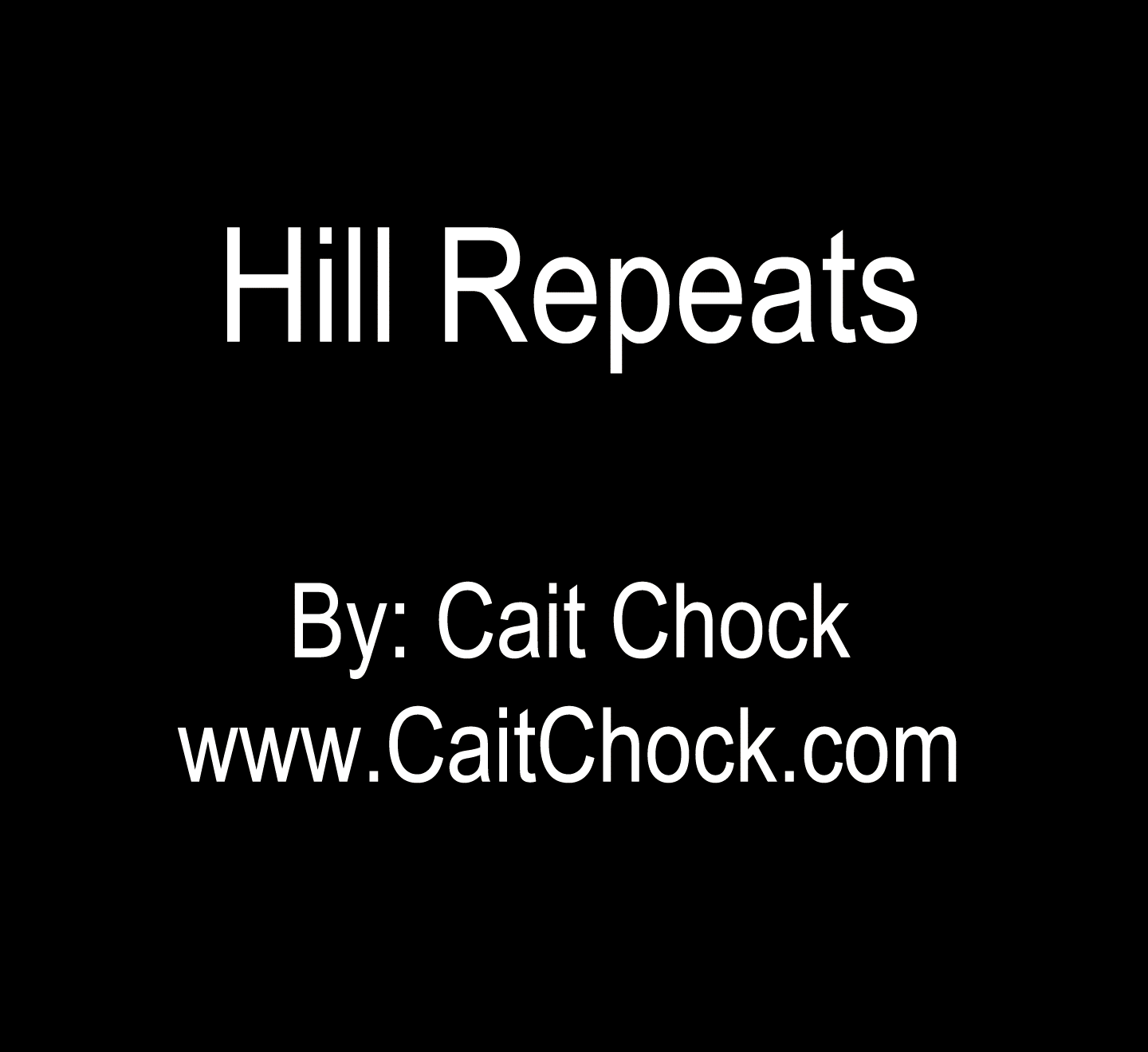
The long climb, yup. We’re talking taking your tempo runs to the trail, or inclined treadmill if you don’t have a stretch long enough outside. I’ve previously featured the man-beast that is Michael Wardian and he’s no stranger to treadmill running.
While he’s one of the World’s best ultra and trail runners, a major chunk of his miles are done on the treadmill so he can fit his runs in around his family’s (namely his kids’!) schedules. Wardian loves a good, long climb.
He makes sure to do hill work a few times a week and, “for me that means hours of running up vertical inclines, sometimes fast, sometimes just a long grind, but always pushing to get better.” Wardian is an ultra runner after all.
Another big fan of prolonged uphill runs is Sage Canaday, a staple workout for him is an uphill tempo run. Canaday is another World leading ultra runner [check out my feature on him HERE], residing in Boulder, CO he has no shortage of trails to mountain goat up.
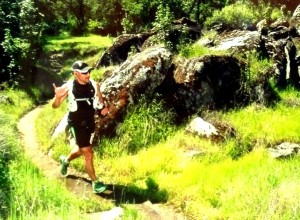
Yo, that’s my rockstar dad running 50 miles! :)
Even if you’re not one of the best in the World, taking advantage of prolonged hill climbs will benefit you.
Coach Brad Hudson of the Hudson Training Systems, coaching both elites and all levels of runners, regularly incorporates uphill tempo runs for his runners.
Try It:
Take your next scheduled tempo run to a hill, keep the distance the same and adjust based on effort. [Captain Obvious: Your times aren't going to mean much, so go off of effort.] I’d suggest going 4-5 miles.
No hill? No problem…take it to the treadmill. For a moderate climb set the grade to 4% for your tempo run and again, go off of effort. Do your warm-up and cool-down at 1.5%, as that’s the equivalent to running outside on the flats…after you jack that incline up and finish your tempo run, upon lowering you’ll see just how much ‘easier’ the same pace will feel at 1.5%!
If you’re looking for a steeper incline, Captain Obvious tells us you can just elevate the treadmill. 
Another twist courtesy of Coach Hudson would be to make your hill climb tempo progressive, begin the workout at a 2% grade and have it up to 6% by the time you finish.
Life’s a climb after all. For runners, we take that both figuratively and literally. 
——–
More workout posts HERE
Need some motivation to get ‘er done…look HERE
Sweat hard, recover hard… #SweatsintheCity style, Baby!
——–
1) Are you running cross country season?
2) How do you incorporate hill work into your training?
3) Have you done incline tempo/threshold work?


By: Kathy Temean,
on 8/25/2014
Blog:
Writing and Illustrating
(
Login to Add to MyJacketFlap)
JacketFlap tags:
Tips,
writing,
inspiration,
Advice,
Process,
revisions,
article,
Guest Blog Post,
Erika Wassall,
When to Stop Writing,
Add a tag
 When Do Writers Stop Writing? by Erika Wassall
When Do Writers Stop Writing? by Erika Wassall
So we’re writers… right?
We write…
And we write…
And then we write some more.
The problem is, sometimes it’s hard to STOP writing and say… okay, it’s done.
Don’t get me wrong. I don’t mean “Done” as in you’ll never alter anything about it ever again. My title is of course not realistic. We never stop writing. And we’ll revise again and again with editors or agents.
But at some point, we have to decide, it’s ready to be submitted.
This is tough for a lot of us. We may have been working on something for years, and it’s evolved, morphed and been not just revised but re-envisioned (a term I took from Jill Corcoran’s videos) so many times. And each time, it’s become better, stronger and more complete.
We could go on with that forever, and it would just keep getting better… right?
But there is a line. There comes a point where we have to make the leap of faith and start submitting our work. Sometimes easier said than done.
I can’t tell you when your work is done. I’m not sure anyone can. Some people are lucky, they can just “feel it”.
Me? Sigh. I wish.
Not at all. I’m ALWAYS left thinking… maybe one more person’s critique will help, or maybe one more re-write of the this paragraph will be even better!
I like to have a checklist. It gives me a good basis for being sure I haven’t missed anything major:
1) First round of revisions – this is usually checking for consistency and flow, because my first drafts are a bit… rough.
2) Time off – serious time off, usually a month
3) The big change – almost all of my manuscripts have at some point had some major change or revision that has made things click. Some have had more than one. For me, it’s an important part of my process.
4) More revisions and feedback from other writers and people I trust.
5) Falling apart at some point and thinking it’s not any good. For me, if this hasn’t happened at least once, I’m not done. This usually leads to another short spurt of time off, a week or so of ignoring all writing-related thoughts.
6) The writer in me wins out and I dive back in.
Then I usually sit here in this stage for a while, bouncing around in revisions, critiques, thoughts etc. Problem is: me? I could sit here forever. At some point, I just have to pull the darn trigger!
If I can look back and know that I did right by myself and the story I have to tell, it’s time to start narrowing down the list of agents I’m going to target.
Plus, at this point, I usually have a few new ideas percolating in the brain, so they’re a good distraction to keep myself from revising that sentence just one more time.
Am I saying this is a good checklist for other people?
NOT AT ALL.
I think everyone’s checklist/process is different. But I do think it can be helpful to have some sort of checklist in your mind, to go through whatever steps you need as a writer and individual to make your manuscript the best it can be.
I have one final step after the checklist. This is usually the only way I’ve ever able to draw that intimidating line of saying IT’S READY NOW:
Create a deadline!
I can never quite get to the point where I say, “It’s done NOW.” But I AM able to say, “It’ll be done in a month.” And then stick to that.
And then I have to just tell myself, that’s it. It’s ready. I have to trust myself and commit that that’s my Final Answer.
An exciting time for sure, but finishing a manuscript and sending it out into the world often holds it’s share of anxiety of uncertainty. But it’s an important part of the process and guess what…
… your manuscripts deserve it!
Thanks Erika for another valuable post.
Erika Wassall is a writer, a farmer and a liver of life. She is a member of SCBWI and a proud Mad Scientist, bringing science experiments right into children’s classrooms, and hearts. She has a small farm in New Jersey with sheep, chickens, pigs and vegetables. Check out her new website at www.TheJerseyFarmScribe.com where as a first generation farmer, she often takes the long way, learning the tricks of the trade on The Farm. On her website is also The Shop page with tips and a free Q/A from her husband’s mechanic shop, and The Writer page where she shares stories, experiences and characters from the heart. Follow her on Twitter at @NJFarmScribe. She’d love to hear from you!
Talk tomorrow,
Kathy
Filed under:
Advice,
article,
inspiration,
Process,
revisions,
Tips,
writing Tagged:
Erika Wassall,
Guest Blog Post,
When to Stop Writing 


By: Kathy Temean,
on 8/15/2014
Blog:
Writing and Illustrating
(
Login to Add to MyJacketFlap)
JacketFlap tags:
Catch the Cookie,
Yale Graduate School of Art,
Interview,
Tips,
inspiration,
Advice,
Process,
David Small,
Caldecott Medal,
Illustrator's Saturday,
Sarah Stewart,
Add a tag
 I noticed that illustrator David Small’s new book, Catch That Cookie was hitting the bookshelves on August 14th, so I contacted him to see if he would like to be featured on Illustrator Saturday. He will be doing a book tour in September, so I’ll make sure I tell you all the ins and outs as soon as I know them. It will be a great opportunity to meet him and Hallie Durand, if they are coming to a bookstore near you.
I noticed that illustrator David Small’s new book, Catch That Cookie was hitting the bookshelves on August 14th, so I contacted him to see if he would like to be featured on Illustrator Saturday. He will be doing a book tour in September, so I’ll make sure I tell you all the ins and outs as soon as I know them. It will be a great opportunity to meet him and Hallie Durand, if they are coming to a bookstore near you.
Here is a little bit about David:
David Small was born and raised in Detroit. In school he became known as “the kid who could draw good,” but David never considered a career in art because it was so easy for him. At 21, after many years of writing plays, David took the advice of a friend who informed him that the doodles he made on the telephone pad were better than anything he had ever written. He switched his major to Art and never looked back. After getting his MFA at the Yale Graduate School of Art, David taught art for many years on the college level, ran a film series and made satirical sketches for campus newspapers.
Approaching tenure, he wrote and illustrated a picture book, “Eulalie and the Hopping Head”, which he took to New York, pounding the pavements and collecting rejections for a month in the dead of winter. “Eulalie” was published in 1981. Although tenure at the college did not follow, many more picture books did, as well as extensive work for national magazines and newspapers. His drawings appeared regularly in The New Yorker and The New York Times. A learn-as-you-go illustrator, David’s books have been translated into several languages, made into animated films and musicals, and have won many of the top awards accorded to illustration, including the 1997 Caldecott Honor and The Christopher Medal for “The Gardener” written by his wife, Sarah Stewart, and the 2001 Caldecott Medal for “So, You Want To Be President?” by Judith St. George.
“At the Caldecott ceremony in San Francisco,” said David, “facing that veritable sea of smiling faces — of librarians, of friends in publishing, of my family and other well-wishers— I was so overcome that I lost my voice and croaked my way through the speech. Having been turned from a frog into a prince by the American Library Association, before their eyes that night, I turned back into a frog.” To date he has illustrated over 40 picture books. At an average of 40 pages per book, that makes around 1,840 illustrations, though someone ought to check that math. Currently David is working on a graphic memoir about his problematic youth.
David Small and Sarah Stewart make their home in an 1833 manor house on a bend of the St. Joseph River in southwest Michigan. David’s studio is an 1890 farmhouse also overlooking the river, just a short walk from home.
Here’s David discussing his process for the cover of his new book, CATCH THAT COOKIE written by Hallie Durand:
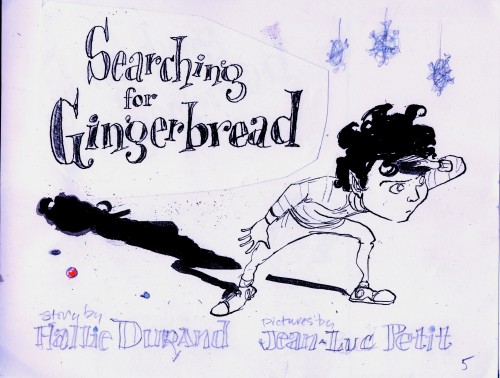
Every picture-book has its unique set of problems in the making of it. This one had relatively few worries on the interior art but, what we didn’t know was: we had a long hard struggle coming up, trying to find a good title and a good jacket design as well. This was a first jacket sketch, from back in the summer of 2013, when the working title was “Searching for Gingerbread”, which nobody liked.

By December, Holly had come up with a great title. I still clung to that original pose for the Kid but, as you can see from my inked notations, we were already discussing a different attitude, one without the theatrical “Scout-Searching-the-Plains” hand over the eyes.

Here the Kid’s pose is more dynamic, but still something was wrong. Nobody thought the Kid should be able to see the Cookie. They were right: it made it look like an uneven match.
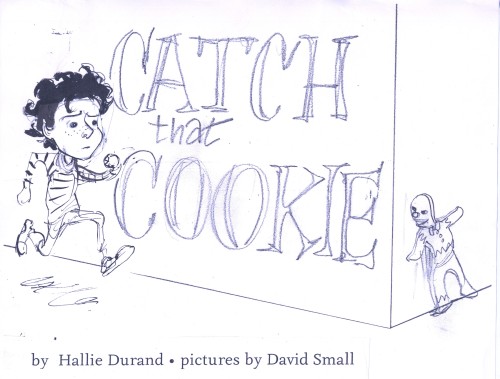
Here their positions are reversed. The hiding cookie seemed okay, but the Kid has no verve. The thrill was going out of this jacket project. By now, six months had passed. It was February 2014, I was working from my studio in Mexico, and our deadline for a jacket was coming up very soon. We decided to get the creative juices kick-started by taking a radically-different approach. (We had no idea what that approach would be, only that it had to be radical. [Slide #4a:] Lily (the Art Director) and I decided to comb over some old movie posters for dynamic image ideas. Here is Mark Wahlberg as “Max Payne.”
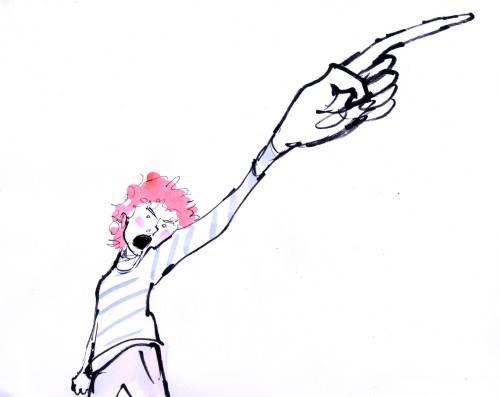
…. and here is the Kid saying: “Stop right there, you darn cookie! Put your doughy little arms up or suffer maximum pain!”
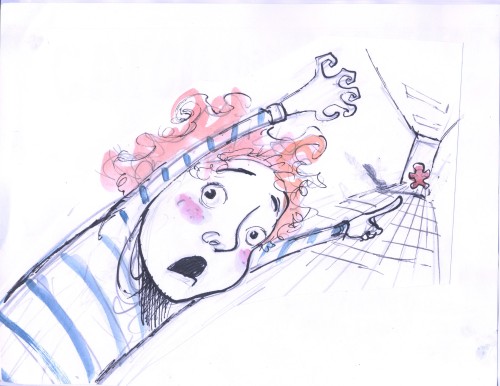
Another wrong direction. The illustrator’s panic shows in the whole pose. I and Lily, Holly and two editors– were working every day, all day and often into the night on this. We had passed the deadline long ago and were nearing the drop-deadline. We had to find another way!

Some smart-thinking person (not me,) had come up with this “WANTED” poster for the back jacket. Another person (also not me,) decided it might work as the front jacket.

For several days we went with that, but nobody was getting buzzed. This one had too much text to read …
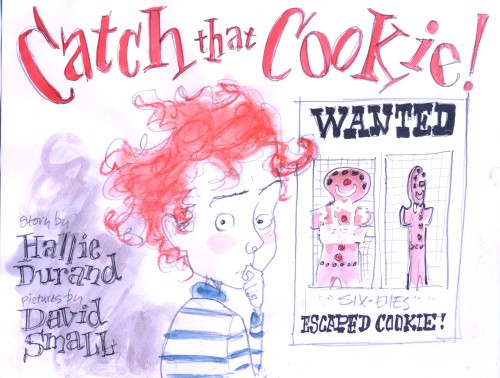
…this had less text but still no “Grab-Me-Off-The-Shelf” appeal.
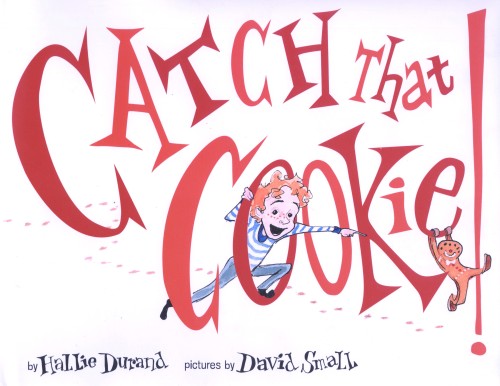
How this– the final jacket design–evolved, was a similar ordeal full of false starts, wrong turns, bad decisions, do-overs and raw nerves but we finally got it. And that, in the end, is all that matters. I’ve shown you 10 examples here, but in my archives I have at least 50 different comps for this jacket, which doesn’t count all the others that went into the trash. It now seems amazing, unusual — even weird– that it took so long to get this right., but so it goes.
BELOW: DAVID ANSWERS TO THE INTERVIEW QUESTIONS I ASKED:
When did you first know you were destined to become an artist?
When I realized I was not fit for life in the real world and that any normal employment was out of the question.
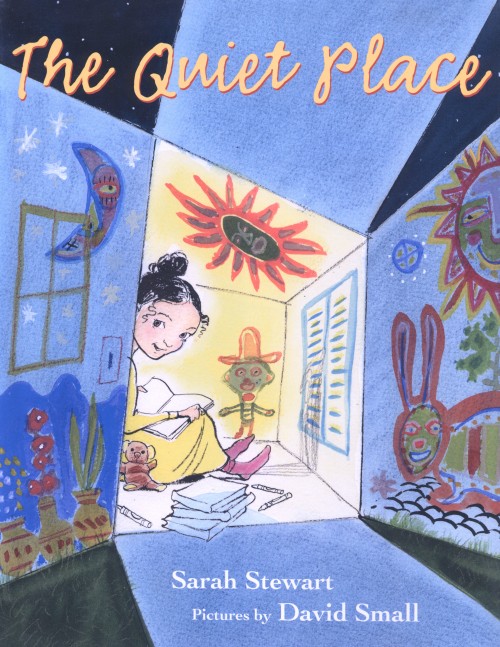
Did you always live in Michigan?
No. I’ve lived in Chicago, in Boston, in New Haven and in a small burg in Upstate New York. Also, you should know that there are two Michigans: one is called Detroit, and I’ve done time in both.
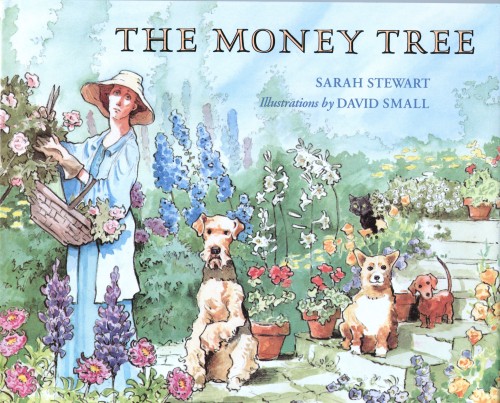
What was the first thing you illustrated and got paid for doing?
An article in the NYTimes Book Review. I was in NYC for 2 months, trying to market my first children’s book. (This was in the early 1980’s, before the Internet, when you had to be in NYC to get work there.) I went up to the Times to the office of Steve Heller, showed him my portfolio, and then and there he gave me an assignment for the Book Review. Since he wanted it the next day, I stayed up all night, working on
the floor of an empty apartment on W. 10th Street. (Some friends had loaned us their apartment while they moved into another one, and the place had no furniture except a bed and a lamp.)
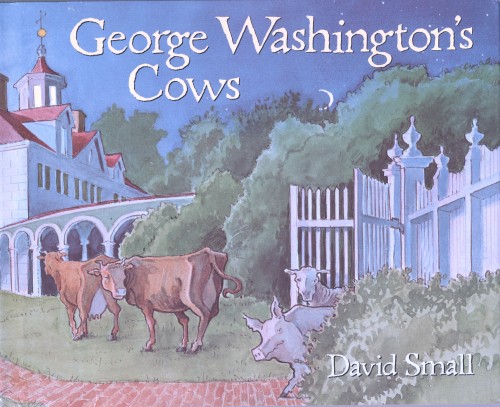
Do you feel getting your MFA at the Yale Graduate School of Art helped develop your style?
No. I had a far better art education getting my BFA at Wayne State University in Detroit, during the ‘60’s.

What made you decide to go to Yale vs. other schools for art?
I didn’t make the decision. My mentor– a Boston artist named Michael Mazur–decided I needed to go to grad school. Mike had gone to Yale, was good friends with the printmaker Gabor Peterdi, who at that time taught in the Printmaking Department at Yale, and he used his influence to get me in.
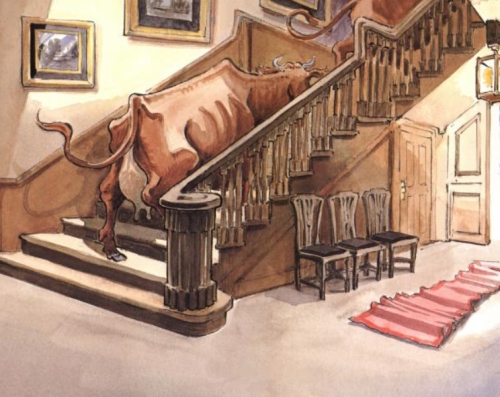
Did you have a favorite class at Yale?
Life Drawing was always my favorite class, wherever I was. At Wayne I had had great instructors in drawing the figure and Anatomy, so by the time I got to Yale all I really needed was to be left alone to continue practicing.
You may sense a certain “distant” tone when I speak about Yale? At the time I was
there, in the early 70’s, the Yale Grad School of Art was a ruptured institution, with one part of the faculty –the Traditionalists–at war with another, the Abstractionists. This tension got passed along to the students, who basically stayed hidden away in their studios, coming out only for the faculty group critiques of their work. These forums were staged in public, in an open pit, with people watching from the balconies tiered around that space. They were like gladitorial games and they always devolved into ideological screaming-matches between the professors, while students were frequently driven away in tears. I got spared these ordeals because we Printmaking majors weren’t considered actual artists.
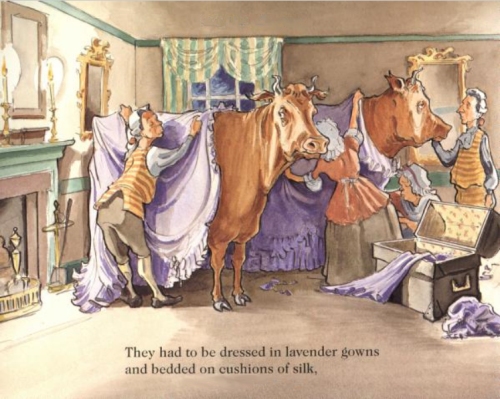
You mention in your bio that you began with writing plays. Do you think you will ever write another play?
Making graphic novels is much like play writing, and it’s even more like film-making.
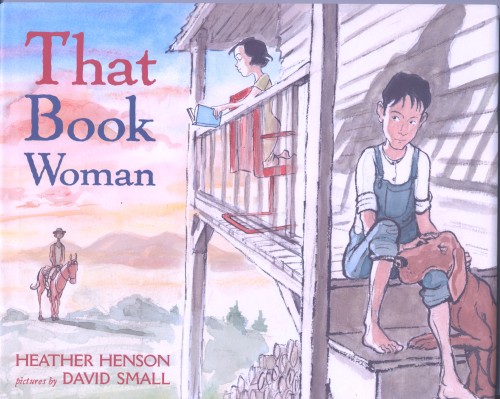
Do you feel getting your MFA at Yale opened doors for you?
Absolutely. In the world of academe, that Yale degree has genuine snob appeal. Out in the world of actual illustration, Art Directors at magazines and publishing houses could care less where you went to school. They don’t read your resume, they just look at your portfolio.
My opinion of art schools in general is they offer you two important things: 1) a place to work where you can avoid having to be out in the world while you develop your art, and, if you’re lucky, 2) possibly one or two good instructors who might encourage you. I still think the portfolio is more important than the degree.
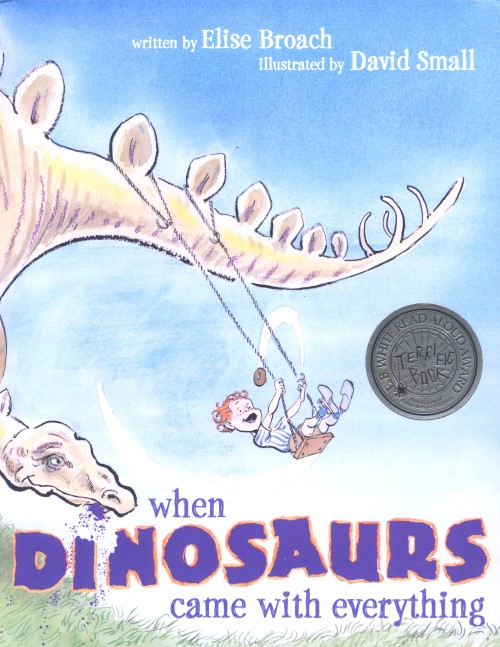
What was the catalyst for your first picture book, “Eulalie and the Hopping Head”?
My family. I grew up feeling my parents wanted to trade me in for a different model.
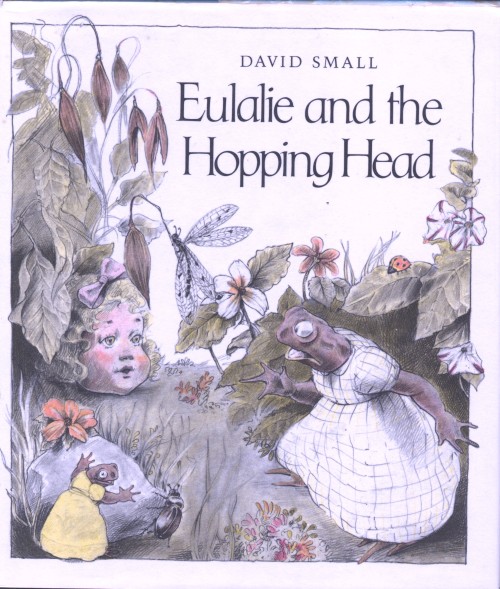
Where did you teach art? How did the job to teach art come along?
I first taught at the S.U.N.Y. college at Fredonia. I presume it was the Yale degree that put me in the running for that position, but also, my work was substantial and I interviewed well. That job lasted 7 years. I left that institution -and tenure — when I was hired at Kalamazoo College ,which had all the qualities I was looking for in a place to teach; it was small, it offered a real quality education, it had that
Georgian architecture ( the look of a little Parnassus-On-A-Hill) and –a big plus–there were very few Art majors. That meant that my students came from other disciplines like the sciences and language, and so, had other interests than flinging paint around.
After 4 years there, the Reagan Recession hit and colleges everywhere began cutting positions to save money. My position was eliminated and my wife and I –both around 40 years old at that time– found ourselves out on the street, with no jobs, no savings and no place to live. At the time it seemed like a disaster, but it turned out to be the best thing that ever happened to me. It pushed me out into the world of work. If I had stayed in academe I think I might have withered away and dried up completely.

How did you land your gigs with The New Yorker and The New York Times?
I showed them my portfolio and, to my surprise, they hired me. Then they hired me again. But there was absolutely no certainty that they would ever hire you after that. This uncertainly–to me– was exhilarating, and stillis. It’s so different from academia, where you could relax and be assured that your next paycheck would be coming in.

Do you still do illustrations for magazines?
No. Maybe things have changed now, but for the years when I worked for magazines, the work was always very interruptive, the pay was low, and it all had to be done very fast. The pace got even crazier with the advent of fax machines, overnight delivery and the Internet.
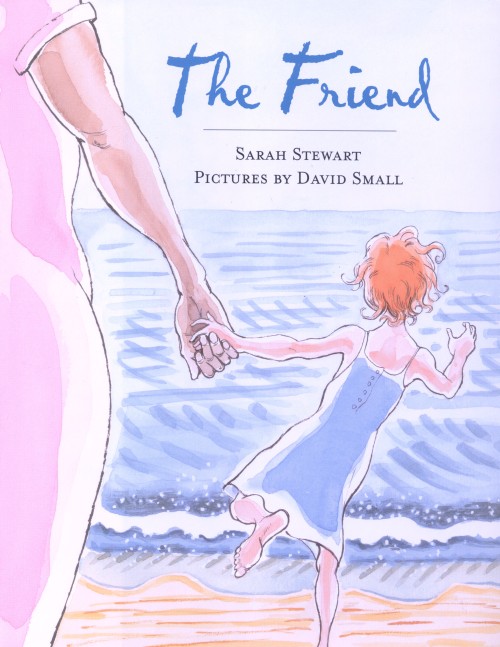
Which books of yours were recreated into animated films and musicals?
IMOGENE’S ANTLERS was made into a great little mini-musical. Weston Woods has made films of SYWTB President?, MY SENATOR AND ME, and– coming soon– ONE COOL FRIEND.

Did your illustrating and your wife’s writing bring the two of you together?
No. A mutual friend introduced us at a party and it was love at first sight. I loved her face, her intellect, and the tiny vase of live violas she wore around her neck that night. We were friends for eight years before we married.
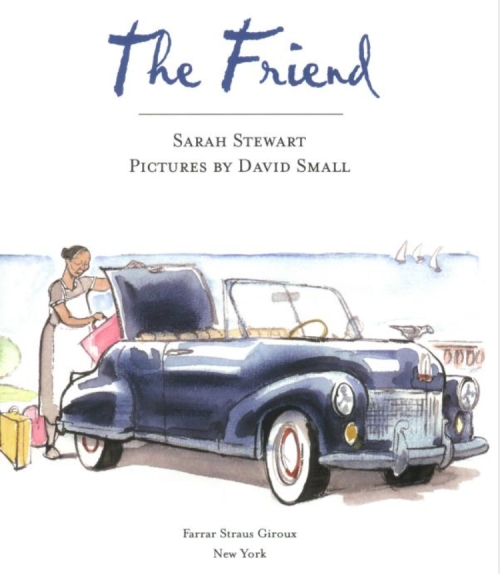
Was it fun working on “The Gardener” that your wife Sarah Stewart wrote?
The word “fun” did not enter my work vocabulary on that project The story ,as you know, is set in the Great Depression, and concerns a child whose family can’t afford to keep her. She is torn away from everything she knows and loves and is sent off to work for her uncle in the city. When I illustrate a story I have to make my own. That is, I have to find myself in it. With The Gardener, at first and for a long time, I agonized over the pain and loneliness that child must have felt. I couldn’t find any light in it. Also, I was familiar with the black and white photos from that era, of the
starving families in the Dust Bowl, of the urban bread lines … It wasn’t pretty. I decided it was beyond my powers to illustrate that story, and I was ready to turn back the contract. Then came a breakthrough.
I had a talk with Lydia Grace Finch–the gardener friend of Sarah’s on whose childhood Sarah had based her story. I asked Lydia what it was like growing up during the Depression.She said: “I was just a kid like any other kid. I didn’t know what ‘the Depression’ was; that was just life. We all had to work, of course.
We worked hard, but we also knew how to enjoy ourselves. I had a lot of fun during the Depression!”
That conversation was an eye-opener for me. I put it together with my own childhood memories of growing up young and innocent in Detroit, and suddenly things began to develop rapidly on paper. I guess, maybe, at that point it started to be fun.
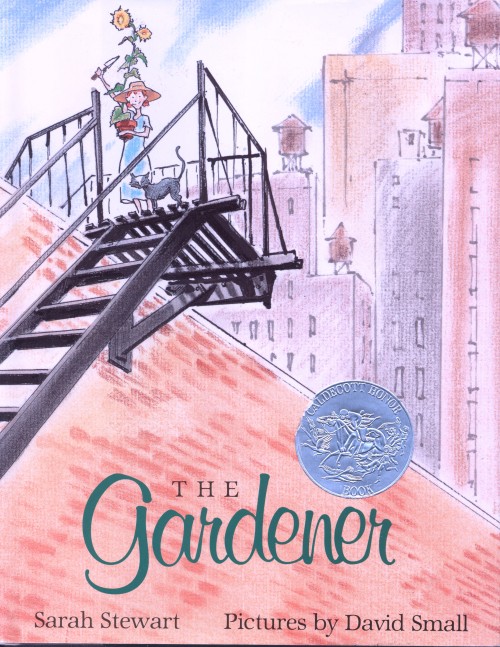
How excited were the two of you to win The Christopher Medal and receive a Caldecott Honor for that book in 1997?
Very excited and surprised as well. It was stunning for both of us, to have such a private, personal experience given such huge recognition by the larger world.
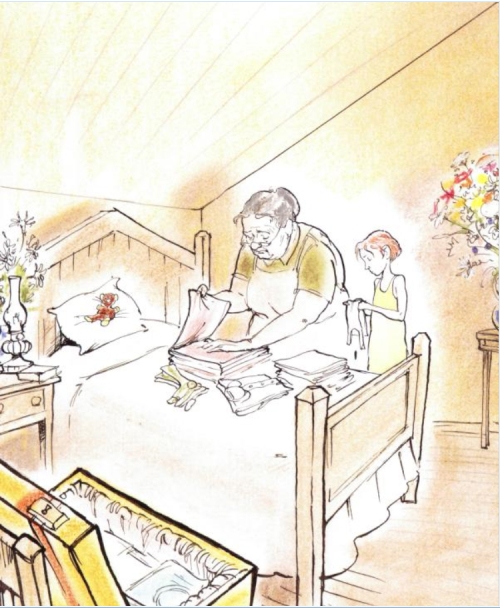
Did you see a jump in demand for your illustrating after those wins?
I suppose I did. I know I started getting offered a lot of manuscripts that resembled Sarah’s but that weren’t Sarah’s, so I really had no interest in doing them.
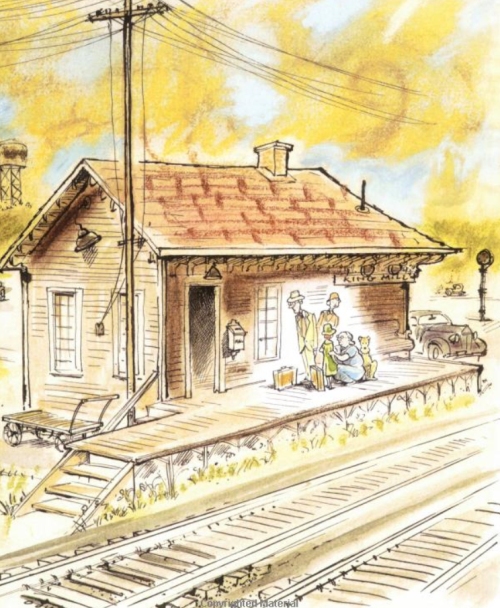
Did you have any idea that “So, You Want To Be President?” by Judith St. George would win the Caldecott?
I personally didn’t think that book would sell five copies. But, speaking of “fun?” … that book was fun to make! Maybe that’s why I had little hopes for it, because it seemed more like bad-boy misconduct than work.
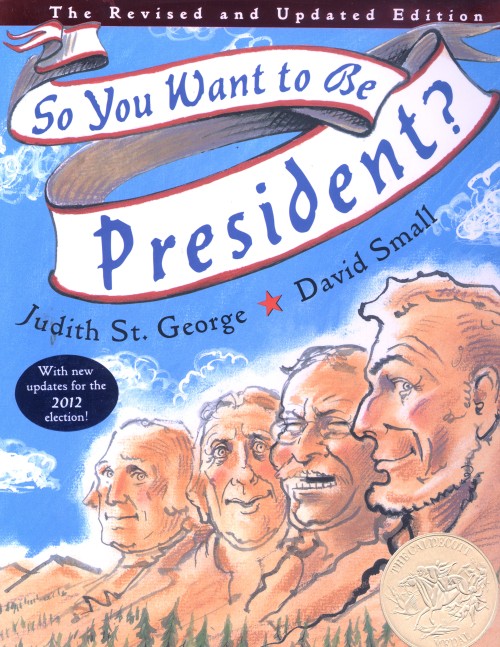
Once we realized that a Presidential election (Bush v. Gore) was coming up that very Fall, we stepped up the production schedule and I had to work very quickly; I didn’t have time to fuss and fret over every drawing. So, maybe my pessimissim about its prospects was related to my anxiety that maybe I hadn’t done a “perfect job”. (Aways a worry.)

Was Imogene’s Antlers the second picture book that you wrote? How did you find a home with a publisher for that book?
It was the fifth book I had illustrated, the second book I wrote. The editor of my first book– Alan Benjamin– had just become the Senior Buying Editor at Crown. Nobody among the higher-ups at Crown wanted to buy that book, but Alan made them publish it. He had a sense about it. He and I shared that bad-boy quality in our taste for books, but Alan was also very suave, very urbane, and could be very persuasive.
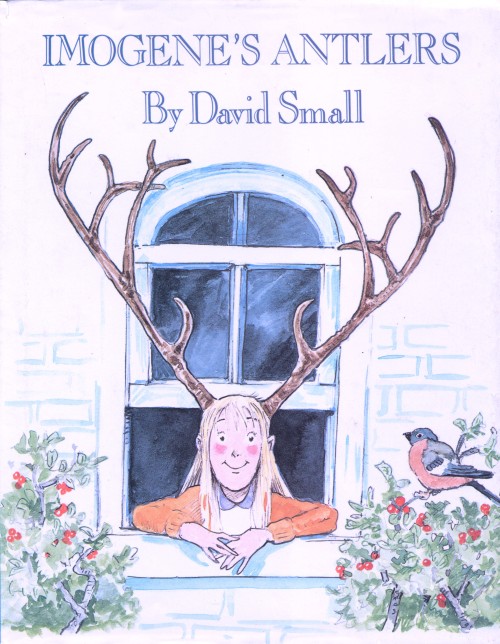
When did you meet your agent Holly McGhee?
It must have been 1997, the year she began Pippin Properties. I had given up on my search for a literary agent because all of the ones I met, for one reason or another, I had found disturbing. (One of them — a very famous kids book agent– was an outright crook. I had been warned away fromhim by several of my peers, but I interviewed him just to see if they were right. They were right. He met all red flag points on the official “How To Recognize a Sociopath” list. After that creepy encounter I had decided to go back to being agentless.
Then, Holly McGhee wrote to me. Her letter not only showed a genuine interest in– and enthusiasm for — my work, but she already had an impressive list of clients including William Steig and Jon Agee. When I met her face-to-face and found myself talking not to a self-inflated suit but to a genuine, straight-talking human being, I was convinced. I knew that she could help bring some business clarity to my life.
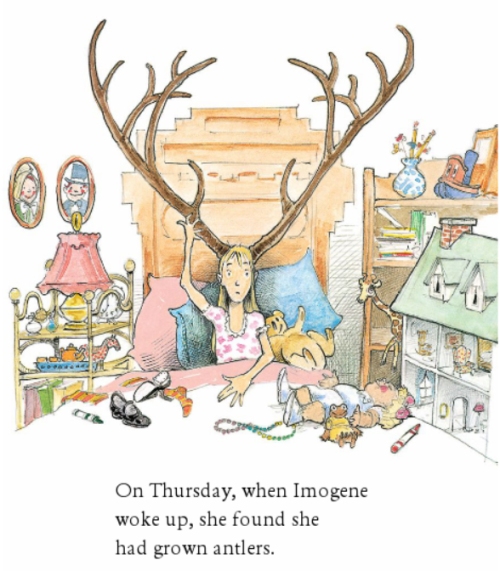
Were you Holly’s first client?
I was not the very first, but I was among them.
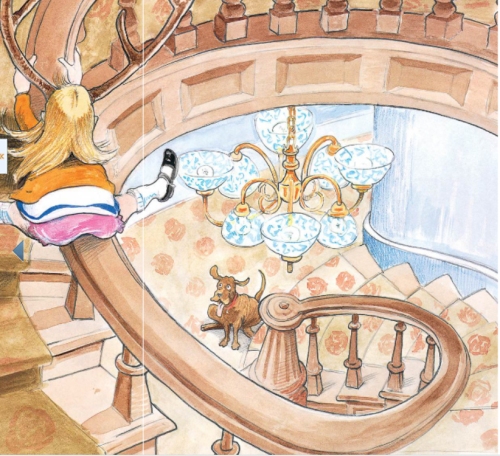
Was it hard to write “Stitches,” since it is so heartfelt?
It took me about 7 years to make that book, and yes, it was very very hard to make. But, that being said, I was driven to do it. All the false starts, all the re-do’s, the frustrations and self-doubts, the piles of material that ended up in the trash and the fifteen full-length versions (all of them different) were just things that seemed very necessary to working out a coherent story.
Holly, by the way, was very involved with Stitches from the beginning. She edited the first 12 versions of it. When we finally had it in a form she thought she could present with confidence, she spent a whole year of research to find a list of 6 editors at 6 different houses where she thought my book would fit. After that, she and the other Pips spent months putting together a presentation package. About that, Holly said, “I want this thing to be so extraordinary-looking that an editor will immediately
pop it into their briefcase and read it on the train ride home.” The day after she sent it out she immediately got 5 offers.
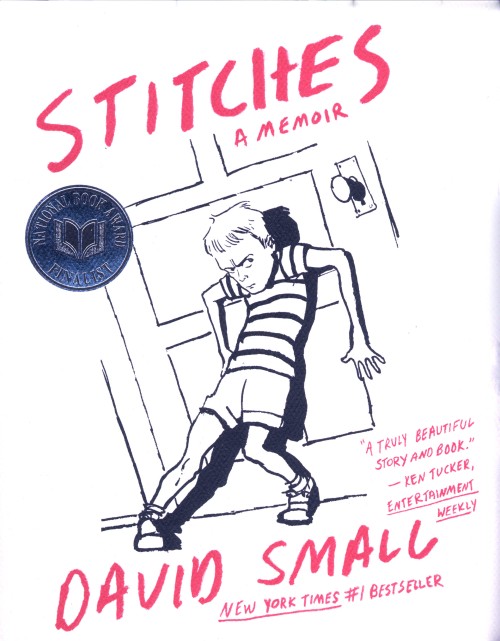
Was that your first graphic novel?
Yes.
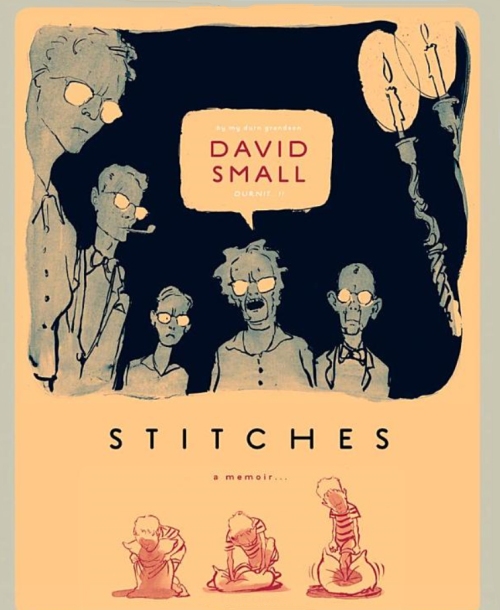
Which one of your books is your favorite?
Stitches is the book of my life, okay?–but it is in a much, much different category from the picture books. Of those, The Money Tree (by Sarah ) and my own Paper John were probably the most meaningful, because they both were pulled up from some place very deep in us both. As for the 50+ other picture books, I have to give the by-now cliched but still very-honest answer: I don’t play favorites with my children. That said, there are a few of those children who–although I wish them well– I’d prefer not to see again. You try the best you can every time, but sometimes the stars are misaligned …. something has gone wrong.
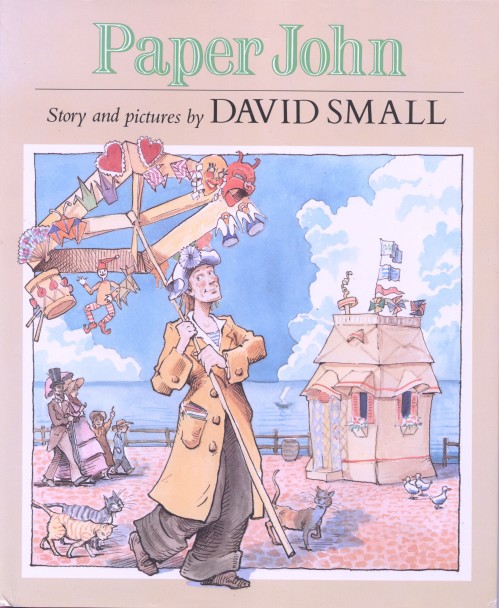
What is your favorite material to us when you do a colored illustration?
I first draw in waterproof ink, then do the color in water color and pastels.
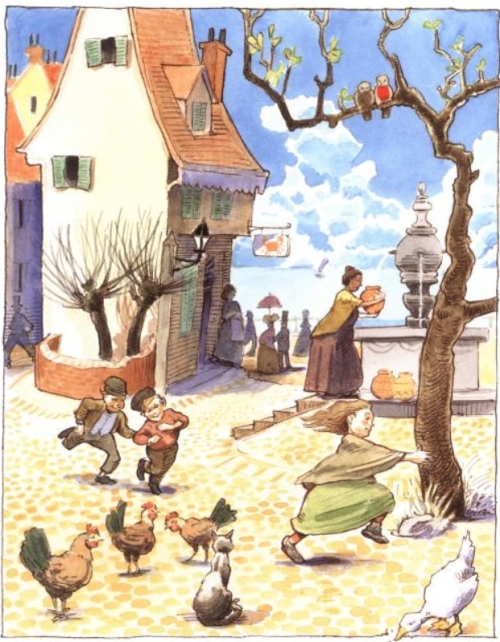
Have your materials changed since your first published book?
Yes. By the time I did So, You Want To Be President? I was getting tired of Realism and was ready for a change in both my style and materials. That was when I loosened up my drawing style, began drawing more with a brush, and working in some patches of pastel chalk, for more emphatic color.
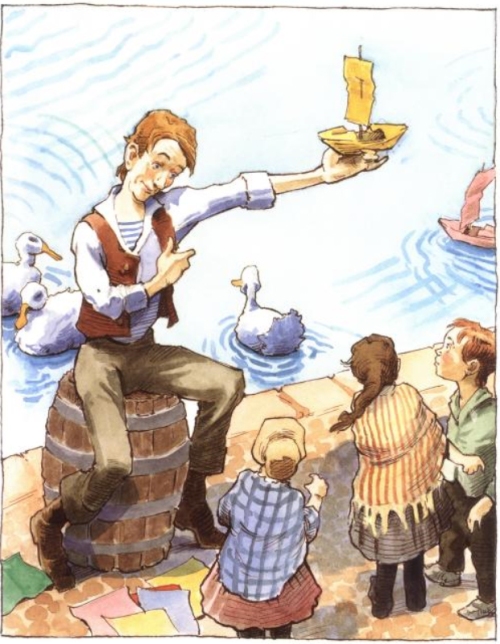
Have you tried your hand at Photoshop or drawing with a graphic tablet?
I have. Like everyone else in this ramped-up age of publishing, I was seduced by the “apparent” speed with which changes can be made with the computer, and by some of the impressive effects achieved by a few of the artists who use it. But, when I started taking Photoshop lessons I realized that I disliked more things about the medium than I liked. Most of all I missed the disconnect between the hand and the image. I missed having inky fingers and masses of art supplies surrounding me. I found out that being able to make speedy changes was not necessarily a good a thing for me: it felt strange that a drawing could be instantly evaporated into the ether, without having time to mellow and to reveal its good aspects. I should add that, when I go to an exhibit of original art I prefer to see original hand-made art, not a digital print-out. From the former I feel I’m always learning something useful about what the human hand is capable of doing, while from the latter I generally learn nothing. I also see a lot of computer artists trying clumsily to imitate the effects of
hand-drawn work. I’m not saying I’m against digitally-generated images, I’m only saying it’s not for me.
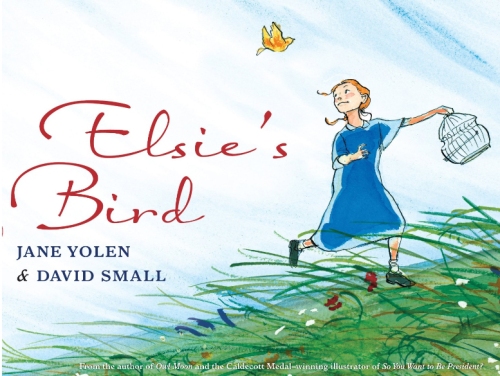
Do you spend any time promoting your work or does Holly take care of all that for you?
I spend Zero time in self-promotion. I’m not on Facebook or Twitter. Holly is my advocate, my procurer (heh) , my confessor, my confidante, occasionally (as with Stitches,) my first editor and one of my best friends. As Artistic Director of her own company now, she chooses the best artists and authors she can find, gets them the best contracts she can, and lets their work stand for itself.
Promotion is up to the publishers and their Marketing Departrments. What makes them get behind a book –or not– is always a mystery, but I have to trust them. In any case, I’d much rather have them out there, doing all that, than doing it myself. I have other fish to fry.
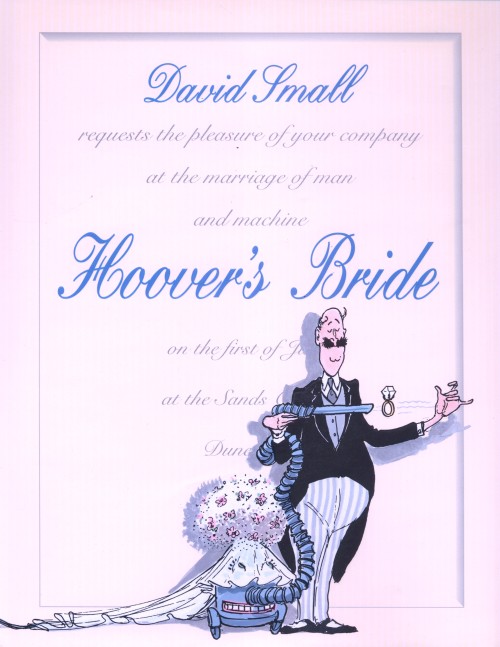
What do you feel was your greatest success?
You can have many different kinds of success. There are books that might have been commercially successful that were not, in your own opinion, so successful as works of art or literature. There are books you are very proud of from an aesthetic standpoint, which sink without a trace. There are books that have a big critical success but which, for some reason, the public doesn’t go for. I’ve had all of these.
The 2001 Caldecott Medal ceremony was the most astonishing public display of success I’ve ever experienced. I think almost everyone present, that night in San Francisco, felt that something really significant had been done by the ALA. The crowd was immense and the air was electric. There was something very daring and spirited about the committee’s choice that year. I am sure it had something to
do with the political miasma swirling in D.C. at the time, and with the sense that Judy St. George, our editor Patricia Gauch and I had delivered some straight-talk to American children about the real human beings–full of real talents and real faults — who have held the highest office in the land. So, it was an enormous thrill being at the center of all that , but what I felt mainly was a fearsome lack of words with
which to express adequate thanks to the givers.
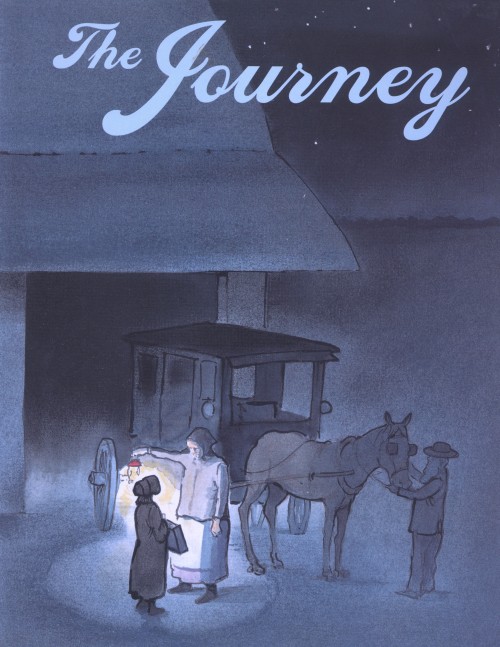
Since you have a separate studio, would you tell us a little bit about it?
We have two houses on our property. One is the house we live in, the other–a 3-minute walk along the riverbank– is my studio, which occasionally doubles as a guest house. When I used to work at home Sarah and I found the intertwining of our lives too distracting. Sarah needs absolute silence, while I need music on, sometimes very loud, when I work. Sarah likes to leave the phone off the hook, but I don’t
mind interruptions. I enjoy emails, while Sarah has never touched a computer and won’t have one in the house. Those are significant differences, but we both share a need for privacy, so having separate work spaces –when we finally got them–was a big relief. That being said, I have to tell you that Sarah never once complained while I was at work at home, but, when the opportunity came along for me to have a studio, she was on it like spots on dice.
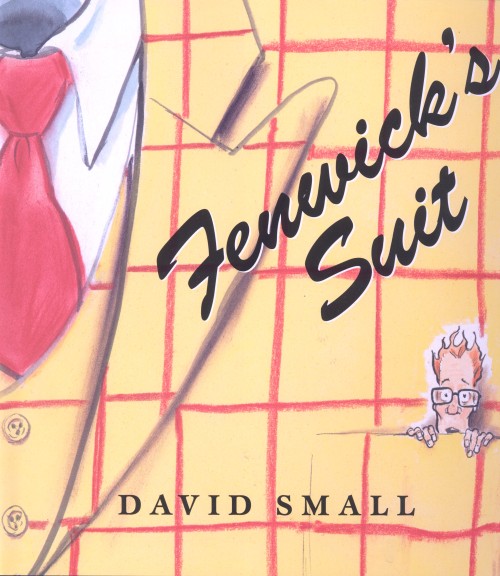
Do you try to spend a specific amount of time working on your craft?
No. I don’t have a stopwatch for the amount of time I put into my work , just as I don’t go over my Profit & Loss sheets. I pay no attention to time and I pay even less to money. If I paid attention to those things, my worries would be all about time and money. As it is, my worries are all about art.
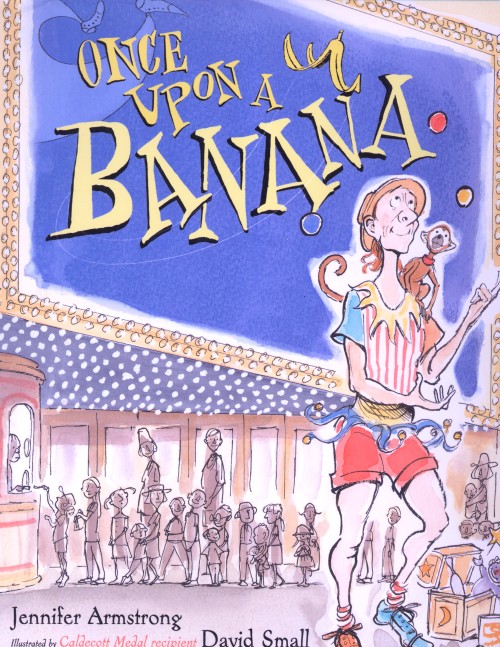
Do you take pictures or do any types of research, before you start a project?
For things like architectural styles and period costumes one must have research tools, books and the Internet. Computers are amazing tools for this, but I cherish equally my collection of books, which is big. A book is a often a better research tool, especially when you don’t know specifically what you’re looking for, you often find it by leafing through the pages.
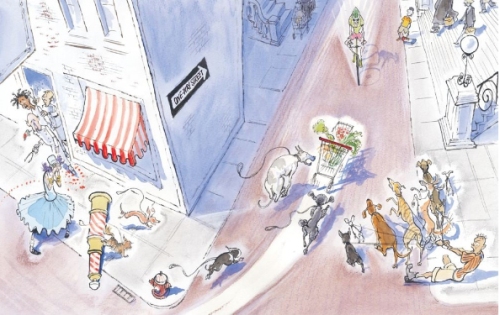
Do you think the Internet has opened doors for you?
Oh yes! I live on a prairie outside a small farming village, Population 800. There is a distinct lack of culture out here. We have a very small library, but nothing else, no museums, no theatres. Even though Chicago and Detroit are only 3 hours distant, we visit them only occasionally and for very brief stays. With e-mail I communicate daily with business friends, editors and art directors in NYC and with close friends in
Boston, San Francisco, Mexico, Paris and Brazil. It’s fantastic.

Do you have any career dreams that you want to fulfill?
I hope to keep working and to fall over into my ink bottle when I croak. If there is an afterlife I hope they have a good art supply store there.
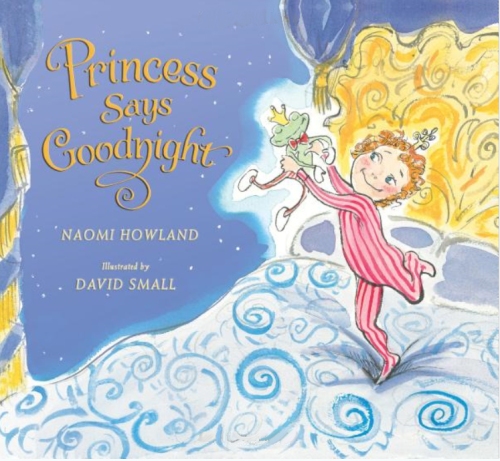
What are you working on now?
I have a book coming out with Dial this September, CATCH THAT COOKIE! written by Hallie Durand. Next year will see GLAMOURPUSS by Sarah Weeks (Scholastic, Spring 2015.) At the moment I’m working on finals for BLOOM by Doreen Cronin (Atheneaum, Spring 2016.) I also have a graphic novel in the works. That will be published by Liveright.
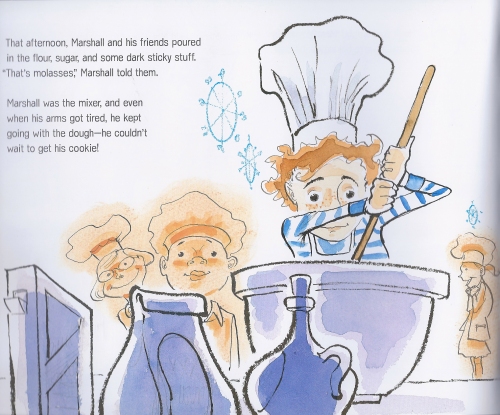
Do you have any material type tips you can share with us? Example: Paint or paper that you love – the best place to buy – a new product that you’ve tried – A how to tip, etc.
A few years ago I fell in love with a refillable brush pen made in Japan and distributed by Pentel. I buy mine from Wetpaint in St. Paul MN. (On their website store, click on Brush Pens and it will be the first item listed.) I drew most of Stitches with that pen, and I always travel with them to use in my sketchbooks.
As for”How To” tips, I have two good ones:
A. Always carry a sketchbook with you and use it. If you’re self-conscious about people watching you, wear tinted glasses and develop a “don’t mess with me” look. (You are, after all, at work, and you have to focus at all costs.)
B. If you’re learning watercolor, try to put down no more than three layers of color, the first having so little paint in it that you can hardly detect any color. This advice comes from good old John Ruskin’s “Elements of Drawing” (1857.) When I can calm my own impatient impulses and follow it, a painting usually works out beautifully. When I forget Ruskin’s tip, my painting gets muddy and has to be done again.
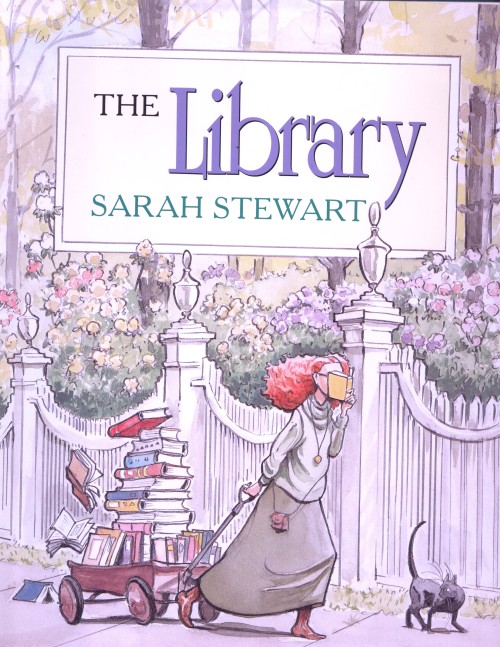
Any words of wisdom you have on how to become a successful illustrator would be appreciated?
Sure. Don’t think about being a successful illustrator. Just try being a great one. Copy the old Masters.
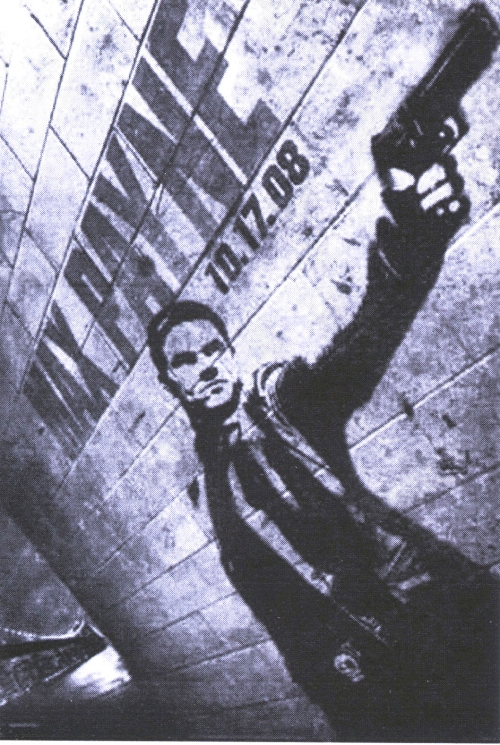
Thank you David for sharing your journey, expertise, and process with us. Good luck with CATCH THE COOKIE. I hope it is a big success.
Here is the Amazon link for anyone who wants to check it out: CATCH THAT COOKIE by Hallie Durand. Can anyone tell me who is Hallie Durand?
You can visit David at his website: http://www.davidsmallbooks.com
Please take a minute to leave David a comment. I am sure he would love to hear from you and as always, I would, too.
Talk tomorrow,
Kathy
Filed under:
Advice,
Illustrator's Saturday,
inspiration,
Interview,
Process,
Tips Tagged:
Caldecott Medal,
Catch the Cookie,
David Small,
Sarah Stewart,
Yale Graduate School of Art 

.jpeg?picon=3498)
By: Cait,
on 8/13/2014
Blog:
Cait's Write...
(
Login to Add to MyJacketFlap)
JacketFlap tags:
tips,
running,
motivation,
goals,
injuries,
training,
exercises,
stretching,
cross training,
training tips,
Add a tag
Being patient sucks. Waiting for what we want isn’t fun, but the reality is that often times we are forced to wait. Even more often is it that rushing things will ultimately leave us more frustrated in the long term.
As runners, wouldn’t it be awesome if we could just lace up and make our next race/workout/run a PR? If only, right?! The natural tendency to want those faster times and better fitness TODAY is the breeding ground for injuries, overtraining, and slowed progress. Beautiful irony there, right?
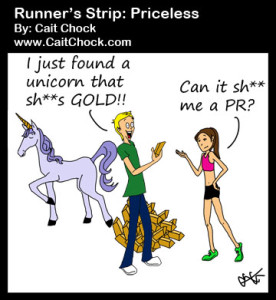
Every runner has been guilty of it, and hey, some things you just have to learn yourself the hard way. (Sometimes a few times to really NAIL that lesson home.) Being patient sucks…but we need to learn to embrace it.
Yikes. Where’s the spoonful of sugar to wash that down? Well that comes when you actually ARE patient and watch your goals materialize…eventually.
The sweetest victories only come after enough struggle and work, after all.
Convincing yourself to wait it out and be patient is tough and often an on-going battle. Incidentally a large part of being able to stay patient comes from confidence. How so?
Being patient means BELIEVING in yourself, what you’re doing, and the process. A runner who lacks confidence is the one who tends to rush things, an example of that is going out way too fast in a race. It takes MORE confidence and patience to go out controlled and then pick up the pace, and close fast. A runner who tries to ‘make a buffer’ by going out too fast is subconsciously affirming they are going to slow down. See how that’s not a good way to think? It takes more confidence to be patience, wait, and then respond to your competitors (or go faster) as the race progresses.
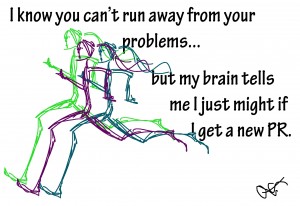
New runners can be a little less than confident in their abilities as they venture into a new sport. That’s natural, but it’s dangerous to go into information overload and want to do EVERYTHING and anything they read about training and incorporate it right away. This usually leaves them injured or too sore/tired that they lose any desire to continue running.
Even if you’ve been a runner for years and years, it’s quite easy to fall into the same trap of wanting to add in XYZ all at the same time…to rush the process. You know what, the same road leads to the same place.
Avoiding injuries and reaching your best takes time. Waiting is hard and it can suck at times, but if you try and rush things too fast it will, in the end, it will suck even more. (nightmares of time off or on the cross trainer missing your race should help keep you patient.  )
)
There really ARE tons of training elements to keep you improving and progressing through the years. This should be exciting news, it’s just imperative not to rush things.
I will say that the BEST way to stay patient and keep yourself honest on the right track (in the moment it can be REALLY hard sometimes to know you need to be patient) is to a have a coach. If not a coach then at least an educated source or training group to bounce things off of. Today it’s important to recognize the source of the training advice you’re getting and if it’s actually got merit.
Being patient can suck in the moment, but eventually it is oh so sweet.
—-
More posts on training tips HERE
Some of those ‘extra’ training elements to help you improve: CORE STRETCHING DRILLS
—-
1) How do you remind yourself to stay patient when you really don’t want to wait?
2) What keeps you honest/patient when it comes to your training?
3) When is an instance where NOT being patient made things much worse for you?

View Next 25 Posts






 Erika Wassall, the Jersey Farm Scribe here on….
Erika Wassall, the Jersey Farm Scribe here on…. 


 Sholta Walker was trained and graduated as a painter in 1988 and since 1995 he has worked professionally as a full-time artist and illustrator.
Sholta Walker was trained and graduated as a painter in 1988 and since 1995 he has worked professionally as a full-time artist and illustrator.





































 Do you own or have you used a Graphic Drawing Tablet in your illustrating?
Do you own or have you used a Graphic Drawing Tablet in your illustrating? Do you have any career dreams that you want to fulfill?
Do you have any career dreams that you want to fulfill?
 Do you have any material type tips you can share with us? Example: Paint or paper that you love – the best place to buy – a new product that you’ve tried – A how to tip, etc.
Do you have any material type tips you can share with us? Example: Paint or paper that you love – the best place to buy – a new product that you’ve tried – A how to tip, etc.




 Author of twenty-nine books,
Author of twenty-nine books, 













 David Harrington’s affinity for art began at an early age, when he enthusiastically drew on floors, walls, furniture, and other inanimate objects. A native of southern California, Harrington pursued a career in illustration by enrolling in the Art Center College of Design in Pasadena, where he earned a BFA with honors. As a student, his favorite classes were figure drawing and painting.
David Harrington’s affinity for art began at an early age, when he enthusiastically drew on floors, walls, furniture, and other inanimate objects. A native of southern California, Harrington pursued a career in illustration by enrolling in the Art Center College of Design in Pasadena, where he earned a BFA with honors. As a student, his favorite classes were figure drawing and painting. 









































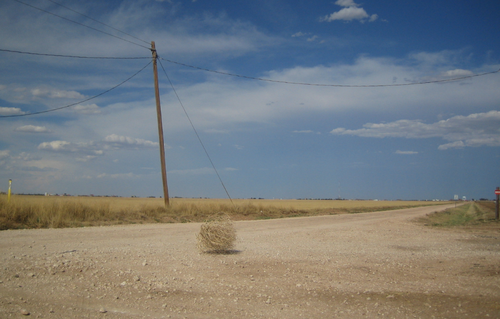



 #5: Perhaps your book is under contract, but your editor isn’t getting back to you with editorial notes, or with anything else. You want to revise, you have another book you need to work on, and you need to know what’s going on. But although you’ve emailed the editor three times to ask about the book’s schedule, you hear nothing. If you have an agent, easy, just tell the agent and he or she will deal with it. (Unless the agent doesn’t return your calls, in which case, see #2). But if you don’t have an agent, and you aren’t hearing back from your editor? Email their boss. Yup. Email the publisher, remembering to be professional and concise, saying “I haven’t had an answer to my questions about the book’s schedule and I’m getting worried that my revision might conflict with another project; of course I understand how busy my editor is, but I wonder if you have information for me?” The publisher then forwards it to the editor who deals with it immediately.
#5: Perhaps your book is under contract, but your editor isn’t getting back to you with editorial notes, or with anything else. You want to revise, you have another book you need to work on, and you need to know what’s going on. But although you’ve emailed the editor three times to ask about the book’s schedule, you hear nothing. If you have an agent, easy, just tell the agent and he or she will deal with it. (Unless the agent doesn’t return your calls, in which case, see #2). But if you don’t have an agent, and you aren’t hearing back from your editor? Email their boss. Yup. Email the publisher, remembering to be professional and concise, saying “I haven’t had an answer to my questions about the book’s schedule and I’m getting worried that my revision might conflict with another project; of course I understand how busy my editor is, but I wonder if you have information for me?” The publisher then forwards it to the editor who deals with it immediately.

 Dilys Evans has been providing advice to young artists since 1978, when she founded Dilys Evans Fine Illustration.
Dilys Evans has been providing advice to young artists since 1978, when she founded Dilys Evans Fine Illustration. 


 When Do Writers Stop Writing? by Erika Wassall
When Do Writers Stop Writing? by Erika Wassall I noticed that illustrator David Small’s new book, Catch That Cookie was hitting the bookshelves on August 14th, so I contacted him to see if he would like to be featured on Illustrator Saturday. He will be doing a book tour in September, so I’ll make sure I tell you all the ins and outs as soon as I know them. It will be a great opportunity to meet him and Hallie Durand, if they are coming to a bookstore near you.
I noticed that illustrator David Small’s new book, Catch That Cookie was hitting the bookshelves on August 14th, so I contacted him to see if he would like to be featured on Illustrator Saturday. He will be doing a book tour in September, so I’ll make sure I tell you all the ins and outs as soon as I know them. It will be a great opportunity to meet him and Hallie Durand, if they are coming to a bookstore near you.

















































Kathy, this is great! Thank you! :D
I like this seven-point structure because sometimes, the classic 15-point “beats” system seems too elaborate for a children’s book, particularly one without a “B” plot. Thanks for sharing it in such a clear and understandable way!
Reblogged this on Darlene Beck-Jacobson.
Very helpful post Kathy! Thanks.
Thanks Kathy! Went to a recent plot workshop with Mina Witteman based on Save the Cat. This is a great review!
Laurel,
I know many writers know about the 7 Point System, but sometimes we pick up things we forgot when we read something again. Or sometimes we say we are going to try something, but you haven’t tried it yet. So I am glad you let me know you thought it was a good review.
Thanks,
Kathy